BIGGER. BETTER. BRITISH.

























ALSO IN THIS ISSUE: NEWS & VIEWS ● NEW PRODUCTS ● CAUGHT ON CAMERA ● COMMENT ● AND MORE ELECTRICIAN &INSTALLER PROFESSIONAL THE BUSINESS MAGAZINE FOR THE ELECTRICAL TRADE FREETOTHETRADE JULY/AUGUST 2023 ENTER THE CPD ZONE! TEST EQUIPMENT DO YOUR TOOLSMEASURE UP? YOU COULD EARN 1X CPD CREDITTHIS MONTH
WHY THE HUDSON GROUP HAS BIGTHINGS IN STORE FOR ITS CUSTOMERS

COVER STORY
20 The Hudson Group details its successful back history in cable management solutions, and why recent developments will ensure that customers are in for something special
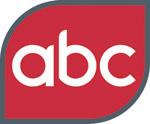
The CPD Zone
24 NAPIT’s Richard Townsend ‘codebreaks’ more of the latest reader submissions
27 The requirements for the installation of equipment in meter boxes
30 Looking at the relationship between the Electricity at Work Regulations and BS 7671
32 LS0H cable: how does it work, and how should you tackle it?
34 The importance of surge protection in complex installations
37 What changes have come into effect following the corrigendum?
38 ‘Dr Zzeus’ Tom Brookes answers a fire-related contractor query
41 Overvoltage protection: how does the corrigendum alter things?
Test Equipment & Tools
43 What are the different types of test meters available and what are the key features electricians should look out for?
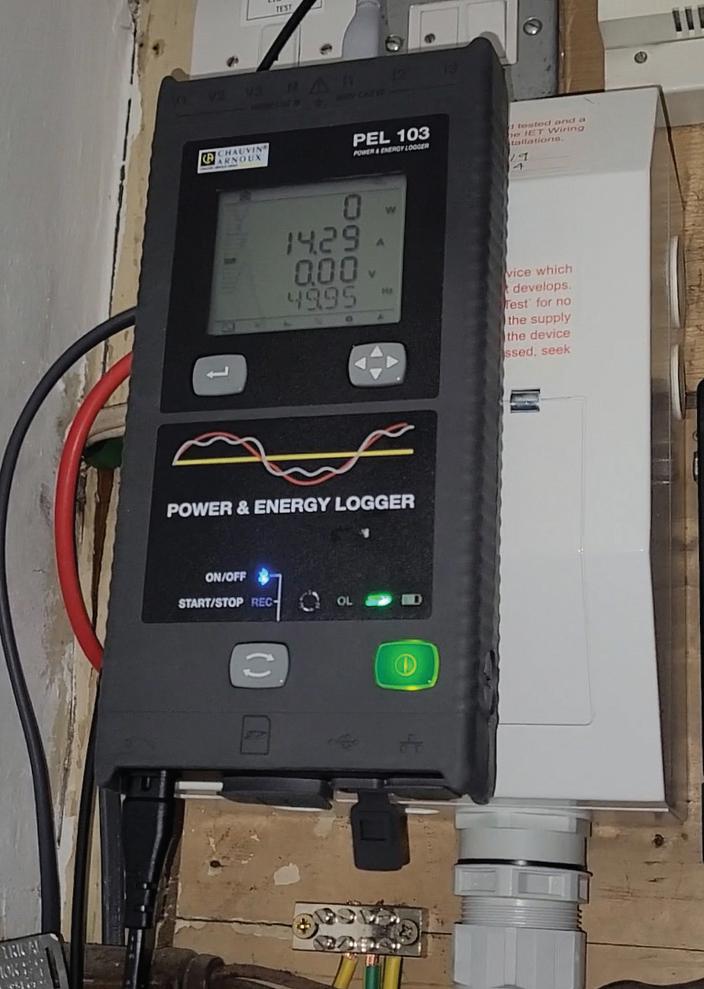
46 We visit Martindale Electric as the company celebrates 95 years in business
49 Why the advent of test equipment adapters means that you can tailor the functionality of your test system around your requirement
50 How investment in advanced PAT technology is enabling a manufacturer of custom-made personal computers to improve its safety testing protocols
52 We discover how the use of energy logging equipment helped an electrical business to save its customer a fortune in unnecessary costs
54 What are the key characteristics that test equipment must contain to help installers comply with solar installation requirements?
TotalAverage Net Distribution: 81,413 Certification period:
1 January 2022 - 31 December 2022
Products & Business Solutions
57 Top tips for staying cool on-site during the warmer weather
61 Five simple tips for trade business owners to get their company ready to bloom this summer
62 What are the implications of the ban on fluorescent lamps for contractors and installers?
64 How All LED is empowering garden owners to transform their outdoor areas into captivating and enchanting spaces
67 We put the questions to the team at BG SyncEV
68 What developments in the lighting sector have been gathering the most momentum recently?

71 Which products have been specified, and where?
72 Rounding-up the newest products, tools and equipment to help you in your work
Prize Draw
22 WIN! A Rolec QUBEV Smart charge point could be yours
Why energy logging saves time and money 52
PROFESSIONAL ELECTRICIAN July/August 2023 3 5 VIEWPOINT 9 NEWS 22 THE TRAINING GROUND 42 MADE 2 MEASURE 81 CAUGHT ON CAMERA
Regulars
July/August 2023 Volume 39 No.7
Summer solutions for the garden
64

Meet the team
Editor RICHARD BOWLER
email: pe@hamerville.co.uk
Digital Manager
REBECCA MCGEOCH
email: rmcgeoch@hamerville.co.uk
Digital Assistant
ADAM ROBERTS
email: aroberts@hamerville.co.uk
Advertisement Manager
ANTHONY SCOTT
email: ascott@hamerville.co.uk
Assistant Advertisement Manager
IAN TURNER
email: ianturner@hamerville.co.uk
Design CREATIVE UNBLOCK
Production Assistant
KERRI SMITH
Group Production Manager
CAROL PADGETT
Distribution Manager
KARL CLARK
Printed by: PRECISION COLOUR PRINTING
Published by: HAMERVILLE MEDIA GROUP

Regal House, Regal Way, Watford, Herts, WD24 4YF
Tel: 01923 237799
Fax: 01923 246901
Email: pe@hamerville.co.uk
PROFESSIONAL ELECTRICIAN is the business journal for the electrical contracting industry. It is available to the trade at leading electrical wholesalers throughout the UK. © 2023
Subscriptions to PROFESSIONAL ELECTRICIAN are available. Please contact us for rates.
Don’t fall foul of the temptation to tamper
The negative side effect of the cost of living crisis was always going to be something that would rear its head as incomes are squeezed and individuals turn to more desperate measures in an attempt to make ends meet.
As much as it is easy to understand and comprehend why households may consider cutting a few corners in order to put some pennies back in their pockets, recent reports suggest that trade professionals are being asked to carry out illegal activities in order to facilitate this.
One example comes from research conducted by Direct Line business insurance, which revealed that 43% of electricians and gas engineers (from a survey pool of 150 UK electricians and gas engineers) have been asked by clients to tamper with their electricity or gas meters to make them run more slowly.
Not only is this practice dangerous, it is also illegal, with the potential for serious consequences – including prison sentences and a maximum £30,000 fine –for those that are deemed to be culpable.
And, even if they’re not being asked directly, many electricians and gas engineers carrying out regular jobs for clients have noticed signs of tampering, regardless. Nearly a third (30%) have spotted evidence of tampering attempts while a fifth (19%) either know, or work with someone, that has also seen signs of meter tampering in a client’s home.
attempts have become relatively widespread. While times are undoubtedly hard, people should remember this is dangerous and a criminal offence, which could lead to severe consequences. No one should be asking energy contractors to perform illegal acts.
“Meter tampering also has serious insurance implications. If a property is damaged, destroyed or someone hurt as a result of deliberate meter tampering, it won’t be covered by home insurance. This also applies to Landlords with tenants who have tampered with gas or electricity meters.”
David Powell, Electrical Installation Safety Engineer at Electrical Safety First, added: “Tampering with electricity meters is not only a criminal offence – it could cost someone their life. Many people are struggling financially but it is never worth putting human life at risk. Tampering with meters exposes anyone in the household to electric shocks, burns, fire and even death.”
Clearly many households are struggling with the financial strain at this moment in time, forcing some to resort to these ridiculously risky measures. Nonetheless, should an electrician be asked, and accept, work where meter tampering is involved, they only have themselves to blame if the consequence, and subsequent damage to their professional reputation, is severe.
Image References (Adobe Stock):
Pg 15 Bar raising © Kurgu128
Pg 18 Mentor © FotoArtist
Pg 23 CPD sign © TreenaBeena
Pg 32 Train station © Vhoke
Pg 32 Cable diagram © Vectorwin
Fortunately, the research highlighted the majority of electricians and gas engineers understand the consequences of meter tampering and are alert to the need to report evidence of it.
As you would expect from electricians, there is clear evidence of the integrity that exists across the industry, with over fourin-five (84%) stating they have a good understanding of the repercussions of cheating a meter, and 83% saying they’re likely to report it if they’re confident that a gas or electricity meter has deliberately been tampered with.
Alison Traboulsi, Product Manager at Direct Line Business Insurance, commented: “It is worrying to see that meter tampering and electricity theft
Instead, sparkies should take the time to explain that their skills can be put to appropriate use by installing energy efficient products and helping to educate customers around ways they can lower their utility bills.
Although it may be tempting to earn a few quid on the side and help a customer that may have fallen on difficult times, the price that you, and they, could potentially pay would be far greater than you may have earned, and they may have saved.
Enjoy the issue, have a good summer and we’ll see you again in September.
PROFESSIONAL ELECTRICIAN July/August 2023 5
@proelectrician professionalelectrician pe@hamerville.co.uk Professional Electrician, Regal House, Regal Way, Watford, Herts, WD24 4YF Editor’s Viewpoint
Richard
Bowler
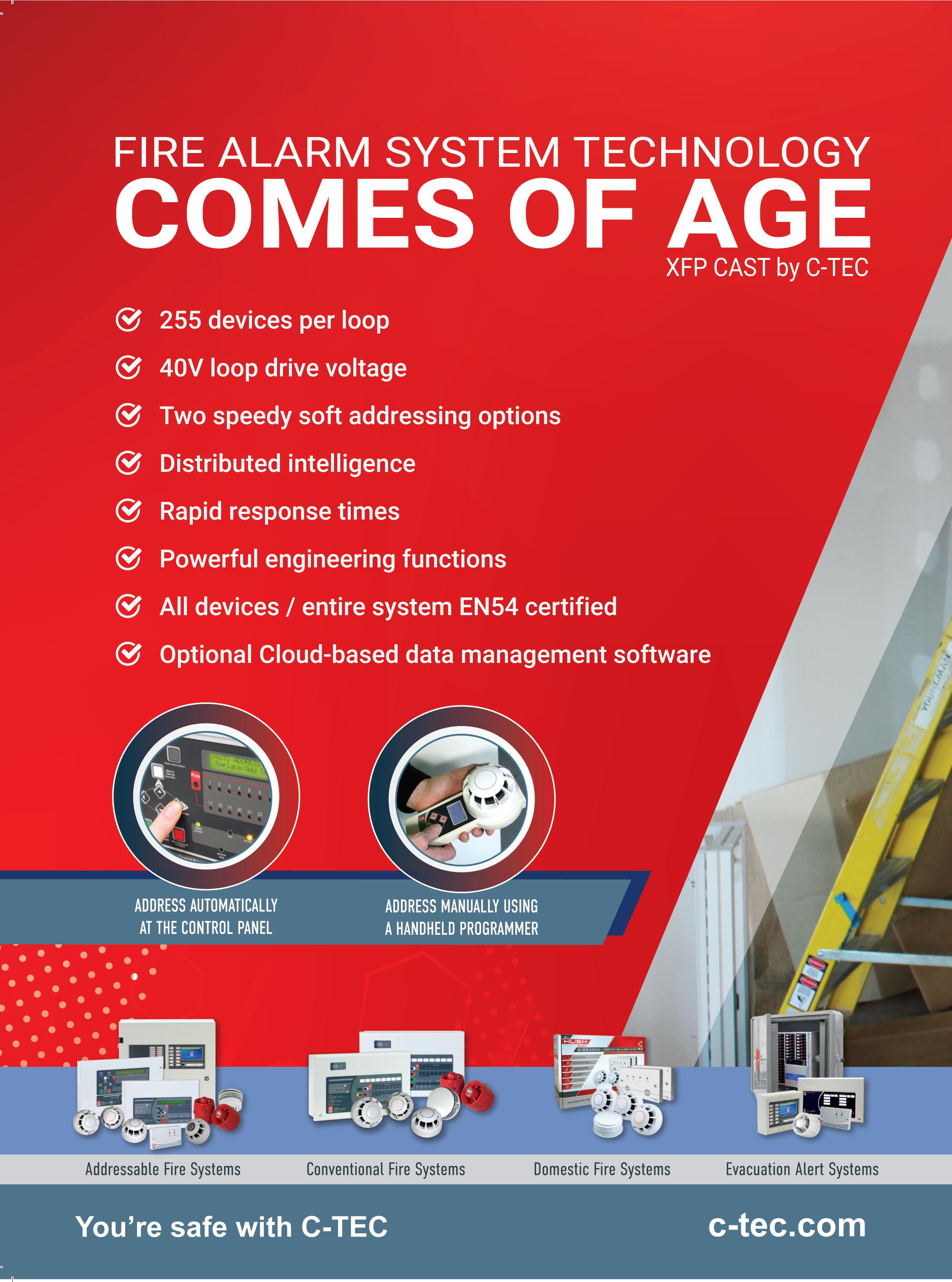
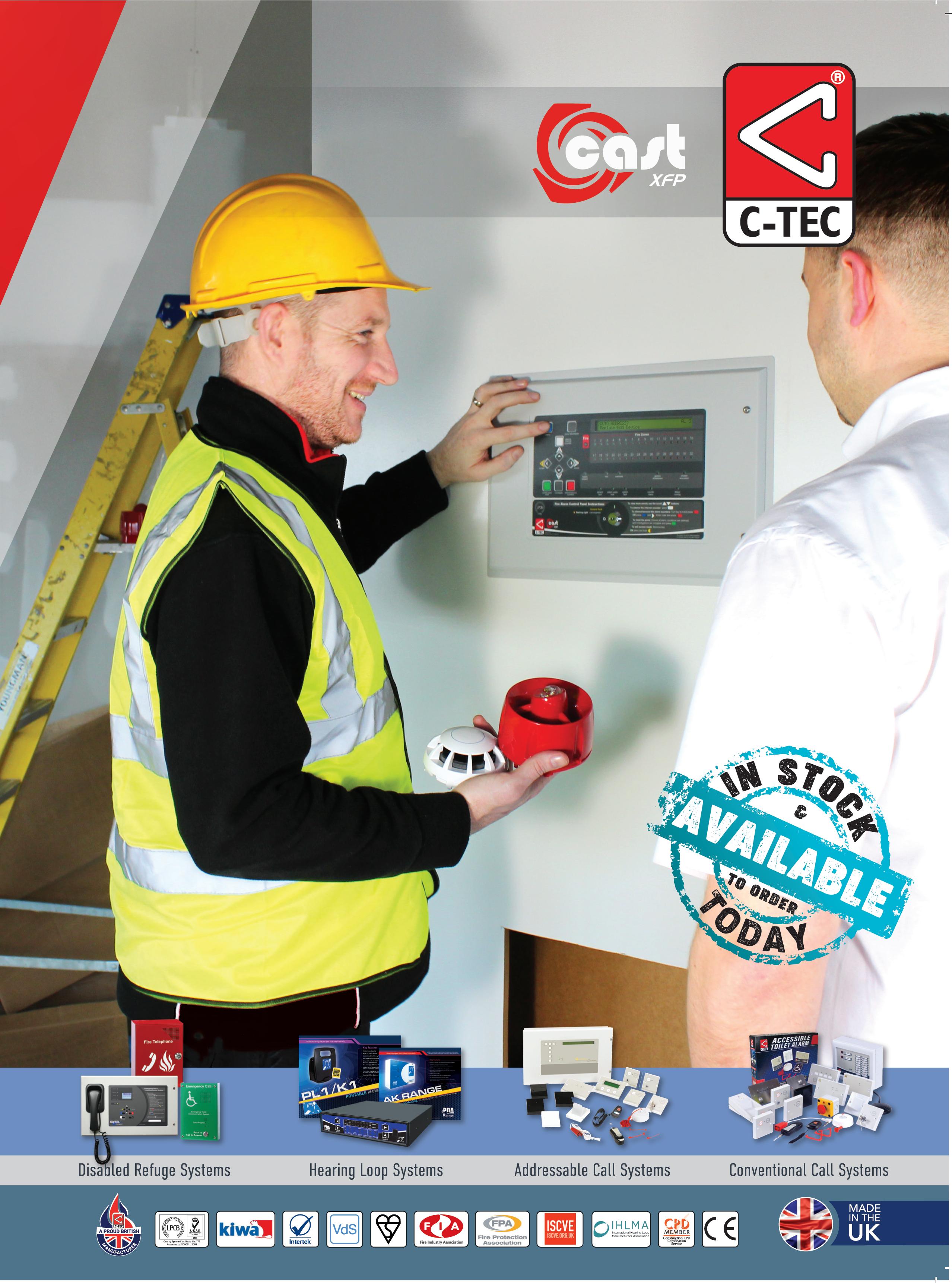

NICEIC hits the road for ‘Ask NICEIC’ UK tour

NICEIC has announced the details of the July locations for its ‘Ask NICEIC’ UK tour. Having kicked off in June, the overall route will see the brand’s custom-built tour bus visit eleven locations across England, Wales, and Scotland.
On board will be NICEIC’s top technical experts, who will be on hand to answer your questions on topics such as Amendment 2, EICR coding, EV charging and much more. Plus, for those looking to join NICIEC, the team can provide details of the application and assessment process.
Designed with contractors in mind, all planned stops will run from 8am –11.30am so individuals can drop-in when it suits.
Breakfast will be provided, along with prizes and exclusive discounts.
NICEIC’s Marketing & Events Manager, Sarah Hunter, said: “This tour is all about bringing NICEIC directly to contractors in a way which is convenient and accessible to them. The events will be informal and relaxed, providing an opportunity for our current and future customers to meet the team and ask any questions they may have. And, of course, no event is complete without food and prizes, both of which we have covered.”
Aurora introduces new on-site warranty

Aurora Lighting is strengthening its after-sales customer service with the introduction of a new on-site warranty.
For products purchased from 1st June 2023, a significant number of Aurora’s solutions will be sold with a five-year warranty; three years of which will be covered by a registered on-site warranty.
This impressive after-sales support not only offers contractors and end users peace of mind, it demonstrates the confidence Aurora has in its solutions to deliver quality and reliability.
Aurora Lighting has committed to a stringent testing and compliance process across all of its product development and manufacturing. Rigorous testing is also in place by Aurora’s in-house quality assurance team.
The on-site warranty is available on a number of commercial and industrial product solutions. In the unlikely event that a client needs to make a claim, Aurora will replace, repair or rectify products which are deemed to be defective due to a material or
manufacturing fault (please note, terms and conditions do apply).
The contractor or end-user has three months from the date of purchase to register the product and enact the warranty.
VIEW THE 3 YEAR ON-SITE WARRANTY RANGE AT: WWW.RDR.LINK/EAT002
Details of the planned route in July are:
5th July –Derby
6th July –Norwich Sweet Briar
7th July –Barking
GET MORE DETAILS OR PRE-REGISTER YOUR ATTENDANCE AT: WWW.RDR.LINK/EAT001
Winner Winner, WAGO Spinner!
WAGO has announced the launch of its biggest ever competition for electricians, offering entrants the chance to win over 15,000 prizes.
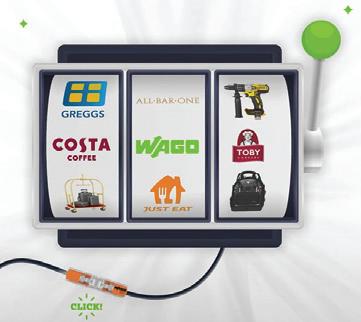



Electrical professionals simply need to purchase a qualifying pack of WAGO 221 or 2773 series connectors between now and 30th November 2023 to be eligible to win one of the amazing prizes on offer.
Prizes include the following:
● Velocity Rogue 5.0 Bag
● A Night Away for Two
● DeWalt 18v Brushless Combi Drill
● WAGO Wire Stripper
● Customised WAGO Polo
● £10 Mitchells & Butler Dining Out Card
● £10 Just Eat e-code
● £5 Costa Coffee e-code
● £3 Greggs e-code
REGISTER FOR THE WAGO SPINNER GAME BY VISITING: WWW.RDR.LINK/EAT003
For the latest electrical news visit www.professional-electrician.com news @proelectrician professionalelectrician pe@hamerville.co.uk Professional
4YF
Electrician, Regal House, Regal Way, Watford, Herts, WD24
PROFESSIONAL ELECTRICIAN July/August 2023 9
SELECT launches new membership sub-categoryto reflect EV charging demand
Campaigning trade body SELECT has introduced a new sub-category of membership to reflect the growing demand for installation of electric vehicle (EV) charge points among its members.

Scotland’s largest construction trade association is rolling out the dedicated EV membership classification as an increasing number of electrical contractors carry out the work to help Scotland meet its net-zero targets.
The association says the new classification will also help consumers find a suitably trained and competent electrician who is able to carry out the work safely and to the highest standards.
As of last month, three new sub-categories have been introduced specifically for SELECT members who undertake EV charge point installations:
● EV charging equipment installations (domestic)
● EV charging equipment installations (commercial)
● EV charging equipment installations (large scale).
SELECT’s Director of Technical Services, Bob Cairney, said: “We are aware of changes to the demands that many SELECT members encounter from consumers for certain types of electrical installation work to be carried out.
“This includes the increased demand for the installation of EV charging equipment, which is being driven by climate change targets and the subsequent popularity in low and zero-emission vehicles.
“SELECT has therefore decided to
expand its work categories to include this type of electrical installation work, with the introduction of new classifications and approvals recognising those members who are competent to undertake such work.
“We will also use this information to help potential customers find members with the necessary competence to undertake the specific work through the ‘Find a Member’ search facility on our website.”


GET MORE DETAILS ABOUT THE NEW MEMBERSHIP CATEGORIES AT: WWW.RDR.LINK/EAT004
Take a bite of the Big Apple with Schneider Electric promotion
Schneider Electric is running a once in a lifetime promotion for electricians and contractors, which is available at all participating distributors across the UK and Ireland.
To celebrate the 10th anniversary of the brand’s KQ Line of distribution boards, electricians and contractors in Britain can be in with a chance of winning a trip to New York!
In the UK, the promotion will be available for all electricians or contractors that spend £100 or more on any Schneider Electric products. Each participant will be then given a unique scratch card with a code that automatically entitles them to a £5 Starbucks gift-card and one entry to the grand prize – a trip to the Big Apple.

In Ireland, the entry requirements remain the same, but prizes will instead be a gift card for Insomnia coffee, and a €1,000 holiday voucher – free to visit a
country of the winners choosing!
The offer is running until the end of August, and the lucky winner will be drawn in September.
Grand prize details (UK only) are as follows:
● New York 7 Days for 2 Adults + £1,000 Spending Money:
● Direct Return Flights from London Heathrow
● 4* Hotel in Manhattan (centrally Located) – 6 Nights – Room Only –Standard Room
● Return Private Transfers Included
● £1,000 Spending Money (total)
● Statue of Liberty and Ellis Island Excursion
● New York Pass per person for three Attractions, choose over 95 options, including Empire State Building, Top of The Rock, Big Bus Tour, Central Park Bike Tour and 9/11 Memorial & Museum and lots more
FIND OUT HOW TO ENTER THE PROMOTION BY VISITING: WWW.RDR.LINK/EAT005 10 July/August 2023 PROFESSIONAL ELECTRICIAN For the latest electrical news visit www.professional-electrician.com news @proelectrician professionalelectrician pe@hamerville.co.uk Professional Electrician,
House,
Way,
4YF
Regal
Regal
Watford, Herts, WD24
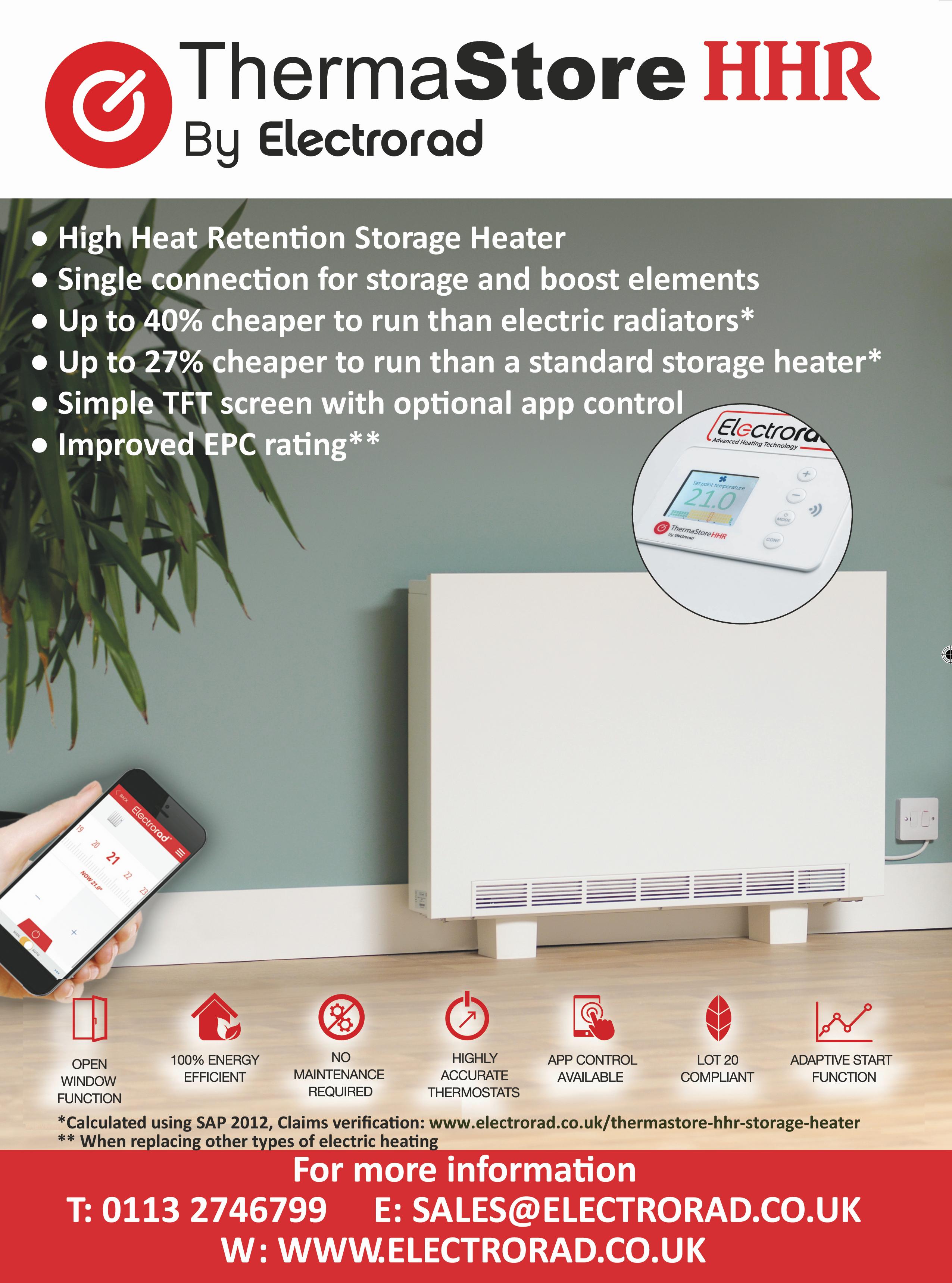
Your Epic Home App launches to support electricians
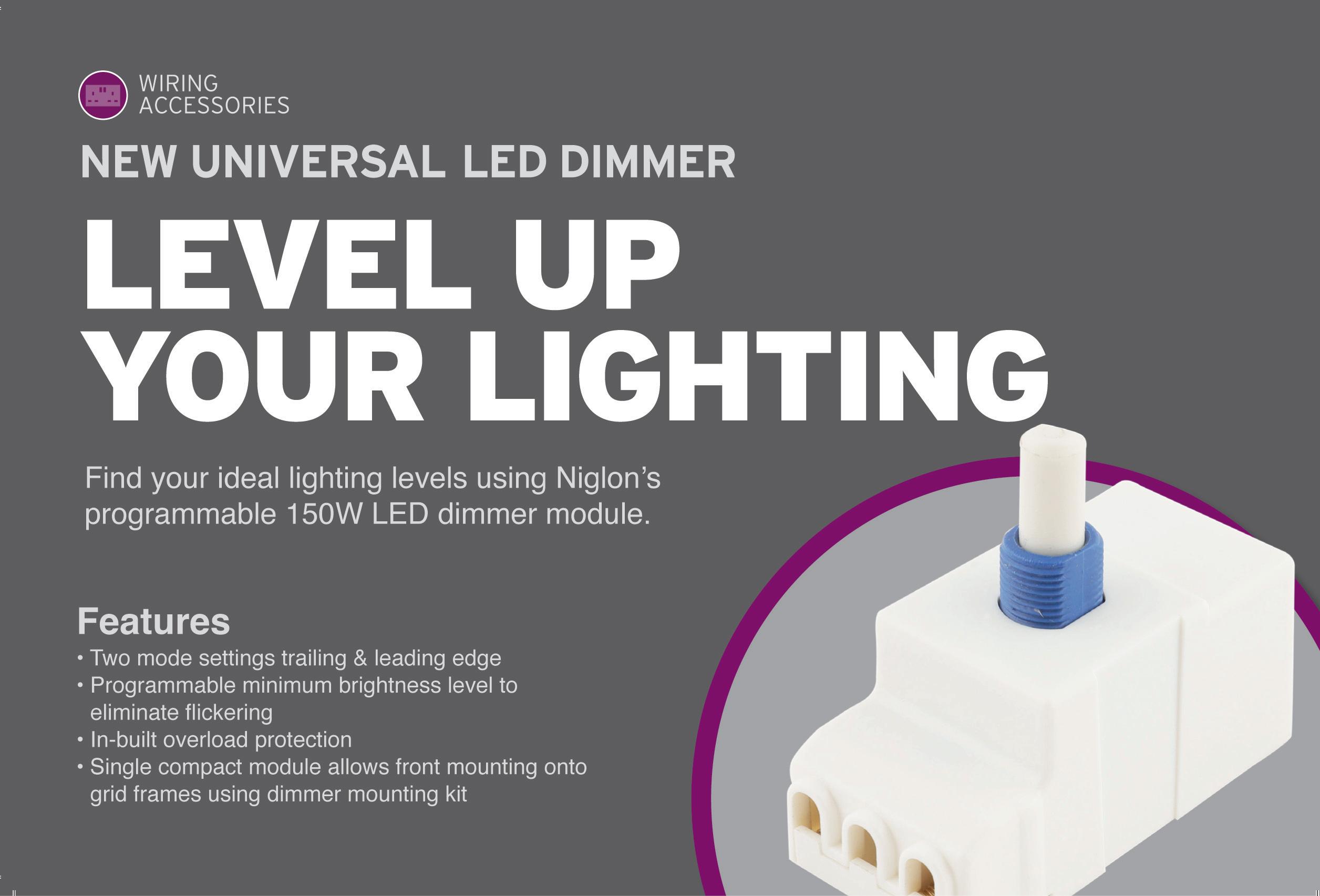

A brand new App has been released by Your Epic Home, offering homeowners, landlords and contractors the opportunity to better control their home servicing needs.
Whether you’re an electrician, plumber, gas engineer, EPC Assessor or Floorplan surveyor, you can introduce your current book of existing customers to the YEH App and they’ll be able to keep all their invoicing and certifications in one easy to use App. And best of all, whenever they need a job doing, you’ll be first to hear about it as their chosen contractor.


What could be easier than turning up to a job on an agreed day, with the kit already on-site, and the customer has already a pre-approved payment? All you need to do is fit the kit, fill out the in App
certificate, sign off the job and you’re done!
You’ll be paid in a matter of days after completing the job and all CIS is taken care of, so you have no need to worry about getting home from a long day and worrying that you still need to do invoices and certificates, as this would all have been done whilst you were on-site.
The YEH App is free to download and use. Sign up as a contractor and it’s simply a case of waiting for the jobs that you want to undertake to arrive, or you can even use the facility to fill the gaps in your diary throughout the month.
For the latest electrical news visit www.professional-electrician.com news @proelectrician professionalelectrician pe@hamerville.co.uk Professional Electrician, Regal House, Regal Way, Watford, Herts, WD24 4YF
DOWNLOAD THE APP FROM THE APPLE STORE AT: WWW.RDR.LINK/EAT006 DOWNLOAD THE APP FROM GOOGLE PLAY AT: WWW.RDR.LINK/EAT007
JTL reaches out to employers with Just the Job! campaign

JTL is reminding employers that apprentices can bring new talent and skills into their businesses with the launch of its new campaign.

The Just the Job! initiative highlights the benefits that an apprentice can bring to businesses, particularly those in the building services engineering sector. Offering apprenticeships across the electrotechnical and mechanical engineering services sectors, JTL trains over 8,000 apprentices each year and works with over 3,800 businesses. Each apprentice is equipped with training relevant to modern standards in installation, safety, and technology, delivered at around 75 colleges throughout England and Wales.
Employers that take on a JTL apprentice receiveadedicated training officer to
manage the apprenticeship process from the initial appointment throughto completion, and all JTL apprentices are supported with learning resources and provided with a free toolkit for their workplace.
Hayley Tabberer, Employer Campaign Manager at JTL, said: “Our new campaign reminds employers of the benefits of taking on an apprentice and how JTL can ensure that this process is simple, efficient, and effective for everyone. Our system of care starts with the matching of a learner to an employer and continues all the way through to the end of their apprenticeship journey.
“We really believe that taking on an apprentice can do wonders for a business, particularly as apprentices trained in modern, green technologies become more commonplace.”

GET MORE DETAILS ABOUT THE CAMPAIGN AT: WWW.RDR.LINK/EAT008

RAISING THE BAR
The electrical industry is changing – and quickly –because of the speed of technological advances, and also the crucial role the sector will play in getting the UK to reduce carbon emissions. Here we bring together three figure heads from the industry, Paul Collins (PC), Martyn Allen (MA) and Mike Smith (MS), respectively Technical Directors of NICEIC, Electrical Safety First (ESF) and Electrical Contractors’ Association (ECA), to discuss the changes required and how raising standards will benefit all.
QWhy is it so important that standards improve in our industry, and what actions have been taken already?

MS: One piece of feedback we get as an association – and I know NICEIC does too – is that (contractors) who run a quality business feel let down by the industry and government failing to level the playing field. Other people are allowed to undercut them, to cut corners in training and standards, and to deliver a substandard service.
A lot of time and effort has gone into the Trailblazer initiative and apprenticeships, but we’ve also had years of deregulation and the route to many trades has been through short courses. That has undermined apprenticeships. A lack of regulation led to a ‘Wild West’ approach to training and qualification.
Competence and qualifications have been ongoing issues for many years, but the Grenfell Tower fire raised the issue of competence in the public’s eye and prompted the government to appoint Dame Judith Hackitt to compile her report.

That has brought this and other built environment related industries together. There’s now the Industry Response Group and lots of working groups under the Steering Group on Competences for Building a Safer Future.
Industry bodies have also come together with the EAS (Electrotechnical Assessment Specification) to define what
competency looks like. It’s not just about individual competence – we have to look at organisational capabilities and management. We’re almost there, but this year we need to pass that across to the regulator and the wider industry, to ask if it fits with what everybody else is doing.
PC: It started before Grenfell, but work we’ve done with ECA and ESF has accelerated change. The EAS has been evolving over a number of years as government policy and competence schemes feed into it. There’s a lot of work going on to update competence requirements, for high-risk buildings and energy storage systems, for example. It feels more joined up now; there’s been a lot of work done between us and other organisations to set standards.
MA: Grenfell meant that every trade was expected to have a look at what they could do better. The electrotechnical sector was doing this before, but perhaps not at the same pace or with so broad a remit.
We’re doing what we can to improve standards in the regulated space, but we’ve also got consumers doing work themselves. For example, there are loads
PROFESSIONAL ELECTRICIAN July/August 2023 15 special report
As the electrical industry, and indeed the world around us, continues to evolve at pace, three leading figureheads share their views on the electrotechnical sector and its future direction.
“A lack of regulation led to a ‘Wild West’ approach to training and qualification”.
of ‘how to’ videos out there, some not so bad, some not great at all. We spend a lot of time encouraging consumers to get a professional in, but we can’t stop them having that work done by somebody else.
Very few cases come to court for poor quality work. We need stronger enforcement and the more we can do to lobby government to get more powers so we can take action, the better. Legislation around mandatory electrical safety checks has already come in for the rented sector pretty much throughout the UK now – Northern Ireland will get there this year, we hope.
Then you’ve got the drive to net zero. We’ve got EV charging points, we’ve got EVs having to be the only new cars you can buy from 2030. You’ve got electrification of everything, including the way we heat buildings. There will be lots of opportunities in electrotechnical, but we also have a skills shortage, so we need a big drive to get more people into the sector.
PC: Technology is evolving very quickly. If electricians don’t move ahead with that, someone else will do all the technology aspects and leave the electrician behind. But you’ve got to be competent to do that work. You’ve got to have the right skills, the right experience and the right knowledge to do it correctly. If you don’t, it gives the industry a bad name.
MA: That’s why we need robust enforcement. We also need an education programme, to make sure people are aware of the need to get competent people to do the installations. But also, if people are exploiting consumers, they must be taken to task.
MS: One thing we haven’t mentioned is issues in the supply chain, (with) substandard equipment. The temptation is for contractors to cut corners and buy cheap products. That undermines safety, never mind the quality of installation.
MA: We spend a lot of our time lobbying for changes to the online marketplace space. There’s a (government) review of the product safety landscape due out soon, but there is no regulation for third-party sellers of electrical goods. Contractors must make sure they buy only from reputable sources they know and trust.


MS: With net zero, we’re educating contractors about the opportunities, the skills needed, training that’s out there already, plus roadshows, webinars, face-to-face meetings with our branches. You’ve got to have that technical knowledge and understanding.

Where do you go for this information? Some of it is provided by ESF. For support, contractors would look to the trade association, to find out about opportunities in the marketplace. And then, how do I get the accreditation that my business deserves, so that people know and trust us as a business? That’s where organisations such as NICEIC come in.
PC: We can offer assessment and certification of businesses doing the work, as well as providing training. When changes come along, we add to EAS and make sure the businesses are aware of it: we do a lot of communications and feed it out via the assessors, podcasts, webinars and the like.
MS: I think there’s a concept we have to get across: that CPD (Continuing Professional Development) is part of a lifelong learning curve. We have to continually update and learn. And to earn the trust of our customers we have to be able to prove we’ve done that.
I’d like to drive out the unregulated part of the industry. I want registration of companies and certification to standards that we all adhere to and that customers can trust; so that we have an industry that doesn’t need policing by a regulator, because it is a high-performing, high-quality industry.
special report 16 July/August 2023 PROFESSIONAL ELECTRICIAN
Mike Smith
Paul Collins
“Very few cases come to court for poor quality work. We need stronger enforcement and the more we can do to lobby government to get more powers so we can take action, the better.”
Martyn Allen

LEAN INTO LOcAL LEARNING

Telements of political decision-making to UK regions.
In recent decades the nations of Scotland, Wales and Northern Ireland have become more autonomous, of course, but regions in England are also gaining more control and spending power – including over segments of training and education. One example of this policy is the development of Local Skills Improvement Plans (LSIPs). There are 38 of these programmes across England, and the key objective is to empower local employers to influence decisions about local training needs.
Significant support

The government has allocated around £2 million per area to fund improvements and changes to local colleges so that they can provide young people and adults with the skills most needed in each area, based on the LSIP. ECA has been actively engaged in many of the regions where these programmes operate, highlighting the requirements of our members and their businesses.
Furthermore, local skills devolution is spreading across the UK. In England, some of the Mayoral Combined Authorities already have power over local adult education decisions, and some Local Authorities are also starting to gain greater control over adult education policy and budgets.
The significance of this fuller version of devolution is that it gives access to far greater funding levels, which can amount to tens of millions of pounds, creating much more potential for bringing about the sort of changes that benefit learners and local businesses.
Apprenticeships in demand
It’s important to note that this devolution process in England does not directly affect apprenticeships, which remains in the control of the central government. ECA members will know that the electrical apprenticeship is one of the most successful and sought-after apprenticeships. It has the highest take-up of any construction trade apprenticeship in England and typically represents at least 20% of all construction apprenticeships. However, while the electrical apprenticeship scheme in England attracts an average of 5,000 to 6,000 new people to the sector each year, that’s not enough to meet our needs either now, or in the future. ECA estimates that we need some 10,000 new starters in our sector in England (12,000 in the wider UK) every year to keep up with sector demand and to replace those changing careers or retiring.


SPECIAL REPORT 18 July/August 2023 PROFESSIONAL ELECTRICIAN
Director of Workforce and Public Affairs, explains why devolving the design and funding for certain types of training in England is an opportunity for electrical professionals to influence outcomes in their local areas.
The low-carbon challenge
And as the UK transitions away from fossil fuels to an electrified low-carbon economy, the opportunities for businesses continue to grow. However, we need qualified people to reap the commercial benefits.
There is no doubt that many young people are attracted to a career as an electrician, but the number of apprenticeships available doesn’t match the demand. Various colleges have been dropping the delivery of apprenticeships and opting for full-time electrical courses, which are generally shorter and entirely classroom based.
Unfortunately, students graduating from a full-time course that may take one or two years then face the reality that they are not qualified ‘electricians’. And research for the LSIPs shows that average progression rates from a full-time electrical course into an electrical apprenticeship are less than 10%.
So, although the colleges report high
levels of employment after their electrical courses, it’s not usually as an electrical apprentice. Many local authorities are also frustrated when they realise they are funding the courses but not getting suitably qualified ‘electricians’ as the end result.

Solutions to the issues
The ECA believes that within this problem lies a solution. If colleges and students can be better supported through closer relationships with local employers, it could be possible to make a smoother transition from a full-time college course to an apprenticeship. The electrical apprenticeship highlights the importance of treating each candidate on their own merits, particularly giving due credit for learning they have already undertaken.
By taking this learning into account, apprenticeships could be accelerated and made more attractive for smaller businesses to support, helping to increase the number of people joining our sector as qualified,
and ultimately competent, electricians.
Engagement between businesses and local colleges through programmes like LSIPs is vital for this to work. ECA research shows that there can be demand for different skills across regions. With this approach, businesses have the potential to ensure that local colleges are running courses that match certain regional requirements.
At a national level, ECA has set the tone by engaging with the design and delivery of T Levels that are relevant to our sector and which can help young people transition to an apprenticeship. Local training solutions can, however, only be designed and delivered locally, so engagement from businesses with their regional training arrangements is vital.
In addition, the roll-out of devolved adult education budgets and delivery is picking up pace, providing a further opportunity to influence the future skills base of our sector.
BIGGER, BETTER,BRITISH.

When it comes to cable management there’s no such thing as a standard project. Contractors frequently need support and flexible solutions to complete projects on time and budget. It is this need for extra support that has seen the Hudson Group grow into a significant British manufacturer over the last 30 years and will, according to the company, spur them to further success in the decades ahead.
The business started 30 years ago as RMS. It worked with different suppliers as a specialist cable management wholesaler. After a few years, the team realised that it needed dedicated manufacturing for cable containment that could provide the support and flexibility for the projects that they were involved with.
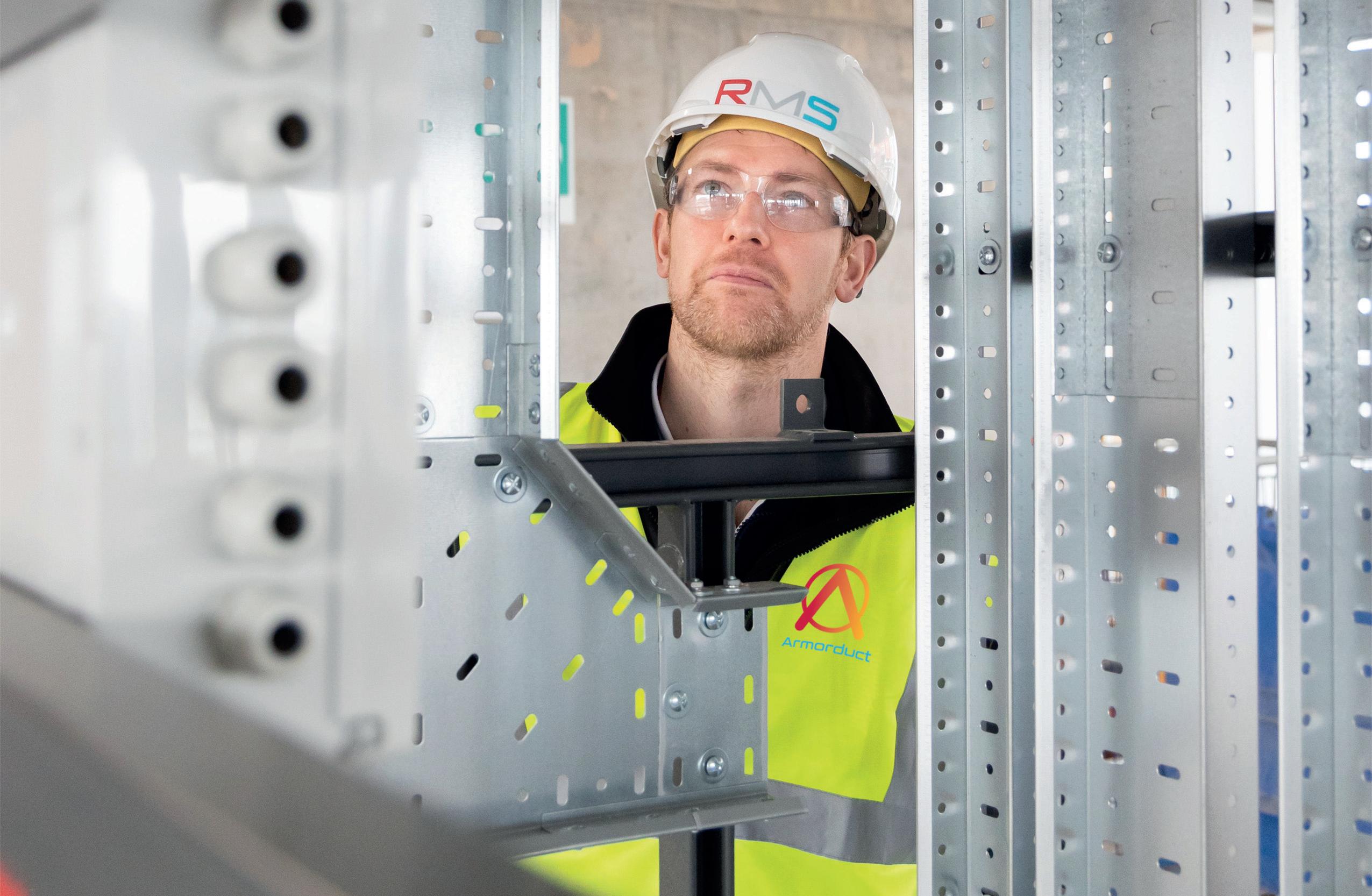
And so, 25 years ago Armorduct was born as its manufacturing facility for trunking, tray, floor systems and bespoke specials. It was, and still is, the brand’s capability and willingness to produce “specials” that makes it stand out. It could be for anything from modifying standard products to designing and producing bespoke designed solutions.


Fast-forward to today and both of these businesses have their own specialisms. RMS provides expert modular and offsite fabrication services for demanding, fast install cable containment solutions and Armorduct designs and manufactures high volume standard and bespoke steel cable management systems which include cable trunking, tray, basket and floor boxes.
Future plans

This year Hudson has launched a third specialist cable management company within the group. Milton Cable Management Systems is working in partnership with the Wibe Group to help relaunch and support another brand steeped in history – Mita. Like its two sister companies, Milton will have its own specialist area, in this case supplying Mita GRP cable containment for corrosive and hazardous environments.
Looking forward, Simon Hudson-Smith, CEO of The Hudson Group, says: “The reason for our success is simple, we provide the contractor with exactly what they need from a cable containment system. We’ve designed our business to be responsive for everyone, whatever the size of your project; whether it is an industrial unit refurb or the largest offsite prefabricated modular electrical and
COVER STORY
20 July/August 2023 PROFESSIONAL ELECTRICIAN
its successful back history in cable management solutions, and why recent developments will ensure that customers are in for something special.
“At our heart we are an approachable company. Many of us have worked as electricians so we know what you need. Because we’re a UK manufacturer with stocks on hand we can deliver to our customers quickly.”
building services solution in Europe.

“At our heart we are an approachable company. Many of us have worked as electricians so we know what you need. Because we’re a UK manufacturer with stocks on hand we can deliver to our customers quickly.”
Time saving
It is this approachability that has structured the organisation. So, for example, Armorduct has a specialist section within its manufacturing facility that is dedicated to producing bespoke items. This could be for something as simple as cutting trunking or tray to length or creating bespoke items to meet a particular need. It means that it can produce or customise products rapidly without having to stop its production line.
Simon continues: “With us you will get
a system ready to fit with all the bends and accessories that you need. For example, our IP4X trunking slots together, the predrilled holes align and you can tighten the multiheaded screws using any number of different tools. It makes the whole system simple to assemble with minimal cutting and drilling on-site.”
Fit for the future
The last few years has posed a number of challenges for the electrical industry. Both Covid and Brexit have affected the supply chain and the reliable delivery of products.

As a British manufacturer, the Hudson Group is nimbler than those relying on overseas supply and it is structured to be responsive when you need a solution quickly.

Equally there is a real shortage of labour, which for you as a professional is both a blessing and a curse. While there
may be plenty of work about, the ability to meet tight deadlines and not disappoint existing customers is a real challenge. This is where a well-designed solution can save you from time-consuming tasks on-site.
And finally, sustainability is high on every customer and construction site’s agenda. The Hudson Group is ISO14001 certified to meet all the latest environmental challenges within its own production systems.
But beyond that, by providing more modular systems there is less waste on-site. The group is also exploring the use of more sustainable materials that offer better performance at broadly the same price as galvanised steel. A good example is Magnelis, an alloyed steel that doesn’t need dipping into baths of molten zinc to provide corrosion resistance, and that is also self-healing so if you do need to cut it there is no need to treat the cut ends, unlike galvanised steel.
With the Hudson Group marking 30 years in business this year, it has the same values as it has always had. This responsiveness to the market, for projects of any size, makes it nimbler than many competitors and also means that it is faster to evolve and meet new challenges. And finally, as a British Manufacturer, it is well placed to meet supply challenges quickly.
Simon concludes: “The next 30 years will see us get bigger, by continuing to be better and being a local manufacturer. We sum up this philosophy with ‘Bigger, Better, British’.”
PROFESSIONAL ELECTRICIAN July/August 2023 21 BROWSE THE HUDSON GROUP RANGE OF CABLE MANAGEMENT SOLUTIONS AT: WWW.RDR.LINK/EAT009
AM2 – AN INSPECTION CALLS
Many of the errors we see during the Inspection & Testing section are avoidable. Fundamental mistakes include not preparing the test instrument correctly, not recording the test results accurately and verifying the results. The Pre-Assessment Manual on the NET website gives a full list of the very basic errors you can avoid with just a bit of preparation and reading.
Sometimes candidates are just not familiar with Inspection & Testing, as it’s something they don’t regularly get an opportunity to cover in their day-to-day work (as an aside, it’s really important you don’t sign the AM2 checklist until you’re fully confident you have the experience in this area).
To help candidates in this area, we developed NET’s interactive Inspection & Testing App which provides an interactive take on some of the tests you’ll encounter in the assessment.

For each test (Continuity of Protective Conductors, Continuity of Ring Final Circuit Conductors, Insulation Resistance, Earth Fault Loop Impedance and Prospective Fault Current) there’s an instructional video with industry expert ‘Sparky Ninja’ showing how to carry out the test. Then via the interactive tasks you can drag, drop and tap to carry out the test yourself.
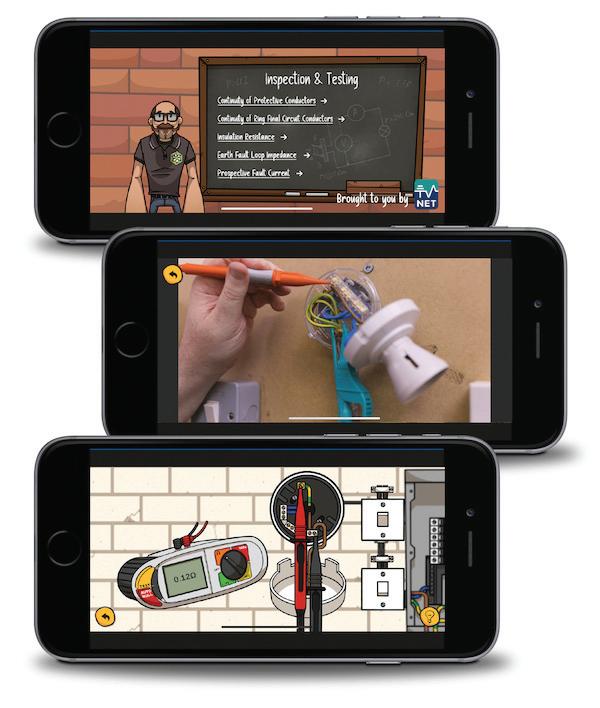
It’s no substitute for correct training in this area, but it’s certainly a great revision tool to use in the run up to the assessment.
Finally –a major stumbling block is not carrying out the test correctly. During the assessment you’ll have copies of Guidance Note 3 and the On-Site Guide available for reference, so make sure you follow these testing procedures to the letter. Don’t slip up by not following the correct procedure when it’s right there in front of you!
GET MORE DETAILS ON HOW TO
WIN A SMART EV HOME CHARGER!
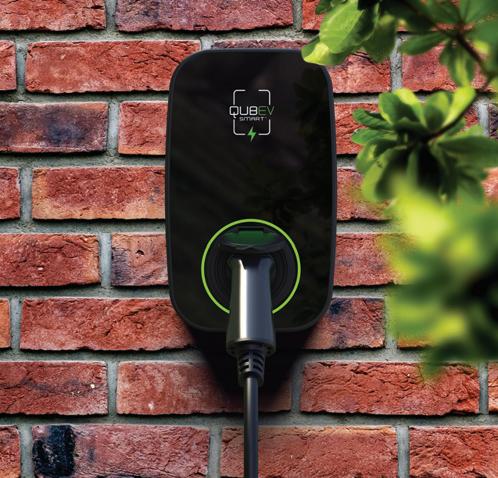
Rolec EV is giving one reader the opportunity to win its newest home charging solution –worth nearly £500!

Rolec EV is constantly looking to find ways to innovate EV charging technology and the new QUBEV Smart charge point is no exception.
Created with advanced smart charging capabilities while maintaining price consciousness, the QUBEV Smart incorporates all the features you look for in a home charger, including a universal charging socket, built-in LED charging indicator and adjustable charging rating.
There’s also a host of new additions for users to take advantage of as well. One example is that the QUBEV Smart is paired with a free Smart Wi-Fi App, opening a range of opportunities for users to engage with their EV charger. Options include scheduling charges to power up the vehicle during off-peak hours (utilising the most cost-effective tariffs), viewing
charging status and monitoring electricity usage, as well as numerous other charge-management features.
Key features include:

● 7.4kW
● Untethered universal socket –compatible with all EVs and PHEVs on the market.
● Solar compatible – charge your vehicle using green energy generated at home.
● Free Wi-Fi App – save money by scheduling charge during off-peak hours, view your charging status and monitor your electricity usage.

● Adjustable charging rate.
Further details on the QUBEV Smart can be found at: www.rolecserv.com/ev-products/QUBEV-SMART

HOW TO ENTER
TO ENTER THE FREE PRIZE DRAW TO WIN A ROLEC QUBEV SMART – WORTH NEARLY £500 – SIMPLY FILL OUT THE CONTACT FORM AT: WWW.RDR.LINK/EAT011
Deadline for entries: 31/08/2023. Usual T&Cs apply.
PRIZE DRAW
Q. I’ve heard that the Inspection & Testing section of the AM2 is one where many are unsuccessful. Where are people failing and what can I do to give myself the best chance?
DOWNLOAD THE NET INSPECTION & TESTING APP AT: WWW.RDR.LINK/EAT010
ENTER THE CPD ZONE AND EARN1CPD CREDIT TOWARDS YOUR PROFESSIONAL RECORD!
continuing professional development (CPD) can be broadly defined as any type of learning you undertake which increases your knowledge, understanding and experiences of a subject area or role. To help professionals to better document and prove this process, our brand new CPD Zone contains content and articles that have been checked, verified and accredited by a third-party specialist organisation.

Collectively, the content within this section has been deemed worthy of 1 CPD credit, or 1 hours’ worth of CPD
Once this content has been consumed, readers will have the opportunity to scan a QR code which will provide a bespoke, downloadable certificate that can be used as part of a
professional’s ongoing CPD record. This means that if you’re a monthly reader of PE, you could earn up to 11 credits, or 11 hours’ worth of CPD, just by reading a regular copy of your favourite independent industry magazine in 2023.
DO NOT SCAN THE QR CODE UNLESS YOU HAVE READ ALL OF THE CONTENT WITHIN THIS SECTION!
A large element of CPD involves self-certification and relies on professionals being honest about what they have actually read, consumed and digested. A QR code and RDRLink code have been placed with the final article in this month’s CPD Zone and ONLY once you have read ALL of the articles within this section, should you then scan/enter the code to receive your bespoke certificate.
By skipping any of these steps, you’re not just cheating the system, but yourself and your fellow professionals at the same time!
NEW USERS –ACCESS YOUR BESPOKE CPD CERTIFICATE IN FIVE STEPS
1. Read ALL of the content and articles included within this month’s CPD Zone.
2. Scan the QR code or enter the RDRLink code with the last article in this section.
3. Enter your email address.
4. Fill out your details on the contact form.
5. Download your certificate for use as part of your annual CPD record.
PREVIOUS USERS –ACCESS YOUR CPD CERTIFICATE IN FOUR STEPS
1. Read ALL of the content and articles included within this month’s CPD Zone.
2. Scan the QR code or enter the RDRLink code with the last article in this section.
3. Enter your name and email address.
4. Download your certificate for use as part of your annual CPD record.
All certificates are valid for one year from the issue date. If you’re having any issues with downloading your certificate or using the system, please email us at: pe@hamerville.co.uk

THE CPD ZONE
PROFESSIONAL ELECTRICIAN July/August 2023 23
THE CODEBREAKERS




Unfortunately, we see these used quite frequently these days. They’re often used instead of Henley blocks or similar termination points to split meter tails for numerous reasons. Correctly named ‘Insulation Piercing Connectors’ or ‘Line Taps’, they’re designed to be used where they’re at height and out of reach.
Although there are many different manufacturers of this type of connector, this manufacturer states clearly that they’re to be used for specific overhead LV cables and should also be used in conjunction with cable support equipment to reduce mechanical stress. The requirements and protective measures that can be used on overhead lines and taking advantage of out-of-reach caveats differ greatly from those that can be used where terminations can be readily accessed. Placed out of reach is a protective measure that skilled persons must control or supervise.
Before we consider that this equipment is not being used as its manufacturer envisaged, we need to




understand that its improper fitting has left access to live parts, which is an immediate danger. Anyone in contact with this –the client or future engineers –could receive a fatal shock.
Secondly, we need to look at the need for any terminations in a cable to be supported and taken into an adequate


GET THE BOOK AND CRACK THOSE CODES!
enclosure. Understandably taking into an adequate enclosure may not be where this equipment was designed for, as this may not be possible when dealing with overhead lines, however. In this case, they’re not being used as the manufacturer designed them for, and so must be taken into an adequate enclosure.
24 July/August 2023 PROFESSIONAL ELECTRICIAN
ADAM LUBKOWSKI: THIS WAS CARRIED OUT BY A SOLAR SPECIALIST COMPANY IN A CUPBOARD THAT WAS VERY MUCH IN USE AND FULL OF BROOMS, HOOVERS AND OTHER STUFF. NOTICE THE BARE COPPER POKING OUT OF THE LINE TAIL…
for BS 7671:2018+A2:2022, NAPIT’s EICR Codebreakers publication is purpose-written to aid contractors, inspectors and clients, and now includes updates to align with Amendment 2 of the IET 18th Edition Wiring Regulations. The book is the perfect technical aid for electrical professionals and their customers.
Updated
This is a prime example of why we must ensure that EICRs are carried out and that any electrical work is undertaken by adequately qualified, skilled and registered persons.
Mixing different manufacturers' equipment in one manufacturer’s enclosure without the main manufacturer’s consent has long been unacceptable –and for a good reason. Different manufacturers design their equipment to operate and discharge gasses etc., in different directions. When we mix different manufacturers' equipment, there is a danger that those gasses can be discharged onto conductive parts where they aren't designed, or type tested, to be and can cause a fire or other damage.
In this case, the two manufacturers (Eaton and MEM) merged and are now one entity, or act as subsidiaries. Although they are, in effect, the same manufacturer, the original MEM DB is clearly older than the newer Eaton MCBs that have been fitted. This means that the original DB has been butchered to make a



3-phase Eaton MCB fit.









Not only is it now unlikely to be adequately terminated to the busbar, but the MCB’s off/on switch direction is also different from the rest of the devices in the DB. This could cause confusion in the event of required emergency isolation. There are single-phase Eaton devices in the board that appear to be a replacement for possibly unavailable MEM devices and look to fit as they should.
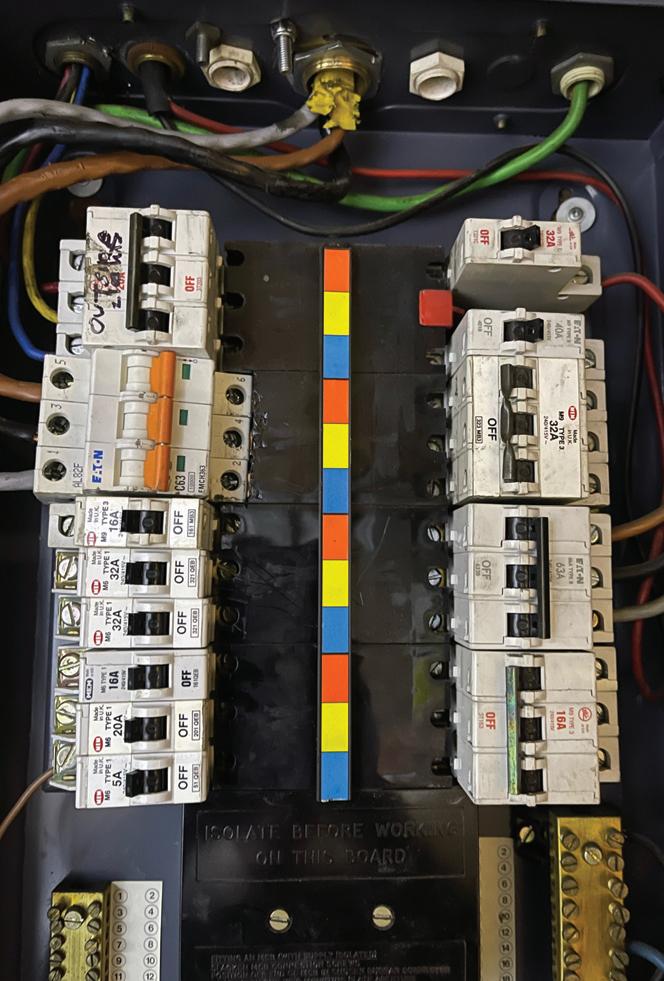
Although some manufacturers will allow retrofitting of newer devices in older boards, some do not, and some different ranges of manufacturers' equipment may not be compatible. If in doubt, always consult the manufacturer to ascertain if the devices fitted are acceptable.




ORDER YOUR COPY OF NAPIT CODEBREAKERS BY VISITING: WWW.RDR.LINK/EAT012 The A2:2022
It is available in both hard copy and digital versions * Price is VAT exempt and excludes postage and packaging.
18th Edition Codebreakers publication is priced at £22.00 (members) and £24.00 (non-members).
Need help with cracking those all-important EICR codes? Every month the technical team at NAPIT will be studying your latest ‘Caught on Camera’ photos and offering advice on the next steps, should you find a similar installation. If you want the team at NAPIT to help crack your codes then send your pictures through to us at: pe@hamerville.co.uk
JOE PERKINS: THIS WAS FOUND WHILE CARRYING OUT AN EICR AT
A
LORRY MOT WORKSHOP. “WE’LL MAKE IT FIT” THEY SAID…
“Mixing different manufacturers’ equipment in one manufacturer’s enclosure without the main manufacturer’s consent has long been unacceptable –and for a good reason.”

GUIDANCE ON EQUIPMENT IN METER BOXES
Electrical equipment associated with the consumer’s electrical installation is increasingly being found within the meter cabinet of domestic and similar premises. The space within such cabinets is limited and typically allocated for specific usages by the distributor and energy supplier and therefore, should not be used to house other equipment. If this guidance is ignored and inappropriate equipment is installed within an enclosure, restricting the activities of the distributor or supplier, customers may incur financial penalties to have such equipment relocated. This is likely to lead to customer complaints against the contractor originally responsible for the installation and result in reputational damage for the installer.
Introduction
When an electrical supply is laid on to a domestic or similar premises, the host Distribution Licence Holder will require the provision of a suitable enclosure at the service position to house the intake and metering equipment. Although this enclosure is provided with the property, the distributor will specify that only equipment belonging to the distributor and meter operator (MOP) should be installed therein.


Industry guidance on meter enclosure provision
The Energy Networks Association (ENA) is the body representing energy networks in the UK and Ireland. The ENA provide guidance within Appendix B (Spatial requirements for whole current metering) of its publication Energy Recommendation G87. Issue 2: 2015 – Guidelines for the Provision of Low Voltage Connections to Multiple Occupancy Buildings (EREC G87) on the minimum provision of space in meter enclosures. This is summarised in Fig 1 It should be noted that the arrangement of equipment as laid out in EREC G87 and as shown in Fig 1 is for illustrative purposes only. The ENA recognises in its guidance that a “best use of space” approach may be adopted based on particular circumstances and equipment required to be installed.

Nevertheless, the guidance also highlights that these minimum space requirements do not allow for the inclusion of any other additional customer equipment.
Individual Distribution Network Operators (DNOs) will issue their own guidelines on
the provision of space in meter enclosures as a condition in their “Connection Offer” to customers. This guidance, although based on the information given in EREC G87, may vary. Typically, the space is divided into four, as shown in Fig 2. However, the guidance on additional customer equipment does not differ from that of EREC G87, as can be seen in Fig 2

This advice has increased significance because of the smart meter rollout program, as some modern meters and associated equipment can take up more space than the meters they replace.
Additionally, it is becoming increasingly common for domestic or similar premises to be provided with three-phase intakes to facilitate future developments in the supply of electricity, such as “prosuming” and the introduction of networks operated by Distribution System Operators (DSO). This will inevitably result in more demand for space for equipment at the intake position.
PROFESSIONAL ELECTRICIAN July/August 2023 27 THE CPD ZONE
Fig 1. ENA EREC G87 guidance on the installation of whole current metering equipment at the service position
Fig 2. Typical DNO recommendation for space allocation within a meter box enclosure
The experts at NICEIC provide more detail on the installation of equipment in meter boxes.
Installation of electrical equipment in the meter enclosure
Increasingly, contractors are installing equipment other than that directly associated with the supply and metering arrangements in meter enclosures at the service position. Evidence shows (see Fig 3) that installers of electric vehicle charging equipment find external meter enclosures to be a convenient location to install equipment such as joint boxes/connections in the meter tails, isolating switches, and small consumer units.

In some cases, carrying out the work in this way may have been encouraged by the property owner or occupant, as it avoids the need to install often aesthetically unpleasing electrical enclosures on the exterior of the property.
Implications for the customer
If the DNO or MOP need to attend a domestic or similar premises and encounter equipment other than that used for supply or metering purposes within an approved meter enclosure, this may prevent work activities such as:
● the replacement of lifetime-expired equipment;
● the installation of smart metering equipment;
● the installation of new cut-outs to provide enhanced supply capacity to allow for:
● an extension to the property;
● the connection of embedded generation; or
● the provision of electric vehicle charging equipment or other equipment which increases the maximum demand at the premises.
In such cases, where there is insufficient space within the meter enclosure, the planned replacement or upgrading work cannot proceed until sufficient space is made available therein.
The ENA have issued the following statement:
“While the meter cabinet is the customer’s, it is a space designed for the use of electricity industry apparatus only and no allowance is made for additional equipment. For safety reasons, we would
not recommend that any internal wiring, including a consumer unit, is installed within the cabinet.”
Energy Networks Association

Furthermore, this is supported by guidance from the Department for Business, Energy & Industrial Strategy in Section 2.9 of its publication Smart Meter Guidance for Domestic New Builds –Guidance for Developers and Architects, and relevant to all those involved in the specification of metering locations in new-build premises, which is reproduced below:
“External meter boxes/cupboards should only contain equipment required to enable an electricity (or gas) supply to be provided to the premises safely, as defined by relevant regulations.
● Items permitted to be installed within electricity meter boxes/cupboards include: the local isolating device (e.g. main cut-out fuse), the electricity meter and communications hub, and may include a single- or double pole-isolation device (installed between the electricity meter and consumer unit).”
Therefore, where the guidance of the organisations discussed in this article is ignored, preventing any future upgrade work, the customer will be instructed by the DNO/MOP to employ a suitably competent person to remove and relocate
the inappropriate equipment – all at the customer’s expense and potentially incurring reputational damage for the previous installer.
Summary
A meter enclosure may be provided at the service position of a premises to allow for the installation of the intake and metering equipment. The space allocation for this enclosure allows for the replacement of lifetime-expired equipment, installation of Smart Meter equipment and for some degree of future supply capacity upgrade.
Only intake and metering equipment should be installed in the meter enclosure, as there is no allowance of space for housing additional equipment not associated with those functions.
If a DNO or MOP attends the premises to carry out work on their equipment and insufficient space is available within the meter enclosure, work will not be able to proceed. The customer will need to organise (at their expense) the removal of unrelated equipment to create the space needed for the work to be carried out.
NICEIC strongly recommends that electrical contractors do not install any other equipment within meter enclosures.
THE CPD ZONE 28 July/August 2023 PROFESSIONAL ELECTRICIAN
GET MORE DETAILS ABOUT NICEIC REGISTRATION AT: WWW.RDR.LINK/EAT013
Fig 3. Equipment associated with provision of electric vehicle charging points installed within external meter enclosures

EAWR AND BS 7671: CAN ONEHELPTHE OTHER?
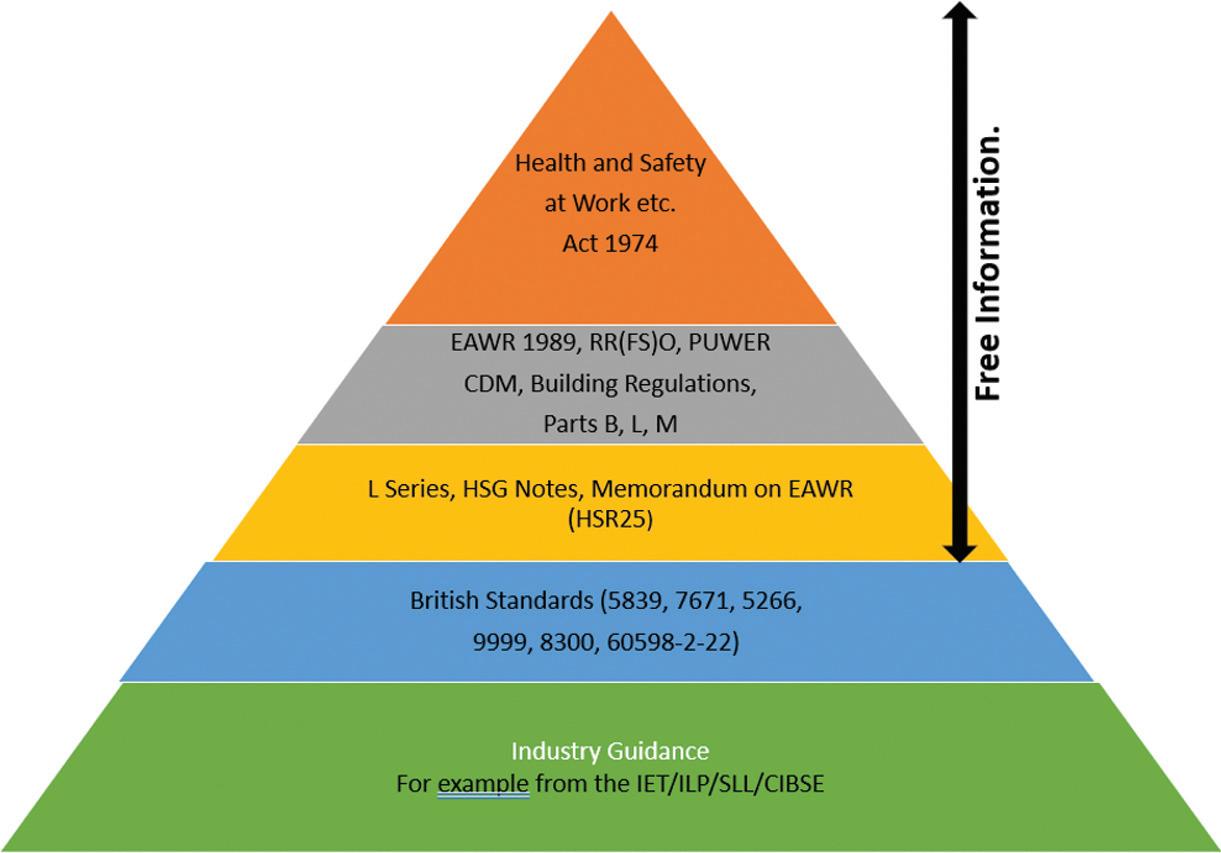
In this article, produced for PE before his recent passing, Paul Skyrme looks at the relationship between the Electricity at Work Regulations and BS 7671.
This article intends to explain the inter-relationship between standards and legislation, using BS 7671 and the Electricity at Work Regulations as the reference point. Firstly, it should remembered that standards are not compulsory. They may be considered best or good practice, or even the bare minimum (BS 7671, I’m looking at you), but they’re not mandatory for compliance with the law.
For work being undertaken by electricians in the UK, one of the most important pieces of law is the Electricity At Work Regulations 1989 (as amended), referred to from here forward as EAWR.
EAWR applies to all electricians or anyone undertaking electrical works, regardless of where those works are being undertaken –a private home, a shop, a hospital, a railway, or the Houses of Parliament.
If we look at EAWR in a little more detail, we’ll see that some of the requirements will fall under the remit of the designer of the installation, some under the remit of the installer, and some under the remit of the person undertaking the inspection and testing.
Even with this quick glance, we can see that the legislation is far-reaching but, hopefully, if we follow BS 7671, we should meet the requirements of EAWR. But, how is this so?
We have the legal requirement, EAWR (Legislation), and our means to comply with this when at work in whatever capacity we work with the installation in BS 7671 (Non-mandatory standard).
BS 7671 even has an introductory note written by His Majesty’s Health and Safety Executive (HSE) suggesting and endorsing the use of BS 7671 to meet the requirements of EAWR.
In a nutshell, this gives us a piece of legislation –EAWR –and the means to meet it –BS 7671.
If we now consider BS 7671, we will find Appendices in there labelled ‘Normative’ and ‘Informative’. Only one Normative Appendix –Appendix 1 –lists the standards referenced in BS7671.
Why are they in there and why is this important?
They are there to illustrate that these standards relate to the products we purchase to complete our electrical installations under BS 7671. This ensures that the products are safe to use and that
a product made to these standards should be safe to use anywhere in the European Economic Area –not just the EU, but slightly further afield.
What does Normative mean?
In this situation, applied to this Appendix, Normative means that the Appendix itself forms part of the requirements for BS 7; that is, to comply with BS 7671, one must comply with the requirements of Appendix 1.
Much of what is listed in Appendix 1 are product standards, so the designer, constructor, inspector and tester have little or no control over them. Is that important? Perhaps, perhaps not.
If the designer is also specifying equipment, then to comply with BS 7671, the equipment specified must meet the requirements of the product standard listed in Appendix 1.
Before you ask, this doesn’t mean the designer needs to start by buying the product standard and then getting their hands dirty to check that the selected product meets the requirements. The person selecting the product to be used should instead satisfy themselves that the product is compliant by using the tools outlined in the legislation which facilitate this. This is often known as ‘undertaking due diligence’.
What tools are available and how do we use them?
The tools are the CE/UKCA (I will use CE from this point forward to mean both CE & UKCA) marking and the Declarations of Conformity (DoC). Electrical products must be safe to be placed on the market or otherwise made
THE CPD ZONE
30 July/August 2023 PROFESSIONAL ELECTRICIAN
The legal status of documents surrounding BS 7671 and their available volume.
Legislation in layers!
available in the marketplace.
This requirement extends not only to items for sale to paying clients but also to any equipment made internally to meet the needs of the business. So, a test adaptor made internally within the company should be CE-marked.
For now, we’ll ignore internally designed and manufactured products and will only consider products selected and purchased on the open market to construct an electrical installation, such as isolators, light fittings, switches etc.
How would we check these?
Firstly, we need to get hold of the DoC for the product. The structure and content of the DoC are defined in the law. This law is the Low Voltage Directive (LVD), as amended, and is transcribed into UK law, mirroring the safety requirements of the LVD, as the Electrical Equipment Safety Regulations (EESR). On the DoC, a requirement is to list the standards used for compliance with the legislation.
So, in this case the due diligence called for would be to verify that the product standards listed on the DoC meet those required by the legislation and that this standard is also listed in BS 7671.
The product manufacturer is responsible for compliance, following the product standard and completing the DoC. There is, therefore, the possibility of the information being incorrect or misleading on the DoC or that the product will not meet the requirements of the product standard.
There’s nothing that the specifier can do concerning this except, perhaps, selecting products from reputable and reliable manufacturers with a good reputation in the supply chain and procuring these items from reliable and reputable sources.
In conclusion
The aim of this article has been to provide a brief overview of how a standard (BS 7671) can be used to meet a piece of legislation (EAWR), what a Normative reference in the standard is, and how this
It is with great sadness that PE has to report the death of this article’s author, Paul Skyrme, following a long battle with illness.
Paul’s career began with an apprenticeship in Industrial Maintenance with Austin Rover, followed by various factory maintenance roles with global industrial manufacturing organisations.
He self-funded his HNC in Engineering and undergraduate studies with the Open University whilst employed as an Installation & Service Engineer for a global high-precision machine tool manufacturer. Paul completed his BSc. with 1st class honours, followed by his Master of Engineering with the Open Univeristy.
Paul went on to hold several roles in manufacturing engineering and, in the early 2000s, was heavily involved in developing what has since become Industry 4.0. Through his company, Abertawe Engineering Services, his later work involved electrical product and machinery safety consultancy for CE marking to the LVD & MD for equipment manufacturers as well as CE audits and PUWER compliance assessment works for end-users.
He became an IET fellow, registered with the Engineering Council at the IEng level, and was a TUV Nord Certified Machinery Safety Expert. He was also an IET volunteer, Professional Registration Advisor (PRA), and EngTech Assessor.
Normative reference can be used to assist in ensuring that products selected for use under BS 7671 meet the relevant product legislation (EER) and assist in compliance with the EAWR.
Further information and background can be found at the following links:
● Health and Safety at Work etc. Act 1974 (legislation.gov.uk)
● The Electricity at Work Regulations 1989 (legislation.gov.uk)
After being taken ill with stage 4 cancer in November 2020, Paul kept himself busy with voluntary work with the Electrical Safety Roundtable and the IET, including participating in the EngTech Elec programme & BS 7671 Technical Regulations publications.

As someone who gave up so much of his time and knowledge to support and encourage others, and was widely regarded by his peers as one of the ‘real’ industry gurus, Paul’s loss to an industry that he loved is enormous. We’d like to express our sincere condolences and best wishes to Paul’s family, friends and colleagues.
● The Electrical Equipment (Safety) Regulations 2016 (legislation.gov.uk)
● Directive 2014/35/EU of the European Parliament and of the Council on the harmonisation of the laws of the Member States relating to the making available on the market of electrical equipment designed for use within certain voltage limits (europa.eu)
● The Electricity at Work Regulations 1989. Guidance on Regulations (hse.gov.uk)
PROFESSIONAL ELECTRICIAN July/August 2023 31
PAUL SKYRME – 1966- 2023
WHAT IS LS0H CABLE?
QI find myself working with LS0H cable on a more regular basis these days. Is this going to become the norm, and if so, how shall I tackle it? I find it very difficult to work with.
Use of LS0H (low smoke zero hydrogen) cable is indeed on the rise in the UK. While it isn’t a new product, a heightened awareness of fire safety, coupled with its growing prevalence in the USA, Ireland, and Europe, has seen the fire-safe material come into more common usage in the UK recently.
Made from thermoplastic material, LS0H was first developed in 1979. It is an incredibly tough cable jacketing that’s resistant to fire and fumes, and – critically – doesn’t produce smoke when it burns. This has a dramatic impact on how it reacts to fire and high temperatures. While PVC may be cheaper, it produces a thick, acrid, highly toxic, and corrosive smoke. This smoke kills. We know that smoke inhalation is a bigger cause of death than fire itself in fire-related emergencies.

The Kings Cross Fire in 1987, for example, claimed the lives of 31 people and injured 100 more. The fire took hold for several varied reasons. It began with a lit match on an escalator, but thick black smoke filling the ticket hall claimed the lives of almost everyone present. In response, cables containing halogen ceased to be used on the London Underground, and awareness and usage of LS0H cables grew.

Now, with the legacy of the Grenfell Tower tragedy looming large, we’re seeing a further rise in LS0H cable jacketing. In any area where smoke and toxic fumes could pose a risk to life, LS0H should be used. In public buildings and high-density housing in particular, use of LS0H is critical. Should a fire take hold, fumes from LS0H cabling will emit less than 0.5% HCL gas, dramatically cutting toxicity. What’s more,
a lack of smoke will result in enhanced visibility, enabling easier evacuation. It's also important to distinguish between LS0H and LSF (low smoke and fume) cable. LSF is made from a modified PVC compound and emits 15 – 22% HCL gas upon burning. That’s 8 –13% less than standard PVC. However, toxic fumes and thick black smoke will still pose a significant danger to life. While it is marginally safer than PVC, LSF should not be confused with LS0H which emits 0.5% HCL gas and therefore does not produce toxic fumes or black smoke. Nor does it pose a danger to life.
Cost-cutting measures –such as specifying PVC or LSF cable when LS0H is safer and more appropriate – are rightfully falling out of practise. New regulations around the use of LS0H are anticipated.

THE CPD ZONE
Brinley Buckley-Roberts, Brand Manager at Carl Kammerling International, answers a common contractor query related to the use of LS0H cable.
32 July/August 2023 PROFESSIONAL ELECTRICIAN
Use of LS0H cable in rail applications has increased in recent times
But LS0H is more difficult to work with than PVC cable. The material is stronger and less flexible than its PVC or LSF counterparts. Many electricians have reported challenges in stripping the LS0H, as standard cable strippers fail to meet the strength of the thermoplastic material.
Working with LS0H cable may be more challenging and time-consuming, but choosing this cable over PVC or LSF could save lives. Armed with the right tools and equipment, and knowledge of its excellent fire safe credentials, tackling LS0H can and can be straightforward and worthwhile process.

WHAT EQUIPMENT IS RECOMMENDED FOR USE WITH LS0H CABLE?



Specialist strippers, made from toughened materials and with multiple blades, should be used when working with LS0H cable. Using the correct bracket size for the width of the cable, LS0H cable strippers peel the cable along its length, like a banana skin, allowing for simple stripping.
Due to its tougher nature, LS0H can also be less flexible. This can lead to cracking during installation. To prevent this, specialist lubricant is recommended to reduce friction. Of course, it’s important to also choose non-toxic, non-flammable, and non-corrosive lubricant.
CK Tools’ LS0H cable stripper includes two titanium nitrade coated blades and four cable brackets to tackle any size of LS0H cable.
GET MORE DETAILS ON C.K’S LS0H CABLE STRIPPER AT: WWW.RDR.LINK/EAT014

“Critically, LS0H doesn’t produce any smoke when it burns.”
A SURGE IN COMPLEXITY
What is a complex installation?
When we talk about complex installations, we generally mean those that aren’t simple domestic dwellings or basic commercial installs.
That doesn’t mean that all domestic installations are simple installations, nor does it mean all commercial and industrial installations are complex. When an installation becomes more complex, it may have the following:

● Multiple sub-boards
● Sensitive equipment (general)
● Sensitive equipment rooms or Zones (specialist)
● High-value equipment (individual electric vehicle charging)
● High-value equipment (multiple electric vehicle charging systems)
● Data collection and holding systems
● Life safety and support systems
● Emergency egress systems
● Surveillance systems (security)
● Surveillance systems (critical safety)
● Security entrance and exit systems
● Multiple surge inlet threat areas (anything that can import a surge or overvoltage threat to an installation)
● TV aerials and satellite coax
● Overhead telephone lines
● Solar PV array (roof-mounted)
● SolarPVarray(ground-installedPV farm)
● CCTV equipment (generally taken to be those on purpose-built columns, etc.)
● Outside lights (generally taken to be lamp posts, etc.)
● Electric gates.
This list isn’t exhaustive by any means, but we can see the type of installation that can easily slide from simple to complex, with the emphasis now placed on SMART integration.
It’s possible that many future installations could easily fall within the
remit of being classified as complex, especially where SMART applications can have a lower voltage withstand (Uw), with more Category 1 equipment present.
Why do we need to look carefully at these installations?
If we take the standard requirement of BS 7671 Regulation 443.4.1 and its three bullet points aside, which are in place for indirect stokes on the incoming supply, we are left with Regulation 443.1.1. This requests that we take into account switching overvoltages where atmospheric protection is not installed.
As well as Regulation 443, Regulation 534.4.1.6 requires that we consider not only switching loads but also where overvoltages can be introduced from other services feeding into secondary buildings on a site, or from them if they represent areas of multiple inlet threats.
Where atmospheric protection is omitted, it’s prudent to look at protecting against switching damage. We need to do this because the magnitude of switching surges tends to be less than those of an atmospheric nature, but they can be just as costly.
While atmospheric protection will generally afford switching protection as a side effect, there are issues with this in both complex larger installations and those with multiple surge inlet threat areas.
What are the threats?
It stands to reason that we need to look at switching overvoltages more as an industry. From a magnitude of occurrences perspective, the most damage to sensitive equipment comes from switching overvoltages, not atmospheric. These overvoltage switching threats can come from any number of different sources, both internal and external.
Examples of internal switching overvoltages are:
● Large motors
● Lifts
● Air Handling Units (AHUs)
● Air conditioners
● Pumps
● Process and/or manufacturing equipment
● Production line evolution operations
● Welding equipment
● Large lighting banks
● Commercial or industrial ovens
● Multiple EV charger systems
● CNC machines
● Autoclaves
● Alternative sources of supply
Again, this list isn’t exhaustive, and the sensitivity of the equipment that needs to be protected may be affected by much smaller overvoltages.
External to the installation, where National Grid operations may switch or changeover equipment, this can also affect sensitive equipment within an installation.
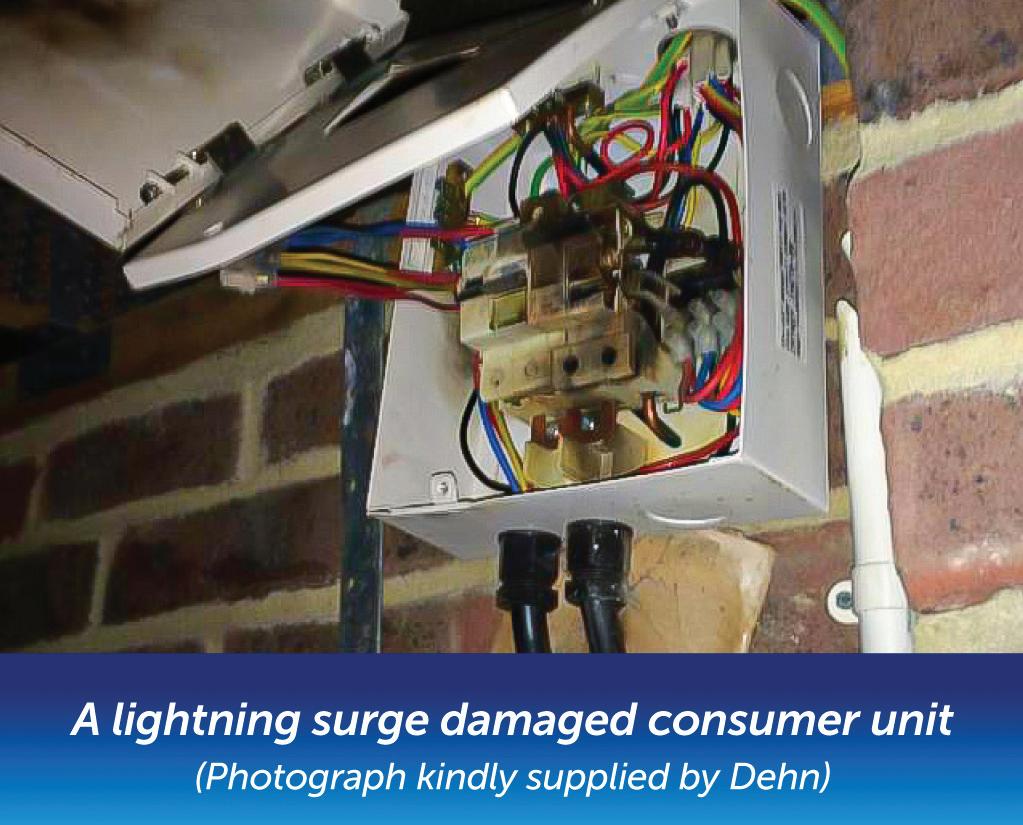
External switching is harder to predict, pinpoint or prove, so there is a feeling that it could be best practice to look at the consequences at the design stage and discuss with the client what their expectations or risk to their business could be and design accordingly.
If a client risk assessment highlights a high cost to their business model from lost
THE CPD ZONE 34 July/August 2023 PROFESSIONAL ELECTRICIAN
NAPIT’s Principal Technical Author, Richard Townsend, looks at the importance of surge protection in complex installations.
production, lost data, or damage to equipment, there may well be a need to include switching overvoltage protection within the installation design criteria.
What to think about at the design stage
As with all designs, there are a few things we need to consider when specifying surge devices. Firstly, each manufacturer’s device is tuned or manufactured to specific attenuation values.
This means we can’t mix and match between manufacturers, as the device protection trail-off zone from one manufacturer may not favour the activation zone of the downstream device of a different manufacturer. I mention downstream because, in physically larger installations, the protection afforded by a single device starts to lapse at about 10 metres, in most scenarios, due to resonation or oscillation, causing the overvoltage surge to pick up in magnitude.
This reduction in effectiveness means that the designer may need to incorporate multiple devices along a circuit, especially where very sensitive or essential equipment needs to be protected.
Where this is impractical due to the length of the circuit, SPDs placed at the load end of the circuit to protect particular equipment types may be prudent and more budget friendly.
Although any increase in the magnitude of an overvoltage 10 metres after a surge protective device due to resonance is often associated with high-energy lightning stroke events, they can still be caused by manmade/switching loads, albeit with lesser degrees of magnitude.
A lesser degree of magnitude can still cause significant damage to sensitive
electronics and equipment, and the designer needs to understand that manmade/switching overloads are more frequent than atmospheric overvoltages.
The accumulation of damage and degradation to both equipment and SPDs over time by manmade or switching overvoltages mustn’t be overlooked or underestimated by the designer.

We also need to reduce overvoltages from multiple surge inlet threat areas. Although the supply cable may be protected, surge inlet threat areas can still introduce an atmospheric event that can cause significant damage. For this reason, careful thought also needs to be given to the input and output signal lines of control cabinets or controls to roof mounted plant.
Overvoltage protection devices will stop downstream surges from an atmospheric stroke (lightning), but they can’t protect the upstream equipment. This is because the sheer destructive force of an atmospheric stroke, even with lightning protection, will cause some damage. What we are looking to do here is reduce the devastation within the installation.
We can see this by looking at Fig 1, which shows a more complex installation.

If, for example, there were a lightning stroke on the CCTV equipment, the resultant energy would be directed into the installation and cause massive damage. If there were appropriate surge protection here, the rest of the installation would be saved if the overvoltage devices were specified correctly; the CCTV camera, however, would be destroyed.
There is no absolute protection from lightning; any Lightning Protection System (LPS) or associated Surge Protective Devices (SPDs) will only mitigate or reduce
the effect of an atmospheric event, which is why the CCTV mentioned earlier would become sacrificed.
However, overvoltage devices or SPDs will protect totally against switching overvoltages, as the magnitude is significantly reduced.
The only trade-off that the designer needs to understand is that each time a surge device operates, its effectiveness is reduced to the extent that it will need to be replaced when it reaches a pre-designed level. This can be via the modular devices often found within consumer units or complete replacement where compact Type 3 devices are used in back boxes for fire alarm panels, etc.
What’s available to help with the possible threats?

There are many different types of SPDs on the market, not just for inclusion into the mains voltage side of an installation. They are available for coax, data and everything else in between.
If in doubt, speak to the manufacturer you are looking to specify before confirming your design or ask them to be involved –they’re more than willing to help.
How to keep up to speed
If you feel that you need more guidance or would like to gain a more in-depth level of design knowledge, NAPIT Training can provide both electrical installation design and surge protection courses. Either would greatly enhance your understanding of two very complex subjects.
GET
PROFESSIONAL ELECTRICIAN July/August 2023 35
MORE DETAILS ABOUT NAPIT’S TRAINING OFFERING AT: WWW.RDR.LINK/EAT015

Following the announcement from the IET and BSI, that a corrigendum to BS 7671:2018+A2:2022 would come into effect, Jake Green, Head of Technical Engagement at Scolmore Group, provides some more detail on the changes.

BS 7671:2018 The corrigendum explained
Under the auspices of the IET/BSI, JPEL64, the committee responsible for BS 7671, have issued a corrigendum to address issues raised after the publication of Amendment 2 of BS 7671: 2018. These issues fall into three specific areas:
● Protected escape routes – amendment to Regulation 422.2 to clarify the scope of the provision in general installations, and a new provision for medical locations (710.422.2).
● Birthing pools – amendment to Regulation 701.1 removing the reference to birthing pools.
● Provision of protection against overvoltage for safety services.

Protected escape routes
Regulation 422.2 has been amended to provide clarification on its application. The regulation now states:
‘Cables or other electrical equipment shall not be installed in a firefighting lobby, shaft or staircase of a protected
escape route…’.
The text in bold italics is the amended detail. This change enables designers to better understand the scope of application of this requirement. Note 2 to Regulations 422.2 has been similarly amended, however, there are no changes to the guidance given in Appendix 13.
Further to this change to Regulation 422.2, a new regulation (710.422.2.201) has been added to Section 710 covering medical locations. This new text takes account of the specific concerns of the health sector and points towards the guidance issued under HTMs (England), SHTMs (Scotland) and WHTMs (Wales).
Birthing pools
Regulation 701.1 in Section 701 (Locations containing a bath or shower) has been amended to remove the reference to birthing pools. This change supports the work of designers in the health sector.
Protection against transient overvoltages of atmospheric origin
Regulation 443.4.1 now limits the

requirement for transient overvoltage protection to two conditions, (serious injury to, or loss of human life, and significant financial or data loss) by removing the reference to ‘safety services’.
However, the rest of the regulation remains the same, and protection against transient overvoltages (typically using SPD) should still ‘… be provided unless the owner of the installation declares it is not required due to any loss or damage beingtolerable…’.
As a consequence of this change, Table 443.2 has been amended by deleting the references to alarm panels, computers and home electronics. Furthermore, the note attached to Regulation 534.4.1.1 has been amended to remove the example of ‘fire/security alarmsystems’.
All of these changes became ‘live’ on 15th of May.
the cpd zone
DOWNLOAD THE CORRIGENDUM BY VISITING: WWW.RDR.LINK/EAT016
Dr. Zzeus

We’ve just changed fire alarm service companies to save money in the current climate. When I questioned why the new company was not testing voltages, batteries, and some other checks at the six-monthly service that the old company did, they said the old company were doing too much testing and that what they were currently doing met the standard. Is there a checklist of what should be done?
It sounds very much like the new service provider either does not know the standard or is trying to get away with not completing a service correctly. BS 5839-1:2017 Clause 45.3 covers the six-monthly inspections, and 45.4 covers the yearly inspection. I have listed the minimum checks that should be carried out at the six-month visit; your provider can do more than this, but not less.

Changing suppliers entirely based on price can be a wrong move; for a fire alarm company, the most expensive part is the employees’ wages, so cutting the price down often involves the engineer doing less, cutting corners or missing parts of the service.
Review the system logbook for recorded faults and ensure appropriate action has been taken.
Visually inspect for any structural or occupancy changes affecting compliance with the standards:
a. Check unobstructed and visible manual call points and any new fire exits that have been created have a manual call point adjacent to exits that
lead to a place of “Ultimate safety”.
b. Assess any new partitions or ones that may have been moved within 500 mm of automatic fire detectors.
c. Ensure no storage encroaches within 300 mm of ceilings.
d. Check clear space (500 mm) below automatic fire detectors.
e. Evaluate the suitability of existing detectors for changed areas.
f. Check additional fire detection and alarm equipment that may be needed for alterations or extensions.
Check false alarm records, note the rate in the past 12 months, and take appropriate action.
Measure battery voltage with mains power on, ensuring it aligns with manufacturer recommendations before other tests (without additional load).
Disconnect the standby battery, activate alarms, and verify the power supply output voltage close to the nominal value. Simulate full load if necessary (minimum 95% nominal voltage).
Inspect batteries and connections and load test without mains power.
Test fire alarm functions of the Control and Indicating Equipment (CIE) using at least one detector or manual call point per circuit. Record devices used in the logbook.
Confirm the fire alarm signal upon at least one manual call point or fire detector operation.
Verify proper operation of CIE controls and visual indicators.
Check the automatic transmission facility for alarm signals to an Alarm Receiving Centre, ensuring the correct transmission of each signal type.
Test all ancillary functions of the CIE.
Where feasible, check fault indicators and circuits through simulated fault conditions.
Test printers for functionality and legibility and ensure sufficient consumables until the next service visit.
Service all radio systems as per the manufacturer's recommendations.

Perform additional checks and tests recommended by the manufacturer for the CIE and other system components.
Report any remaining defects to premises management, complete the system logbook, and issue an inspection and servicing certificate.
DO YOU HAVE A QUESTION YOU'D LIKE ANSWERED?
38 July/August 2023 PROFESSIONAL ELECTRICIAN
EMAIL YOUR QUERIES TO: TOM@ZZEUS.ORG.UK
IN THIS REGULAR COLUMN, ‘DR. ZZEUS’ TOM BROOKES, md of zzeus training and CHAIRMAN OF THE FSA, WILL ANSWER YOUR QUESTIONS RELATED TO FIRE SAFETY COMPLIANCE. THIS MONTH’S COVERS INSPECTION PERIODS AND PROCESSES...

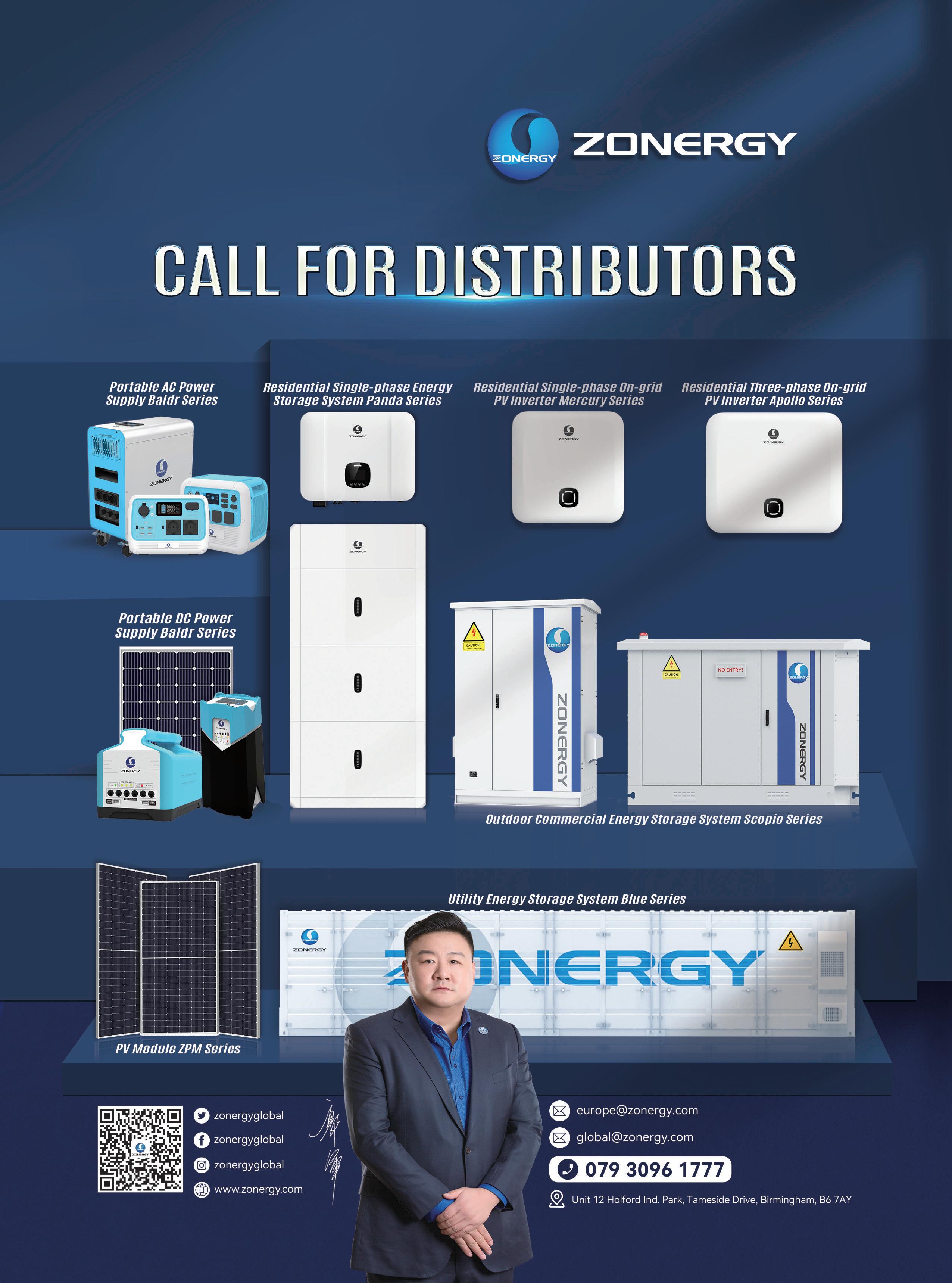
OVERVOLTAGEPROTECTION: THE LATESTUPDATE

Electrium provides a brief overview of one specific update in the Corrigendum: overvoltage protection.
it’s now well documented that the IET has updated certain requirements in Section 443 of BS 7671 Amendment 2. Those requirements relate to providing protection against transient overvoltages of an atmospheric origin or due to switching.
The revised requirements of Regulation 443.4.1 are as follows: Protection against transient over-voltages shall be provided where the consequence caused by the overvoltage could result in:
● Serious injury to, or loss of, human life
● Significant financial or data loss
● And in all other cases protection against transient over-voltages shall be provided unless the owner of the installation declares it’s not required.
Previous references to overvoltages causing the failure of a safety service, as

defined in Part 2 has been removed by the revised wording to Regulation 443.4.1.
All other cases
Ironically the clearest part of Regulation 443.4.1 is item 3 which says that overvoltage protection is required in all other cases. This catch all scenario requires the installer and the installation owner to have a conversation on the basis that overvoltage protection is automatically included in the design, and if after that conversation an owner says “no thanks” then the contractor should record that decision on a departure note and the completion certificate.
Owner responsibilities
While Regulation 443.4.1 takes account of circumstances where the owner of the installation could choose to declare that overvoltage protection is not required
The Wylex single module SPD is fully rated at 100 A and does not need MCB protection. It connects directly onto the busbar (just like an MCB) in way number one. It uses fewer cable links than some alternative products and fits all Wylex consumer units & SP&N distributions boards. This Type 2 Surge Protection device includes a status indicator and volt-free contacts for remote monitoring as well as replaceable cartridges that are securely locked into place and cannot be removed without use of a tool. Wylex single module SPDs are designed, manufactured & tested to BSEN61643-11 and certified as compliant by Intertek.

(which may be because any loss or damage is considered tolerable and the owner is willing to accept all risks of damage to equipment and any consequential losses) the benefits of protection in any modern installation with its plethora of sensitive electronic equipment will far outweigh any up-front SPD costs.
Specific situations
Although Regulation 443.4.1 refers to some specific situations it does not provide any guidance as to which types of premises are considered as ones where overvoltage can cause “serious injury to, or loss of, human life”. Nor does it advise which types of installation are susceptible to “significant financial or data loss” from an overvoltage fault. Designers and installers must use their own judgement. However, the types of premises that come to mind –hospitals, care homes, banks and financial institutions may well already have the subject covered in their electrical installation specifications.
THE CPD ZONE
WYLEX SINGLE MODULE SPD
CPD ZONE! SCAN THE QR CODE TO CLAIM YOUR CPD CREDIT FOR THIS EDITION OR VISIT: WWW.RDR.LINK/EAT017
Working on your own? Need some technical advice? Don’t know where to turn? Ask Megger. What it doesn’t know about installing and testing electrical systems isn’t worth knowing. Every question will be answered by the Megger Technical Team, and the best will be published in Professional Electrician. So, take advantage of the ‘every question answered’ guarantee today. email your questions to: meggermeasures@hamerville.co.uk
You ask:
I’M LOOKING FOR A FAST AND EASY WAY OF COMPLETING R2 AND R1+R2 TESTING AT SOCKETS WITHOUT HAVING TO REMOVE THE FASCIA FROM THE WALL TO GET TO THE CONNECTIONS. IS THERE ANYTHING YOU CAN SUGGEST?

Megger says:

What you need in this circumstance is a socket adapter. Fortunately, Megger has just launched a new one: the MSA1363. It lets you make test connections to the live, neutral and earth conductors of a circuit via a standard socket outlet, without the need for you to dismantle the socket or expose any live terminals or connections. The MSA1363 socket adapter has colour-coded terminals on the front which allow the test leads to be connected quickly, accurately and safely. Using the adapter saves time and trouble as well as minimising the risk of damage to the socket or the surrounding decoration. It allows measurements to be made with any suitable instrument that has test leads fitted with standard 4 mm connectors.
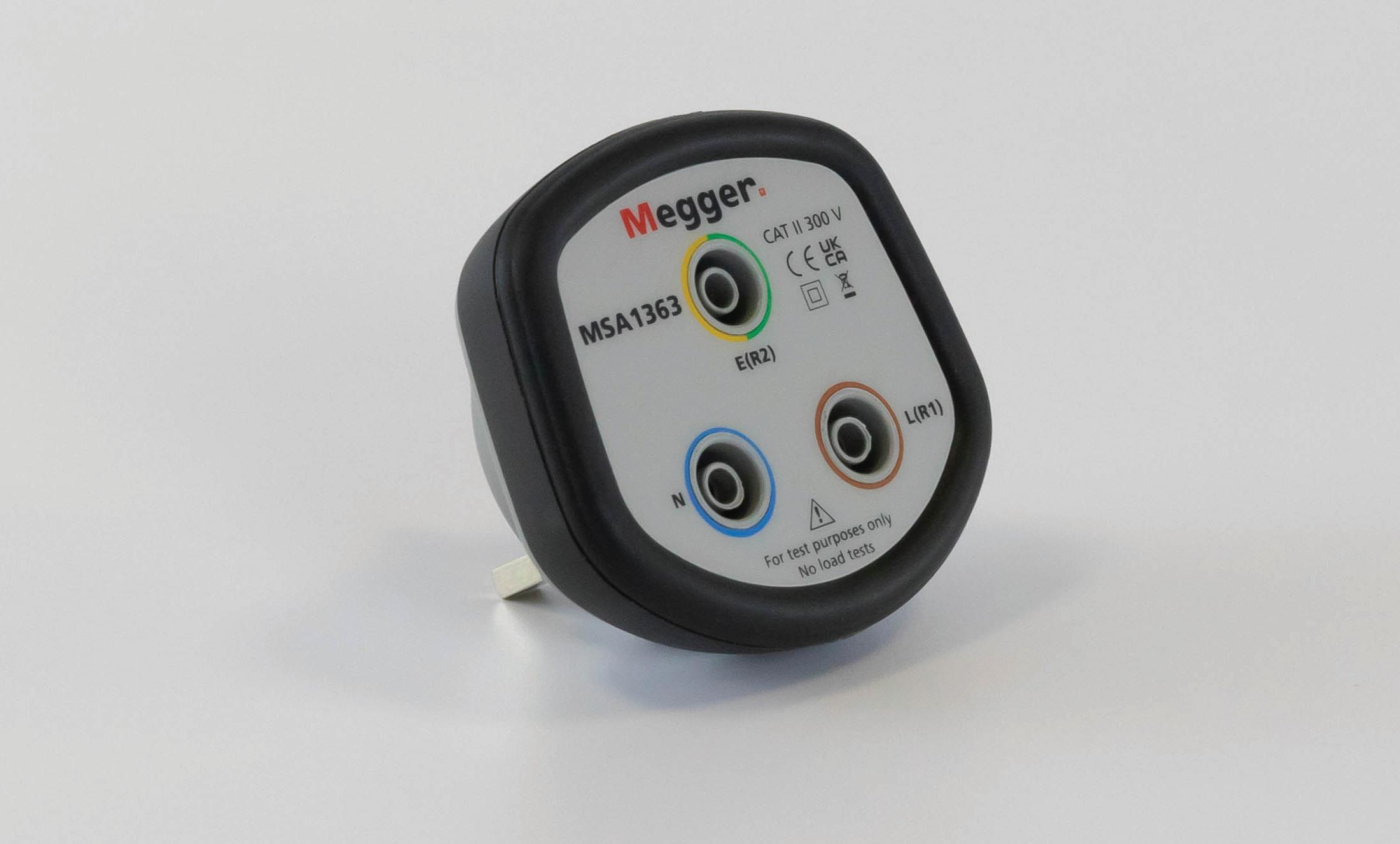
42 July/August 2023 PROFESSIONAL ELECTRICIAN
BROWSE THE MEGGER MSA1363 PRODUCT DATA SHEET AT: WWW.RDR.LINK/EAT018
TESTING TIMES
Mike Cullom, Sales Manager for Northern Europe at Ideal Industries, gives a detailed breakdown of the different types of test meters and highlights the key features electricians should look for when buying test equipment tools.
Electricians invest a substantial amount of money into the tools they use every day on the job site, so it’s important that they do their research and buy tools that are specifically appropriate to their line of work. The Ideal range of testers and meters is segmented into tools for commercial, domestic and apprentice use, enabling customers to easily source the right product for their specific requirements.
The part numbering system makes it easy to identify the right tester. The base model has the lowest number while the higher functioning/higher CAT rated testers have a higher part number; for example the entry point non-contact voltage tester is 61-627, the next model up is 61-637, and so-on.

Since meters can be simple diagnostic tools that accurately quantify voltage, amperage, and continuity, they’re used by almost every electrician in almost every setting. When combined with the specialised knowledge electricians possess, they can help test, install and repair electrical components of various capabilities and complexities.
Meters can easily determine if faults exist, verify proper circuit functionality, and can actively

assist in keeping infrastructure up and running. Most importantly, they help prevent unsafe conditions, not only for the customer, but for the electrician working on the circuit.
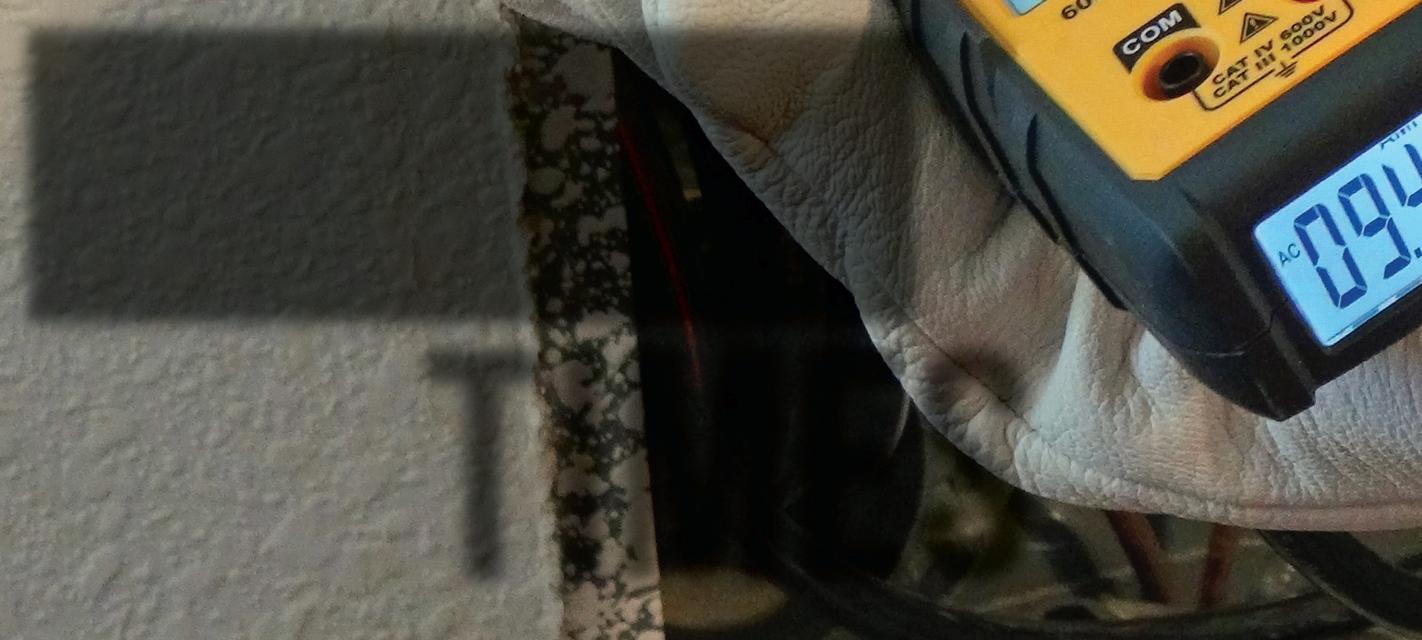
Each potential buyer must consider their work environment as being the biggest factor in making a purchase – not only now, but in the future. Since these tools can be expensive, they should be considered an investment and treated as such.
Residential electricians may pick something completely different than an electrician who plans on working on high current outdoor industrial applications. Each role may require a different tool.
Meter types include:
Multimeter
These meters are used for everything from small electronics applications to battery testing and continuity assessments. They often provide a higher degree of range, resolution and functionality than clamp meters.
Fork meter
A two-pronged “fork” fits around the conductor and takes a current measurement without interfering or breaking the circuit. This is
TEST EQUIPMENT & TOOLS
particularly useful in lower current (100 to 200 A) cramped or limited access situations.
Clamp meter
A retractable clamp fits around the conductor that is being measured allowing isolation from other conductors. This is more suited to applications in which conductor isolation is necessary, and for higher current applications.
Non-contact voltage tester

A speciality meter that is typically only useful in situations where only the presence of voltage is being sensed, to indicate the possibility that a circuit is energised or not. These testers simply verify the existence of electricity in a particular circuit or conductor. Non-contact voltage testers do so without any physical contact with the conductors and can be a complementary tool. However, most instructors discourage this as being a primary tool.
Safety first
One of the most obvious benefits of choosing the correct meter is safety. In high current applications, a clamp or fork meter is clearly less risky to use than a multimeter that uses probes, as it is not necessary to break the circuit to take a current measurement. There is always a
potential for an arc flash when interrupting a circuit, so using a meter that doesn’t require a circuit interruption is not only ideal, but also much safer.
Favourite features
When asked, seasoned professionals will all mention their favourite features in meters. Having had the opportunity to speak with industry pros, we got a variety of answers, including:
Battery life
For obvious reasons, this is an important aspect of a meter. You don’t want to be on a jobsite with a non-functional piece of equipment.
Alert/Tone technology
An audible notification is crucial in certain environments that are dimly lit, or just from an ease-of-use perspective. Many meter manufacturers offer this feature. Often, it is possible to defeat the tone in noise sensitive areas such as hospitals.
Clear display
Being able to see your reading accurately in challenging workplaces is critical. Single or dual displays that are legible are extremely important regardless of where your job site may be.
WHAT THE PROFESSIONALS USE
Most professional electricians don’t bother using any meter in the field that is less than a CAT III. Many wouldn’t even begin to consider a meter that doesn’t hold a True RMS rating.
A well appointed, TRMS-rated CAT III clamp or fork meter is useful in a broad range of environments (battery, small electronics, all residential work, service, agricultural, and light industrial). They are typically the easiest to manipulate and are safe and robust.
For a full list of categories of meters you’ll see on the market and features worth looking for, check out the Ideal T&M buyer’s guide.

Heavy duty
Although meters are precision instruments, they must be tough and durable. Many manufacturers rate their meters to easily survive a 2m fall. Some offer a rubber overmould that helps with both insulation and drop protection, in addition to helping with grip and ergonomics.
Certifications
Professionals typically buy their gear as a lifetime investment. Most of the reputable manufacturers certify their meters to be accurate and test them prior to leaving the factory, as well as providing some sort of warranty. Some even offer third-party certifications (such as a UL Listing) to ensure their accuracy, safety, and longevity.
One-handed design
A good meter is ergonomically comfortable and can be used with one hand. Some meters allow both storage of the leads on the back and some will hold the extended probe or probes to simplify your work. This is useful in a variety of situations, whether you are a lineman, industrial, commercial, or residential electrician.
BROWSE THE IDEAL T&M CATALOGUE BY VISITING: WWW.RDR.LINK/EAT019
44 July/August 2023 PROFESSIONAL ELECTRICIAN
TEST EQUIPMENT & TOOLS

YOU’RE INSAFE HANDS
with over 90 years of experience in electrical safety, Martindale Electric is one of the most trusted names in the industry –delivering test, measurement and safe isolation solutions to ensure that circuits have been de-energised and properly isolated prior to maintenance and modifications.
Martindale has been a familiar name in the pages of Professional Electrician for many years and has kept generations of electricians safe thanks to its electrical test equipment. Its history is long, but not without twists and turns that sees it still thriving today, fully committed to helping anybody who works around electricity keep safe.
“Since its inception in 1928 as the UK base for the US-owned Martindale Electric Company Inc, known as ‘Meco’, the company has established a reputation for providing innovative and time-saving
Martindale Electric is celebrating its 95th anniversary this year. PE visits the company to find out how it is still keeping people safe after nearly a century of product innovation.
electrical measurement solutions for electricians, service and maintenance professionals, all backed up by a high standard of local service and support,” says Steve Dunning, Managing Director when we meet him at the Watford HQ.
“Over the decades, the company continued to expand its product portfolio. In the 1930s, Martindale exhibited at the first British Industries Fair in London and the 1950s saw the company focus on product development and a split from the US parent company.”
In the 1960s, the focus shifted predominantly toward test and measurement equipment, and the classic patented Ring Main Tester (the Check Plug) was launched in 1968. The Check Plug became an enormous success.
“Although records are lost over time,
our best estimate is that over 2,000,000 Check Plugs have been manufactured and supplied to date,” says Steve. “It really was an iconic product for the company and remembered fondly by many electricians down the years.”
Herts and minds
In the 1990s, Martindale Electric relocated to Watford and introduced a much wider range of electrical test products designed to keep electricians and electrical engineers safe when testing electrical systems. The company's products, such as the FD500 low-cost fuse finder, won awards and simplified the task of identifying which socket was on which circuit. By 2001, the Martindale portfolio had expanded to approximately 70 products.
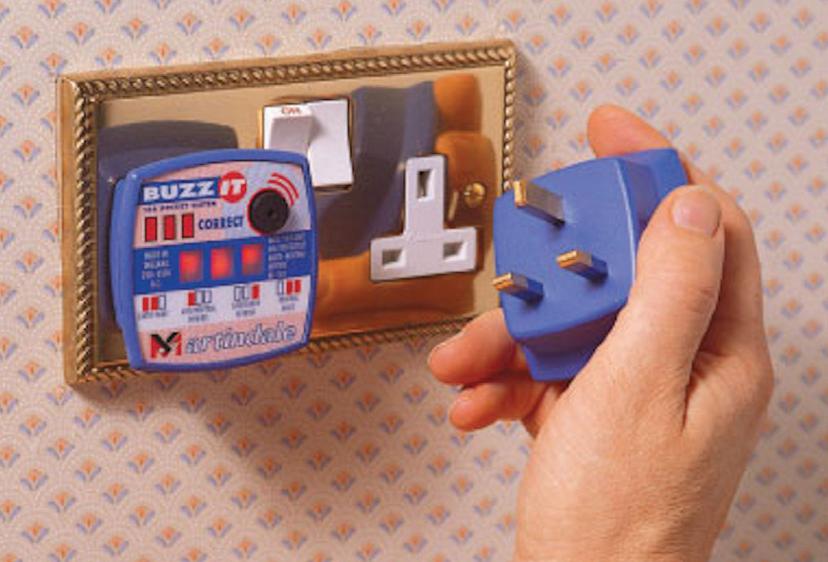
“In 2017 we moved to a new large facility – Metrohm House in Watford –bringing under one roof R&D, Service, Calibration and Sales in a modern eco-friendly building, enabling the best integrated support to the customer base,” explains Steve.
Today it’s fair to say Martindale Electric is one of the leaders in Safe Isolation, offering a comprehensive range of electrical test equipment and support to meet the varied needs of customers.


“Electrical safety is fundamental to Martindale, and the company’s commitment to developing,

46 July/August 2023 PROFESSIONAL ELECTRICIAN TEST EQUIPMENT & TOOLS
manufacturing and supplying the most trusted, safest and reliable solutions while ensuring value for money has made it one of the most respected brands in the industry,” says Steve.
In the 2000s, Martindale continued to expand its range by product innovation and acquisition, and the catalogue now includes over 270 products. A wide range of safety products have been introduced, including the patented non-trip, no battery, no test button loop tester displaying PE, PN PFC & PSC –the EZ2500 –and the HandyPAT range, consisting three of the smallest, lightest handheld battery-powered PAT testers on the market.


“We’re proud to celebrate 95 years of providing electrical safety solutions to our customers,” Steve says.

“We remain committed to delivering the highest level of customer service and support, and will continue innovating and expanding our product portfolio to meet the evolving needs of the industry. We’ll also look forward to the centenary celebration that’s coming in 2028!”
BROWSE THE FULL MARTINDALE ELECTRIC RANGE OF PRODUCTS AT: WWW.RDR.LINK/EAT020
CONTINUING TO INNOVATE AFTER 95 YEARS

If further proof was required that Martindale continues to improve, adapt and innovate to meet the demands of modern day applications, two new advanced socket and non-trip earth loop testers – the EZ156 and EZ365 – have recently arrived, providing electricians or engineers who need to check mains sockets with a ‘must-have’ companion.
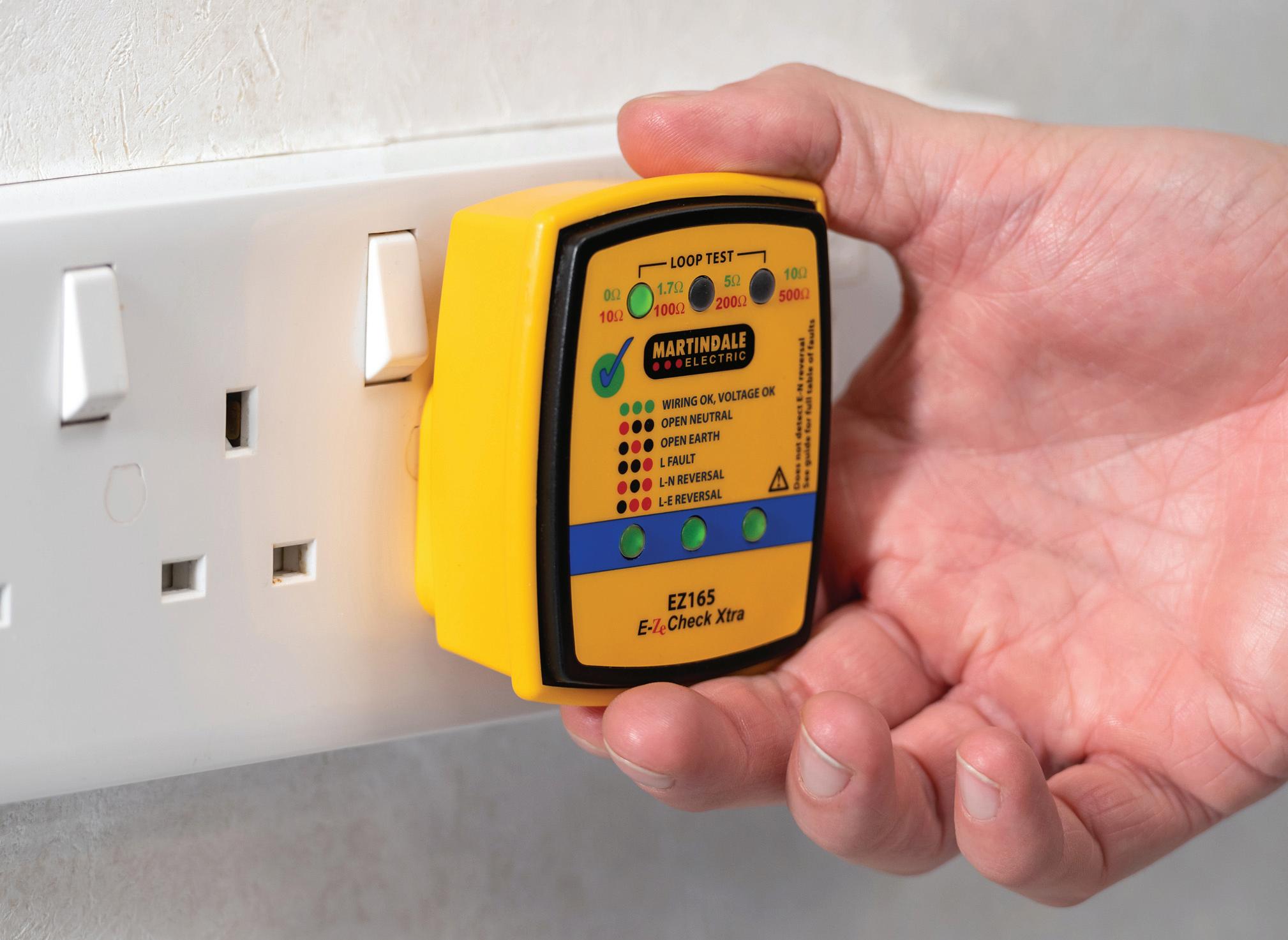
These conveniently compact but powerful testers detect 28 fault conditions, check the mains voltage level and show how safe the earth wiring is by carrying out a non-trip earth loop test and indicating its value in six discrete ranges. This test is critical for ensuring the safety of an electrical system, as a low earth resistance is essential for safety disconnection devices to work properly and prevent electrocution when faults occur.
The EZ165 and EZ365 testers have a variety of features to make fault diagnosis fast and easy. The combination of red and green LEDs quickly identifies neutral, earth, and live connections, and makes it easy to spot common faults. A look-up chart provides further fault diagnosis. The testers also indicate high and low voltage levels and their tough, sculpted design makes them easy to unplug, transport and use in a variety of environments.
The EZ365 model includes additional features, such as an incoming supply polarity swap test and the ability to trip test 30mA RCDs. The L-NE cross polarity test detects a serious fault condition that cannot be identified by many normal socket testers and is easily activated by using the touchpad on the EZ365. Faults are also indicated audibly on this model.

ADAPTER AND OVERCOME
Adapters that extend the capabilities of MFTs seem to have confirmed themselves as the big idea of the 2020s. Just look at the plethora of EVSE adapters that have come out since we launched ours a few years ago. The adapters all mimic a vehicle at a charge point for functional testing as well as giving access to the supply system for electrical testing. Luckily, Metrel testers also had the capability of remote firmware updating so tests like the 6 mA dc breaker test could be introduced without having to replace the instrument.
Ring’s true
Continuing this trend, Metrel has introduced a ring continuity adapter (A2214) to streamline the process of ring final circuit measurement. It has been well received by customers who work alone as well as those who are under great time pressure.
Both the adapter and the mains plug BS1363 test lead are nulled, and the results are committed to the tester’s memory. Once done there is no need to repeat the nulling until something changes, like the croc clips or test lead are replaced, changing the resistance of the test system.
Testing is now quite a simple process. The adapter is connected to the tester which is in Rlow, RING mode. For the end
to end continuity, the test parameter is set as r1, r2, rN and the test leads are clipped to the circuit in-comer and out-goer. The button is pressed and almost immediately all three results are displayed. The screen can then be saved for later reference.

The adapter is disconnected from the tester and left at the consumer unit where it will make all the connections required while you test around the ring. The calculated values of (r1+rN)/4 and (r1+r2)/4 are displayed while R1+R2 and R1+RN are measured and displayed for each outlet and the highest value retained. The adapter and tester communicate along the conductors to make the appropriate connections at the right time, often referred to as ‘the figure of eight’.
Not only does this process make it a one man job, it’s also much quicker. The free firmware update has been written for the MI 3100, MI 3125, as well as the touch-screen MI 3152 and MI 3155.
If you work with 3-phase supplies, Metrel has another adapter for you. By automating the testing the 3-phase active switch A1507 makes it faster and safer for you.

You only need to make the connections between the switch and the installation under test once, and connect the active
switch to either of the touch-screen testers. The tester controls the active switch, making and breaking connections as required, to run through a suite of measurements under your expert supervision from a safe distance. For example, the ten insulation tests required are initiated with the single press of the test button, each result being automatically committed to the tester memory for review, approval and certification.

VIEW THE METREL A2214
RING CONTINUITY ADAPTER PRODUCT DATA SHEET AT: WWW.RDR.LINK/EAT021

TEST EQUIPMENT & TOOLS
PROFESSIONAL ELECTRICIAN July/August 2023 49
Mock up to show the ring circuit end to end continuity measurement for r1,r2 and rN performed simultaneously.
Measurement of R1+R2 and R1+RN while the adapter performs the switching at the consumer unit.
Brendan Beaver, Manager of Metrel UK, looks at why the advent of adapters means that you can tailor the functionality of your test system around your requirement, without buying more than you need.
3-phase active switch and multifunction tester 3155 ready to save time improve safety when testing an industrial installation.
Investment in advanced portable appliance testing technology is enabling a manufacturer of custom-made personal computers to improve its safety testing protocols during production cycles. We learn more.
PC Specialist designs and manufactures a range of high-spec PC and laptops, primarily for the consumer gaming market, at its manufacturing centre in West Yorkshire. There, upwards of 5,000 bespoke systems are designed and produced monthly for the rapidly growing global gaming market as well as supplying several major UK electrical and electronic goods retailers.
The company is using an Apollo 600+ from Seaward as part of a quality control programme to ensure that in-house electrical power connection leads and monitors are safe to use and perform to optimum output levels.

Manufacturing operations can see hundreds of test monitors running concurrently during peak production periods with over 180 power leads safety checked and tested daily using the portable Apollo 600+. This involves completing a series of continuity tests, 500 V insulation tests and cable insulation resistance tests following visual inspections of each lead to ensure compliance with IEC 60502 regulations.
The Apollo 600+ carries out all of the electrical safety tests required under the current edition of the IET Code of Practice, with the instrument automatically sequencing through the required tests, which can include earth continuity, insulation resistance, protective conductor current, touch current, IEC lead polarity and RCD trip times.
IT’S EASY PC
This lightweight, versatile and compact tester, together with a Seaward Elite test and tag printer, is carried from one production cell to another at PC Specialist to undertake each safety check. After a test is complete, a bar code label is printed off and attached to the lead to confirm that it is safe to use, complying with health and safety requirements.
Improved standards
The incorporation of a large internal memory supports data handling needs, allowing the user to upload test records and transfer them directly to a central database on their PC as/when required. The use of these features is completed with the production of test labels, certificates and reports to demonstrate full compliance with in-house safety management and quality protocols. This approach has led to PC Specialist establishing improved practices and standards across its manufacturing operations during product build phases, delivering a fully automatic and integrated electrical safety testing regime for every unit that leaves the factory gate.
The tester is also used to check the in-service safety of dozens of other electrically powered items across the

company’s factory site as part of an ongoing asset management and maintenance programme.
Maintenance Engineers, Craig Lindley and Graham Williams, who are responsible for electrical safety testing, said: “We’re 100% committed to safety –it’s of paramount importance to us. We therefore take our compliance responsibilities seriously, which is why we’ve invested in a high performance, extremely capable portable appliance tester as part of our quality control and safety commitments.
“Quick and easy to use, the Apollo is capable of meeting the demands of a busy production line and rigorous testing regime. We really appreciate its portability and capacity to integrate testing swiftly and seamlessly with asset identification and record keeping. This enables us to undertake our responsibilities efficiently and contribute effectively to the overall running of the factory.”
The Apollo 600+ and PATGuard 3 test results management software forms part of a comprehensive range of Seaward PAT instruments, accessories and software that have been specifically designed to meet the needs of electrical safety duty holders in all workplaces.

TEST EQUIPMENT & TOOLS
WATCH THE SEAWARD APOLLO 600+ SERIES OVERVIEW VIDEO AT: WWW.RDR.LINK/EAT022 50 July/August 2023 PROFESSIONAL ELECTRICIAN

DEMAND OVER DIVERSITY
The energy balance within modern properties is constantly changing. This has been further accelerated by the current ‘cost of living’ crisis, with the trend towards more home working also having had a notable affect.
The old idea was that a ‘normal’ house would have two ring final circuits, two lighting circuits, one immersion heater, one cooker and one shower. However, this stereotype has been blown apart with the efficiency improvements of heating appliances and availability of low energy electrical equipment, and that’s before we factor in PV, EV, heat pumps and other green technology.
So, how do we go about accurately determining the maximum demand for a property such as a small flat, and what if we have five flats all fed from the same supply?
The complexity of the diversity calculations required, the fact that the figures in the IET On-site Guide are out of date now, and the large margins for error built into these calculations, make this a daunting task for any electrician.
Case study example: Electraworks This was exactly the dilemma faced by West London based Mark Crowdy of Electraworks during a recent customer visit.
Mark’s customer owns a large town house in Richmond, London that had been
converted over 50 years ago into five flats. The existing 100 A single phase service to the property had been split by the DNO into a 6-way single-phase supply, five flats and one landlord’s supply for communal areas. This installation had worked very well for the last 50+ years with no known overloading issues.


However, recent works had highlighted that the old service head and tails were looking their age, and conversations with the DNO were underway about updating the supply. This then raised another dilemma: would the existing 100 A single phase supply be sufficient, or would a larger three-phase supply be needed?
Faced with the responsibility of advising his customer, and the huge cost implications of having a new, larger, DNO supply connected to the property, Mark knew he needed to obtain accurate and reliable maximum demand data.
After some online research he reached out to Chauvin Arnoux UK, who listened to his application and specified a PEL, power and energy logger, along with a 1-metre-long flexible current sensor which was capable of looping around all six tails at once, and therefore capturing the total current in them all.
At a site visit a few days later, the PEL was set-up and installed. This was a quick and easy process and involved no interruption of the supply, or disruption for the tenants. The PEL was set to log current for a period of 12 days to capture the full range of loading on the property and locked safely away in the utility cupboard. By performing this activity in the colder weather, the results would include any heating loads that might not be present in the summer months.
The initial results seen on-site for the few hours CA UK was there were interesting, with the highest recorded
TEST EQUIPMENT & TOOLS
52 July/August 2023 PROFESSIONAL ELECTRICIAN
In this case study article, we discover how the use of energy logging equipment helped an electrical business to save its customer a fortune in unnecessary costs.
current being just 39 Amps.
Mark returned to Richmond 12 days later to retrieve the PEL and was soon on his way back to his office to review the over 280 hours of logged data.
Would the log reveal that the 100 A main fuse/cut-out was overloaded and an expensive and disruptive upgrade to the supply would be required, or would the results show the supply as being adequate and only therefore requiring updating at the expense of the DNO?
Analysis of the logging data was a simple process using the PEL Transfer software, which displayed Mark’s current log sampled every second both as a table of values, and as a current vs. time graph.
A graph of the total log (see image, right) showed the maximum current drawn from the supply during the logging period was 48.83 A, which occurred at 19:12:47 on 9th February 2023. This event spanned a period of approximately two minutes. The average current drawn from the supply during the logging period was 8.85 A.

The data showed that the maximum current drawn from the supply, during the 12-day logging period was less than half the 100 A main fuse/cut-out rating, and far less than the textbook diversity calculation would suggest.
Mark was able to create a report for his client detailing his findings and confirming that the installation was indeed operating
well within its supply capacity, and a larger supply wouldn’t be required. Great news and a significant cost saving for them!
BROWSE THE CHAUVIN ARNOUX RANGE OF POWER-ENERGY LOGGERS AT: WWW.RDR.LINK/EAT023


YOU’VE GOTTHESOLAR POWER!
Rob Barker, Director of Power Quality Expert, assesses the future landscape for solar PV installations and identifies the key characteristics that test equipment must contain to help installers comply with the requirements.
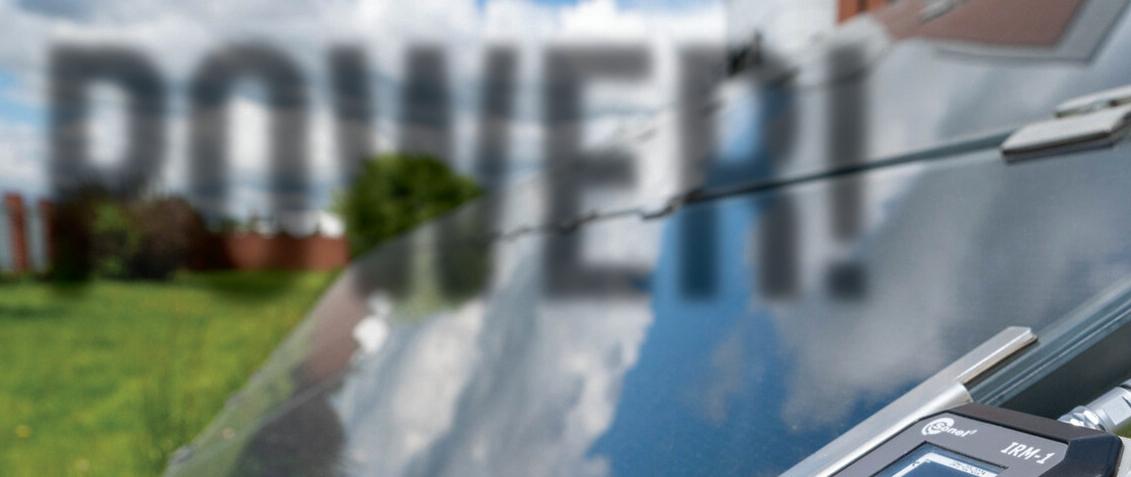


The rapid and dynamic development of photovoltaic installations that has been taking place in the world in recent years is impressive. This is largely due to the departure from traditional, non-renewable energy sources.
Greater social awareness and a desire by government to encourage people and businesses to take responsibility for the climate around us has forced a shift in the energy sector towards green energy. Additionally, we’ve seen the technology constantly evolving, which is resulting in lower costs for consumers to adopt solar PV energy solutions.
This, combined with the constant increase in energy prices, makes an economic shift more favourable for the photovoltaic sector and is a key factor moving customers towards further investment in solar PV systems.
Business should boom
With the push for energy saving increasing it is important to remember that testing the safety of the photovoltaic
installation and the servicing of these installations is a growing business.
Because of this, it is vital that the installation complies with all safety requirements after installation and that its operation complies with the applicable regulations. We can only be sure of this by carrying out the appropriate test and inspections and periodic checks.
The requirements for these are described in Section 712 of the 18th Edition Amendment 2 along with the standard EN 62446. The standard also defines the method and scope of safety control of photovoltaic installations.
Measurements allow you to determine not only the safety, but also the efficiency
of a photovoltaic installation. The EN 62446 standard divides the tests into category 1 and 2 tests and additional tests.
Meters
that meet the requirements
A meter such as the Sonel PVM-1020 allows you to carry out all measurements for the obligatory category 1, which include:











● Measurement of open circuit voltage (for a single panel or a string of PV panels) up to 1000 V DC
● Measurement of short-circuit current (for a single panel or a string of PV panels) up to 20 A DC

● Measurement of the operating current of PV panels with the use of external clamps
● Polarisation test
● Measurement of insulation resistance of PV panels with a test voltage of 250, 500 or 1000 V, simultaneous measurement of two values (plus to earth and minus to earth)
● Measurement of resistance of protective connections and equipotential bonding with ±200 mA current
test equipment & Tools 54 July/August 2023 PROFESSIONAL ELECTRICIAN
Additionally, it is possible to perform measurements not included in category 1, which are found in everyday measurement practices. These are:
● RMS voltage of AC network up to 600 V and frequency
● Insulation resistance of AC circuits with the test voltage of 250, 500 or 1000 V

● AC current

● AC/DC power
● Low current resistance with audible and visual signalling
● Diode test with 200 mA current with automatic polarity detection
● Blocking diode test with 1000 V DC voltage
By measuring the parameters of the PV installation, such as the short-circuit current (Isc) or the open-circuit voltage (Uoc), you can quickly verify the correct connections of the modules in the string, their polarity and operation.
Measurements can be made for the entire
chain of panels or for a single module.
The continuity of protective connections and the grounding resistance on the DC side are measured in the same way as in AC installations. In the case of insulation resistance tests, the difference is that the measurements are carried out under voltage, therefore special care should always be taken.
The values of operating currents and power on the DC and AC sides must be checked during the operation of both installations. Based on these measurements, we will verify the efficiency of the inverter and compare it
with the efficiency declared by the manufacturer.
The manufacturer of the inverter will usually specify the parameters of individual elements of the PV system which are measured in STC (Standard Test Conditions: 25°C, 1000 W/m², AM 1,5).
For comparison purposes, solar installation testers like the Sonel PVM-1020 can automatically convert the results to STC conditions. This is done by the use of an irradiance and temperature meter such as the Sonel IRM-1.
Both of these meters cooperate with each other and normally work over long distance through radio link. The automatically transmitted data is then converted to measurement values of short circuit current and open circuit voltage referenced to the standard STC conditions.
 BROWSE THE SONEL PVM-1020 PRODUCT DATA SHEET AT: WWW.RDR.LINK/EAT024
BROWSE THE SONEL PVM-1020 PRODUCT DATA SHEET AT: WWW.RDR.LINK/EAT024

DON’T PUT
SAFETY INTHE SHADE
Professional tradesmen and women know that working on-site can be a hazardous business. Minor injuries are commonplace and more serious, long term injuries can often happen.
There’s a host of training, PPE products and information services available to keep us safety-aware and protected. But it isn’t just physical hazards in the working environment you should be conscious of, you also need to be aware of how the summer weather can
weather this year, but warmer working conditions can also compound the health and safety issues by creating an extra UV hazard for personal wellbeing.
Dressing right for the working environment you’re in is therefore very important – not only for working efficiency, but also for personal comfort and safety. Hard work in hot and humid conditions can not only be uncomfortable, but dangerous too. So when
moisture-wicking, and UV-protective workwear can play an important role. When choosing the right working clothes for a hard day’s work in the sun, there are three important factors that we all need to think about:


Garment fabric technology
Lightweight fabrics deliver better ventilation and dry faster once they’re wet from perspiration. Even though cotton is thought to be a lightweight fabric, its high absorbency makes it dry very slowly. LiteWork workwear is sustainably designed for working in warmer weather, using specially selected durable, lightweight fabrics for your comfort and safety.
Your body temperature

In warm, sunny working conditions, you need clothes with exceptional breathability and ventilation. LiteWork workwear uses stretchable fabrics with 37.5 Fabric Technology. Patented particles in the fabric help your body maintain an ideal core temperature –thermoregulate –by removing

PROFESSIONAL ELECTRICIAN July/August 2023 57 PRODUCTS & BUSINESS SOLUTIONS
Peter Dumigan, Managing Director of the Hultafors Group UK, looks into the latest summer workwear advancements and has
perspiration vapours before they can turn into liquid sweat. That means you can stay both cool and dry no matter how hot it gets. Sweat is the cooling mechanism of the body. The vapour needs to be released and ventilated away from your body or you will end up soaking wet – something you’re likely to have experienced if you’ve worked in non-breathable materials during hot days.
UV-protection
In sunny conditions, protection from the sun’s harmful UV rays is vital. A number of garments in the LiteWork collection use lightweight, densely woven fabrics that provide an excellent Ultraviolet Protection Factor rating of 40+.
Choosing the right types of clothing
For summer working, choose workwear that is designed to create a kind of climate control system for your body. Designed to help you stay cool, they should also have added UPV40+ protection to make getting the job done as comfortable and safe as possible.

Your legs
Shorts are fine in really warm weather and some working environments, but they won’t provide protection for your knees and lower legs. Work trousers made from heavy fabrics will get really uncomfortable and impractical, so think about getting yourself a pair of LiteWork trousers or shorts made with 37.5 Fabric Technology or stretchable fabrics that combine comfort with durability.
Your upper body
The last thing you need is for your clothes to get really wet through sweat, leaving you feeling uncomfortable and cold when the temperature drops. Staying comfortable and dry will keep you working efficiently. Get yourself some LiteWork topwear with its bio-based, anti-odour finish that works for you by pulling sweat away from your skin to keep you dry, your body temperature regulated and protected from the sun’s rays.
One eye on the environment
Just as the effects of plastic waste on the environment has been brought to the centre of consumer consciousness in recent years, so the problems caused by the disposal of clothing are also coming to the fore.
Snickers Workwear’s design and development has always been driven by continual research into user needs and experiences in a variety of working environments and weather conditions, but nowadays carbon footprint impact is a key part of that evaluation. It’s not just the physical demands on the body when working hard on-site or in sports and leisure activities which are drivers in Snickers Workwear’s research and development, it’s the physical demands that product manufacturing and disposal place on the environment that matter too.
So, if you’re thinking about what’s most practical and beneficial to wear this summer –for work or leisure –some of Snickers Workwear’s LiteWork clothing is dual-purpose and works hard in reducing our collective carbon footprints.
If its performance you need, check out
the upgraded lightweight and breathable 37.5 fabric in Snicker’s Workwear’s shirts and base-layer clothes. With superb cooling technology, they’re great for demanding tasks on-site as well as high intensity gym work, circuit training, jogging, hill walking and mountain-biking.
Verifiable Sustainability

But if you want to be more than just cool and comfortable at work this summer –and do your for bit for saving the planet –the ‘Verifiable Sustainability’ in Snickers
Workwear’s new T- and polo-shirts will suit you down to the ground. The brand aims to be at the forefront of sustainability in workwear which is why the new lightweight polo and T-shirts are made of 100% recycled polyester with a bio-based, anti-odour finish plus a smooth texture and efficient moisture transport for great working comfort.
While style, comfort and functionality have been key drivers in Snickers
Workwear clothing development over the years, fabric performance and sustainability is now central to the technical design of the garments, just as it is in performance sports and leisurewear.
The result is environmentally-friendly, ergonomically designed dual-purpose working clothes that are not only designed to meet the physical demands that tradesmen and women face at work but are also ideal for some sports and leisure activities. They’ll also reduce your carbon footprint too!

58 July/August 2023 PROFESSIONAL ELECTRICIAN
PRODUCTS & BUSINESS SOLUTIONS
BROWSE THE LATEST SNICKERS WORKWEAR ONLINE CATALOGUE AT: WWW.RDR.LINK/EAT025




SUMMER LOVING
Summer can be a very busy time for some trades, but not for others. For instance, the plumbing and heating sector often experiences a quiet period before the cold weather and ‘heating season’ returns in autumn. By following the same ideas, even those trades who suffer from a seasonal lull can still maximise the time now to prepare their business to prosper.
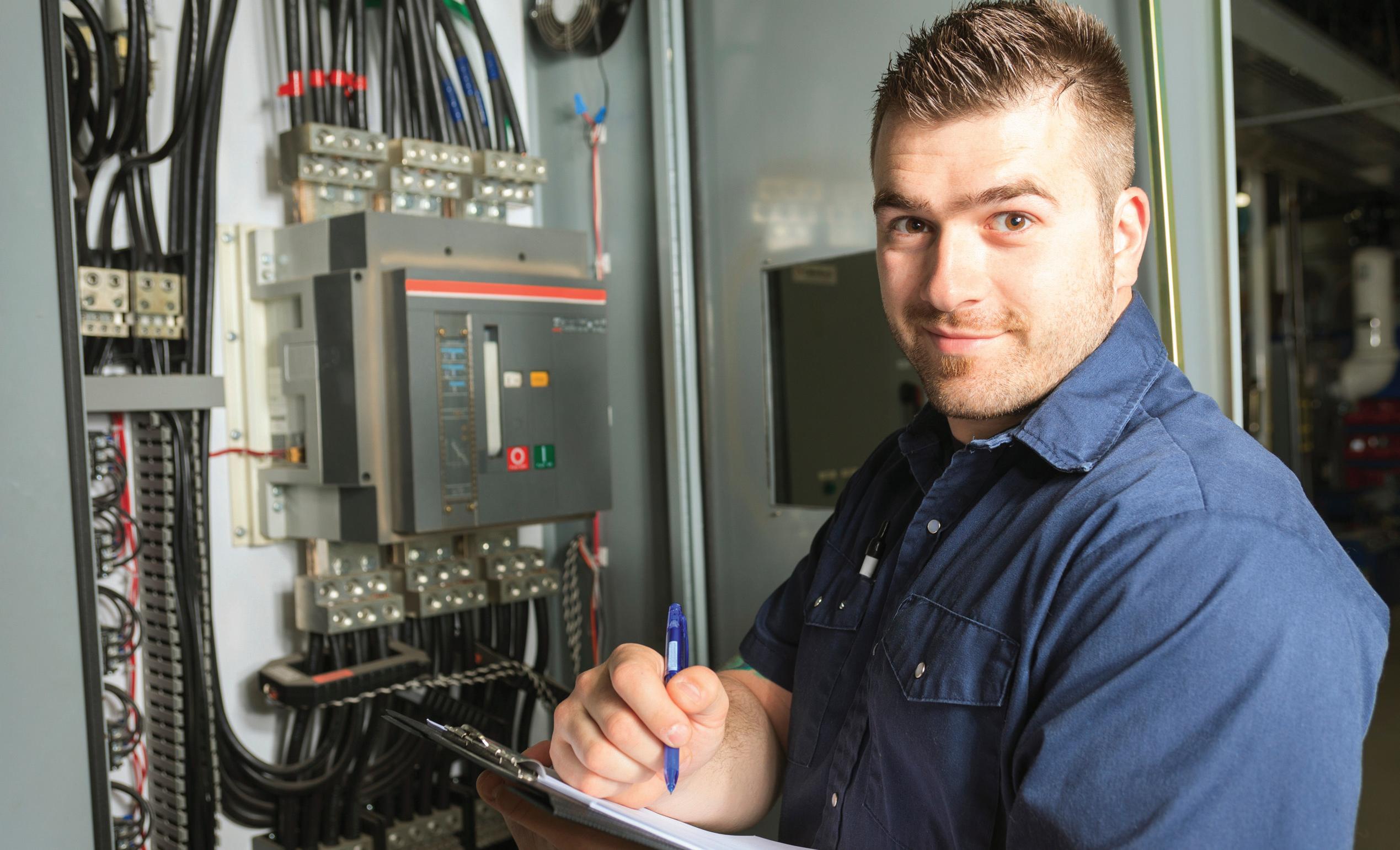
REVIEW YOUR BUSINESS PERFORMANCE
To grow and maintain your business successfully, you need to know which areas you can improve upon. Reviewing your business performance allows you to gauge your achievements and milestones.
At the same time, check your customer satisfaction levels. Collect any feedback and see where you’re kicking goals and where there may be room for improvement. Review your client list. How many new customers did you get? If your client list isn’t growing, it may indicate that you need a new marketing strategy.
this summer. 1 3 2
where you are right now and where you want to be by autumn. Your business goals for summer can be as simple as having a specific number of clients on your books or identifying the amount of profit you want to make.
SCHEDULE JOBS AND PLAN EFFICIENTLY
Trying to juggle too many jobs at once, with no visibility across each team member’s movements throughout the day and every member of the team running an individual calendar, can mean scheduling conflicts occur. If you’re also unsure which materials are in stock, on backorder or with a supplier, you have yourself quite the headache.
By using a centralised scheduling system such as Fergus, you can take complete control of your schedule by assigning tasks to team members or clients, matching calendars with individual projects, viewing the progress of a job in real time, and breaking big jobs down into separate tasks. With this visibility across the whole team, you can maximise working time and profit.
SET YOUR BUSINESS GOALS FOR SUMMER
Setting a goal brings everything into perspective. It’s a way to assess
and age and can be a brilliant ‘shop window’. If you’re a small business and don’t have a website or haven’t updated it in years, now’s the time to revise it. Maybe you’ve updated your brand logo or perhaps you offer more services than what is currently listed on your webpage. Use a service like Wix.com or GoDaddy to help you.
TOUCH BASE WITH CUSTOMERS
It’s important to plan your holiday time –after all you work to live, not the other way around. Get in touch with your clients to let them know of your holiday operating hours and when you’ll be back on deck.
Explain who to call instead or provide them with a call-back form/waitlist on your website where they can leave their details for you to get back to them once you return to work. If you have business management software, set up an out-of-office automated text and email to let your existing customers know that you’ll be away and on which date you’ll be back at work.
DUST OFF YOUR WEBSITE
Tradespeople often rely solely on referrals and word of mouth. However, a website is still vital in this day

5 4
FOR MORE INFORMATION ABOUT FERGUS AND TO ACCESS A FREE TRIAL, VISIT: WWW.RDR.LINK/EAT026
PROFESSIONAL ELECTRICIAN July/August 2023 61 PRODUCTS & BUSINESS SOLUTIONS
Fergus, the job management software specialist, gives its five simple tips for trade business owners to get their company ready to bloom
With revisions to the RoHS Directive (Restriction of Hazardous Substances) coming into force, Mike Collins, Director of Operations at Ovia, looks at the implications of the ban on fluorescent lamps for contractors and installers.
R O HS DIRECTIVE –ARE YOU PREPARED?
The EU published its review of RoHS exemptions on mercury containing lamps on 24th February 2022 in the Official Journal of the European Union.

In accordance with the amended RoHS directive, compact fluorescent lamps with plug-in bases and all T5/T8 fluorescent lamps may no longer be placed on the market in the EU as of the dates outlined later in this article.
Our industry then awaited confirmation of the UK timetable, and on Monday 30th January 2023, DEFRA published the Secretary of State’s determination applicable to England, Scotland and Wales on the government’s website. The lamp type exemptions mirror the EU, but with extended implementation timescales as outlined here.
The EU phase-out date for all compact fluorescent lamps with plug-in base (CFLni) is 24th February 2023, with a GB phase-out date of 1st February 2024.
The EU phase-out date for all T5 and T8 (2’, 4’ and 5’) fluorescent lamps in ring form is 24th August 2023, with a GB phase-out date of 1st February 2024 for T5s and 1st September 2023 for T8s. T8 fluorescent lamps in other lengths have an EU phase-date of 24th August 2023, with
a GB phase-out date of 1st February 2024.
The aforementioned lamps cannot be placed on the market from the stated dates; however they may still be available from suppliers until stocks are exhausted and the industry has been planning to navigate these changes.
As far as the compact fluorescent lamps with plug-in base are concerned, the following Ovia downlights from the commercial range will make ideal alternatives: Sprite commercial aluminium LED downlight, E-Sprite Eco commercial LED downlight, Polypanel LED recessed downlight, Alupanel LED IP44 recessed downlight and Inceptor Apto LED adaptable downlight with CTA Switch.


The focus for alternative light sources is currently on LEDs as they offer decisive advantages compared to fluorescent lamps. Ovia has been working with its customers to facilitate a smooth transition to alternative lighting luminaires to ensure they have the stocks needed to meet the ongoing demand from contractors, designers and specifiers.
Ovia has an LED replacement for virtually every lamp type and with the company’s extensive commercial and utility ranges, there are ideal alternatives to the phased-out products.
LED luminaires from the Ovia utility range that would be recommended as alternatives to the T5 and T8 fluorescent lamps include the Inceptor Duo up and down dimmable linear luminaire, Inceptor U-Lite compact, non-corrosive luminaire, Inceptor B-Lite linear batten multi-current LED light, and Inceptor A-Lite 4ft and 5ft College LED linear batten.
One thing is certain –the RoHS ban on inefficient light sources will result in the increased availability of energy-efficient alternatives. This, in turn, will ultimately help to reduce energy consumption and costs, both in domestic and commercial environments.
BROWSE THE OVIA ONLINE CATALOGUE AT: WWW.RDR.LINK/EAT027
products & business solutions 62 July/August 2023 PROFESSIONAL ELECTRICIAN
“One thing is certain –the RoHS ban on inefficient light sources will result in the increased availability of energy-efficient alternatives.”
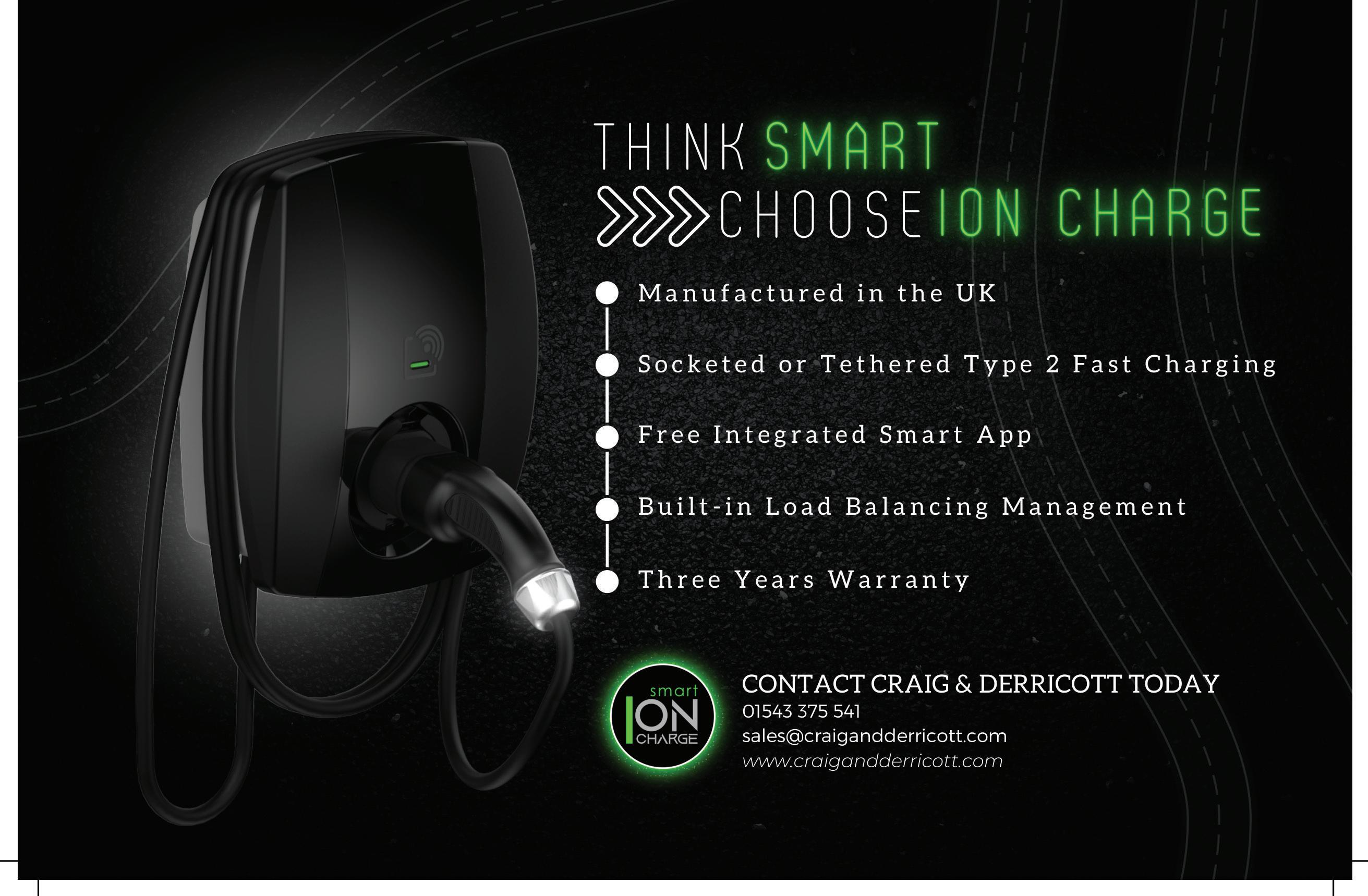

Ground Control
the warmer weather and longer evenings, All LED is empowering garden owners to transform their outdoor areas into captivating and enchanting spaces. We find out more.
Tfor all of us, especially during the summer. To this end, the use of lighting in the correct way can help to create a fine balance between ambience and functionality in this outdoor space. Among the myriad of options available, ground lights have gained popularity for their ability to enhance the beauty of landscapes very subtly and highlight architectural and natural features.
Ideal for garden projects
When it comes to ground lights, one company that really stands out is All LED. Renowned for its innovative and reliable lighting solutions, the selection of IP65 and IP67 rated ground lights offer an exceptional choice for garden lighting projects. Rated at between 1 and 7W, the 350ma low voltage circuit can be as long as 200m in 1.5mm cable so large projects are well suited to all of the luminaires on offer from All LED.
One of the most significant advantages of the IP65 ranges of ground lights is their remarkable durability and weather resistance. The IP65 rating


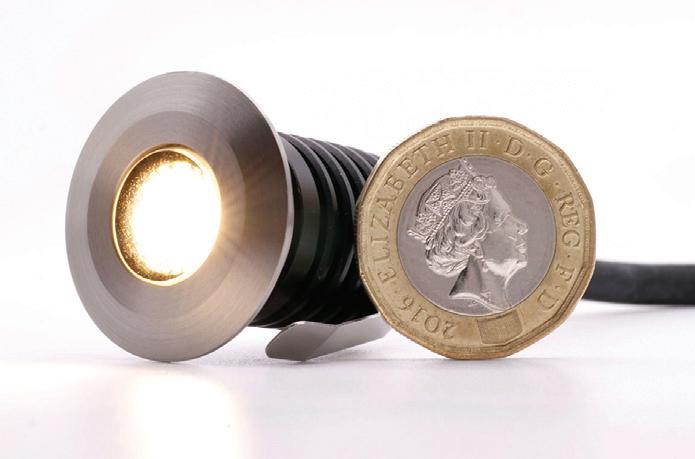
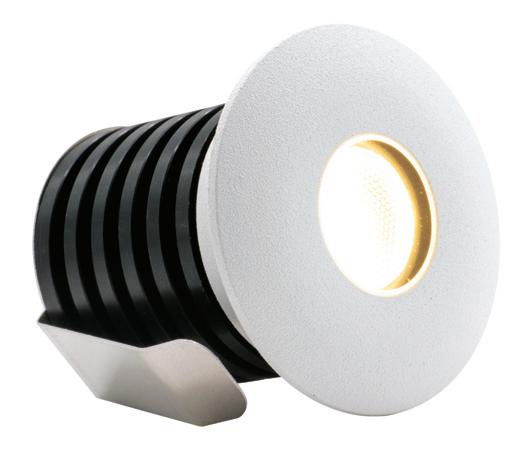
indicates that these lights are completely protected against dust and water jets from any direction.


As for the IP67 rated ranges, they ensure a robust level of protection against dust and temporary immersion in water, making them a reliable choice for applications where durability and resistance to environmental elements are essential, such as salt water.


These features make both ranges ideal for outdoor installations, where exposure to the elements is inevitable. Whether it’s heavy rain, dusty conditions, accidental splashes or, in the case of the higher rated products, temporary water immersion, these ranges will withstand the test of time, ensuring years of reliable and uninterrupted operation.


products & business solutions 64 July/August 2023 PROFESSIONAL ELECTRICIAN
Great outdoors
The robust construction of the different ranges of ground lights ensures their suitability for a variety of garden settings. These lights are specifically designed to be installed in the ground, offering seamless integration into pathways, walkways, driveways, flower beds, and other landscape features.
Their low-profile design not only enhances safety by preventing tripping hazards but also allows them to blend seamlessly with the surrounding environment, providing a visually pleasing lighting effect, without sacrificing on the 2 tonnes drive-over rating.
In addition to their functional aspects, All LED’s ground lights also provide exceptional versatility in design. The company offers a wide range of styles, finishes, and beam angles, allowing customers to select the perfect lighting solution for their specific garden project.
Stand out products include the Halo with its innovative anti-glare ring of light, or the tiny yet powerful Britannia which comes in 316L stainless steel as an optional finish,
giving it a full IP67 rating. It’s the diameter of a British pound coin, yet offers a powerful narrow beam angle.



Whether aiming for a contemporary, minimalistic look or a more traditional ambiance, All LED ensures that its ground lights can cater to diverse design preferences, giving garden enthusiasts the freedom to create their desired outdoor oasis.
A Noble decision
When embarking on a garden lighting project, it is essential to select products that combine style, durability, energy efficiency, and reliability. A good example of this is the Noble range, which comes in a variety of
sizes, lumen outputs, colour temperatures and offers a wide selection of bezel finishes. These lights check each of these boxes, making them an outstanding choice for illuminating outdoor spaces with their exceptional weather resistance, baffled light source, energy efficiency, and versatility.
Offering such a wide selection of ground lights including Halo, Noble, Marine, Midi, Britannia and more, these are a remarkable addition to any garden lighting project. Their exceptional durability, seamless integration, energy efficiency, and versatility make them an excellent choice for both homeowners and landscape professionals.
By opting for these lights, customers can embrace the beauty of their outdoor spaces, knowing they’ve invested in a reliable and innovative lighting solution that will bring long-lasting illumination and ambiance for years to come.
BROWSE THE LATEST ALL LED LIGHTING BROCHURE ONLINE AT: WWW.RDR.LINK/EAT028

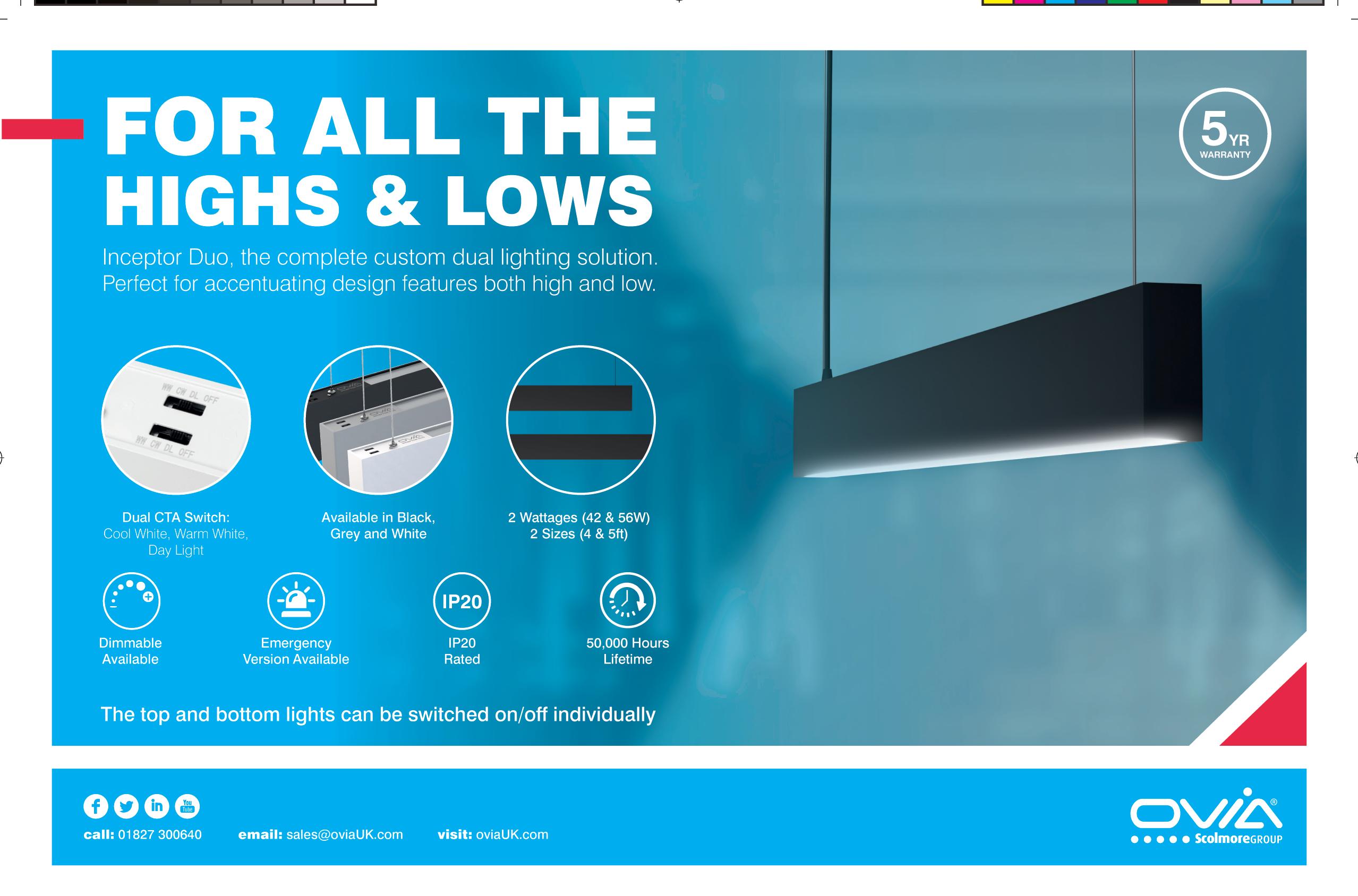
YOUR ONE-STOP SHOP

QHow has the BG SyncEV offering progressed since we last caught up with you?
We’ve continued to sell the popular original compact charger alongside our 7.4kW socket and tethered chargers, and have also introduced a number of supporting accessories to market. As the 2021 EV Regulations came into full effect at the end of 2022, we took significant measures to ensure that the entire EVS and EVT range of chargers were fully compliant.
QWhat, in your opinion, are the key features and functions required to make a quality EV charging solution?
Unless it’s installed in a garage the product is typically going to spend most of its life outdoors. Therefore, the top considerations are longevity, reliability, and living up to the stated IP rating. The outer material must be resistant to UV rays from the sun, and should remain free of water-ingress without causing internal heat build-up. These are all top design considerations that our range benefits from.
Another point is the ease of which the product can be installed. If it is overly complicated, such as badly placed connectors or screws that are difficult to access, it will mean installers may look elsewhere for a solution. Our design ethos is all about making the installation as easy as possible, and providing everything needed for a job in one box.
Our feedback also shows that customers would prefer to have an attractive (and small) unit that compliments the property
exterior, so we’ll be introducing the ability to swap colours on future chargers.
QDo you have any new launches on the horizon?
Firstly, we’re excited to announce the Wall Charger 2 – 22kW three-phase. This 22kW product can provide up to 3 x faster charging compared to a 7.4kW charger (three-phase power and a compatible car required), ensuring customers can take advantage of the increased charging speeds, and site-owners can benefit from the ability to install a larger number of chargers at one site.
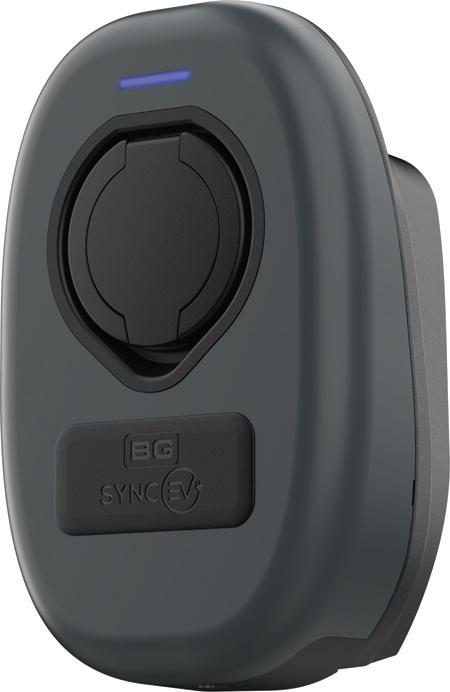

Although three-phase power typically exists at commercial premises, we’re also witnessing a rise of its use for private homes. By providing three-phase power as standard, forward thinking utility providers are able to perform load balancing across power-hungry sites and, in doing-so, forward their own journey of decarbonisation.
The product is, by default, powered by Monta which provides a user-friendly charging experience to residential users, and a commercial charging offering and management portal for premises that wish to manage paid charging and benefit from customised charging rates. The charger is compatible with a wide range of OCPP compliant management solutions and can be configured to work with these during commissioning.
We have socket and tethered 7.4kW Wall Charger 2 models launching after the 22kW, with further chargers and models planned for 2024.
In terms of accessories, we’ve recently introduced a range of EV charger stands that are compatible with our 7.4kW socket and tethered and 22kW charger. They’re available in a single and twin configuration, with an anthracite grey powder coated anodised steel finished for maximum durability. Additionally, we’ll be launching a range of Mode 3 charging cables and Mode 2 chargers in varying lengths and configurations.
To further cement our position as a complete solutions provider, we’ve also launched a range of metal consumer units in high quality cast-aluminium. The 10 available models are all surge protected, come pre-wired, and are populated with BG circuit protection devices. They’re available in IP20 (interior use) and IP65 (exterior use) versions.
PROFESSIONAL ELECTRICIAN July/August 2023 67 PRODUCTS & BUSINESS SOLUTIONS
THE FULL BG SYNCEV PRODUCT RANGE AT: WWW.RDR.LINK/EAT029
BROWSE
Nick Sutton, Product Manager for Smart/EV Charging at Luceco Group, updates us on the recent work that the BG SyncEV brand has been undertaking to improve its offering and casts a glance at what’s coming down the line in the future.
better IS not always bigger

There’s more to upselling than just making a bigger sale. It’s also about making a better sale – giving the customer a superior end result. In turn, that leads to winning their trust and repeat business, and generating the recommendations and good online reviews that are increasingly important in this business.
So far so obvious. Now your challenge is to be one step ahead of your customers’ needs, and to be ready with winning ideas.
As we enter the warmer months, the outside of buildings, security and courtesy lighting will stay in demand. You’ll probably come across a mix of customers who are after installations for the first time and those that have, shall we say, been disappointed with the basic installations they may have had and are ready to upgrade.

Customers who’ve been disappointed with reliability and performance in the past may well have been given standalone lights without any real attention to specification. Is the light too bright/too dim? Does the detection field cover the right area? Maybe they needed a floodlight that provided better illumination of a more accurate dretto zone? Would it make sense to add on slave lights so that neglected side alleys are safely lit up as well?
Mix and match
With the Timeguard LEDPRO Range you can mix and match floodlights of different powers with plug-in PIRs, or photocell or RF switches and use ready wired terminals to loop out slave lights. Now, you can also add security camera functionality with no extra wiring or installation time. Our LEDPROCAM unit pioneered that as an affordable combination by combining the PIR switch with a Wi-Fi controlled camera in ONE single unit that plugs into a floodlight.

If looks are the issue, choose products with better appearance – there really is no need to compromise as you can get pretty and tough in the same package. Why would you stick an old glass-fronted floodlight on someone’s wall when you can have low profile, windowless designs? Pure white versions, where available, will be almost completely camouflaged against a white soffit board.
In damp areas or coastal regions with harsher sea air, you can choose anti-rust-free designs to help avoid early corrosion or those tell-tale wall stains.

Never forget the popularity of low-profile bulkhead lighting either. It’s probably more popular in commercial settings but that doesn’t mean customers have to settle for utilitarian looks. With design options in round and oval die-cast cases, with and without protective cross
bezels, and polycarbonate lens designs, the potential for retrofitting to replace older models or installing from scratch is massive. You can also add automatic switching with outdoor PIRs.
Of course, not everyone wants floodlights, especially if their main priority is decorative and courtesy lighting. So for ‘front of house’, you might want to suggest carriage lanterns with the added value of automated PIR switching, and maybe choose half lanterns for flush fitting. Or you can recommend stylish black or stainless steel up/downlighters, with or without PIRs.
Just be sure to look for good quality black metallic or stainless-steel designs that will look good for years and make sure they’re adjustable so people can direct light where it is wanted. Looking ahead to summer, you could also offer an easy way of lighting decks and steps with no messy wall-channelling, as step lighting is another nice option.
products & business solutions
BROWSE TIMEGUARD’S 2023 PRODUCT CATALOGUE ONLINE AT: WWW.RDR.LINK/EAT030 68 July/August 2023 PROFESSIONAL ELECTRICIAN
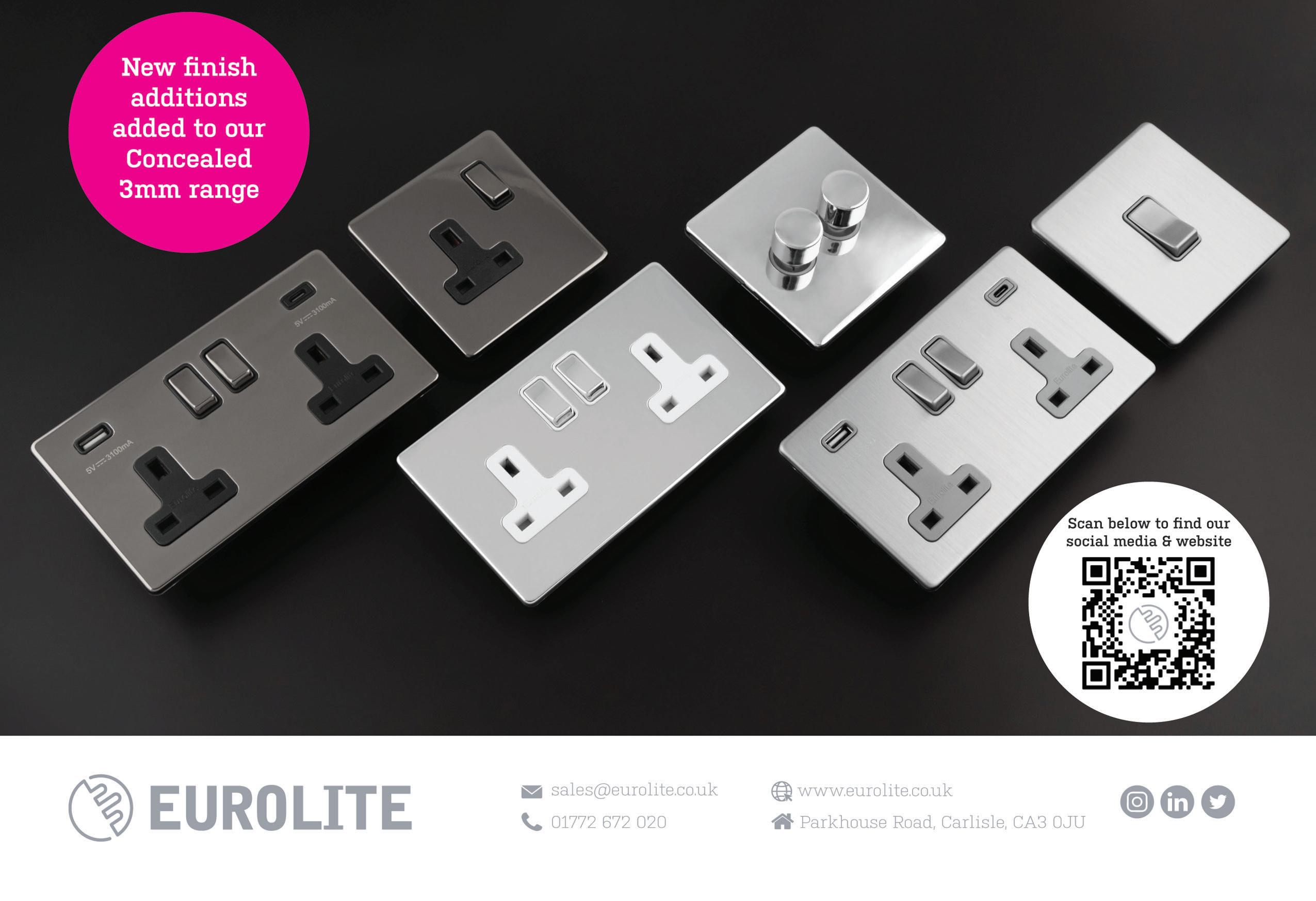

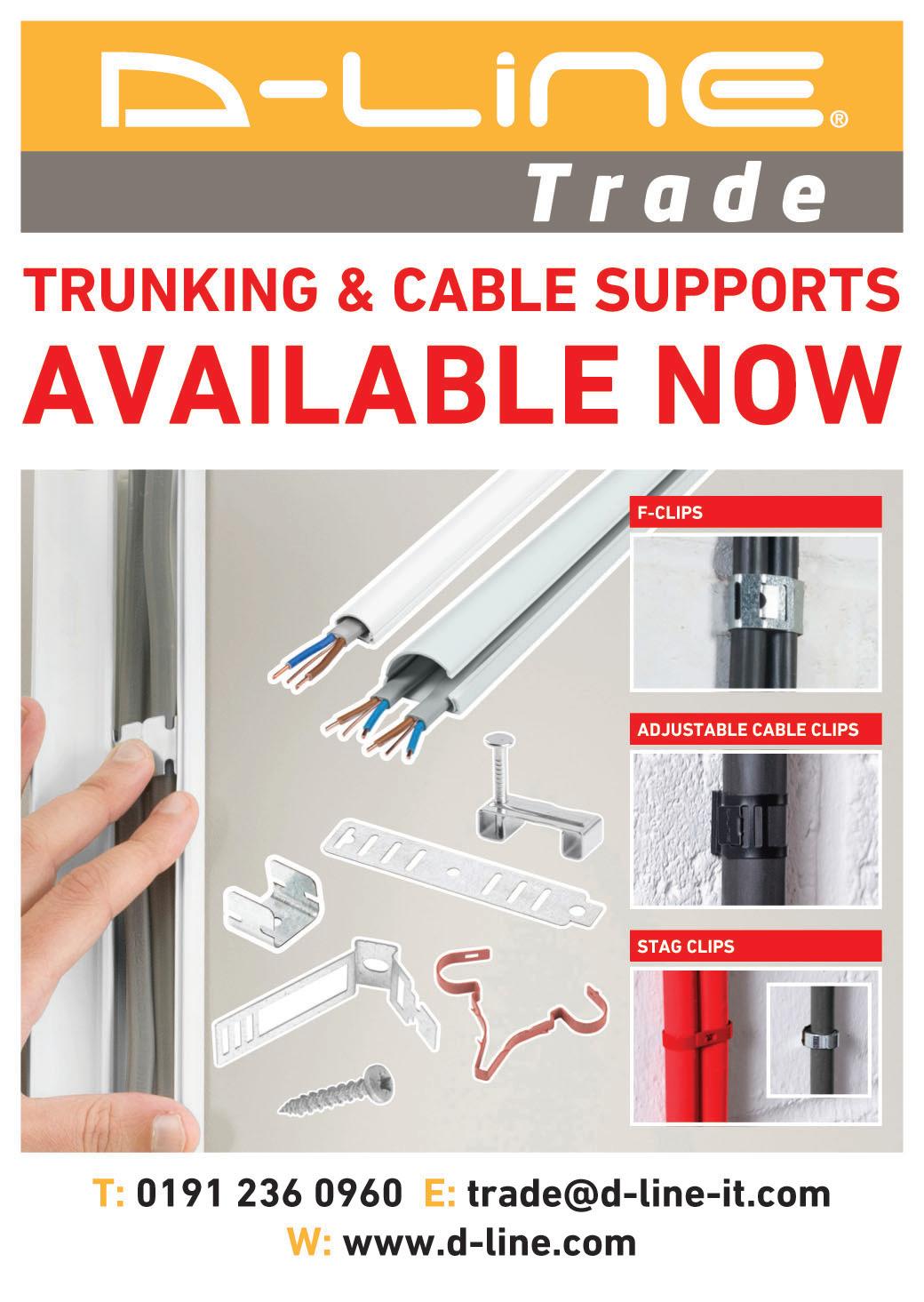
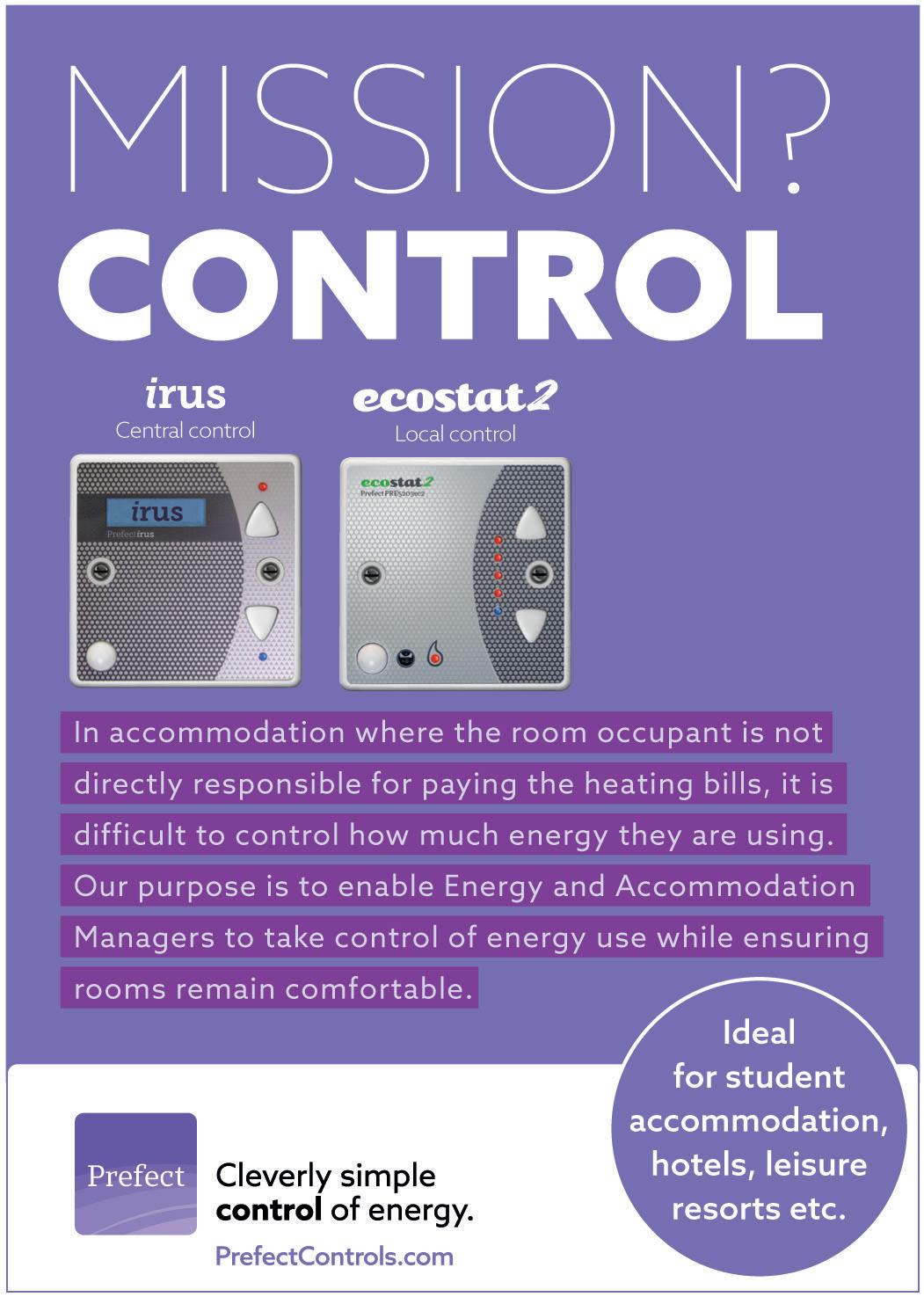

The Future’s bright as NVC slashes energy usage
Future publishes content and organises events that span specialist interests across a wide variety of topics for business and consumer audiences around the world.
MFM’s London office in Paddington is home to over 120 staff, many of whom work at basement level where there is no access to natural light. This means that the lighting is operating all day, every day so its output needs to optimise the illumination and ambience of the area. And, with the price of energy constantly increasing, it was a key requirement to attempt to cut their usage too.
Matt Grimsby, Commercial and
Operations Director at MFM, spoke to several suppliers who could provide products that appeared to meet these challenges, however it was NVC Lighting’s seven-year product warranty that gave him and Future extra confidence that the stylish and robust DALLAS IK06 LED luminaires would be the perfect solution.
He said: “We installed more than 70 of NVC’s DALLAS fittings in Future’s basement and will be using them across six further floors. The lux levels are brilliant and they have halved Future’s energy usage, which the company is over the moon about.”
Luceco’s attractive return for Qatar Central Bank
Luceco has recently supplied luminaires to the Qatar Central Bank located in Westbay, Doha.



The Qatar Central Bank founded in 1993, provides banking functions for the state and issues the Qatari rial, the national currency. The 30-storey building required a completely new energy-efficient and cost-effective lighting solution.
The refurbishment of the entire building was tendered under the supervision of the Arab Engineering Bureau Consultancy. Luceco provided a complete lighting design solution, demonstrating attractive return on investment calculations and offering energy efficient


luminaires that would also enhance the lit environment of the building.
Over 3,800 recessed LuxPanel luminaires were supplied to replace the existing 4 x 18 W conventional 600 x 600 fixtures along with Platinum, F Type and Element downlighters also installed throughout the building. Externally, linear IP65 Climate weatherproof luminaires were used in the service areas.
A well designed LED lighting scheme can offer substantial energy savings and cost-effective operation and allow the end client to build in Return on Investment (ROI) calculations to the business plan. Luceco’s team of qualified
NVC’s DALLAS luminaires can be surface fitted or suspended and can be used individually or joined together to form a variety of shapes including straight lines, Xs, Ls or Ts so that they can be an aesthetic feature of office environments as well as a practical, energy saving light source.

Matt continues: “NVC’s products are solidly built and very easy to install so both our team and the client are delighted with the outcome.”
BROWSE THE NVC LIGHTING CATALOGUE ONLINE AT: WWW.RDR.LINK/EAT031
lighting engineers can provide detailed project ROI calculations along with its complimentary Lighting Design Service.

BROWSE LUCECO’S LIGHTING CATALOGUES
ONLINE AT: WWW.RDR.LINK/EAT032
Products IN PRACTICE sponsored by www.electricalcharity.org
PROFESSIONAL ELECTRICIAN July/August 2023 71
DRAPER TOOLS 4-In-1 Combination Cutters
Draper Tools has added 4-in-1 Combination Cutters to its extensive XP1000 VDE tool range. There are four available – 160mm and 180mm, plus their tethered options. These great-looking pliers will make quick work of cutting, bending and stripping wires and shearing screws. The new 4-in-1 Combination Cutters are a super-convenient all-in-one side cutter, pattress screw shear, wire bending anvil and 1.5 and 2.5mm wire strippers. The 180mm pliers also shear 4mm conduit cover screws. Value for money, safety and efficiency is central to their design, but there has been no compromise on quality. The units are manufactured from premium steel and have induction-hardened jaws for long-term performance while the ergonomic soft grip handle allows maximum grip and user comfort. Forged in Germany, these 4-in-1 Combination Cutters and the rest of the XP1000 VDE range are tested to 10,000 V and suitable for use on AC circuits up to 1,000 V and DC circuits up to 1,500 V. Every tool flaunts patented safety features and is fully compliant with EN60900 standards. For extra peace of mind, the XP1000 range also comes with a lifetime warranty.

CED ELECTRICAL Updated Airmaster Cooling Range
Airmaster is long established as a key brand in air cooling with comprehensive ranges of table and floor fans, encompassing both premium and economy options to key products. A/C units have been added in recent years, with 2023 enhancements to both 9000 and 12000 BTU units now with quieter operation and complete with WiFi App controlled versions. There are three further major additions for this year, starting with a portable air purifier. This 22 W floor standing unit, for room sizes from 17 to 30m2, features a high efficiency filter and clear LED display. A similarly portable compact dehumidifier is next. Designed for quiet operation, this 12 litre refrigerant and auto frost detector is fitted with omni-directional wheels for ease of movement. The final new addition is a floor standing evaporation cooling tower, which cools air by water evaporation. With three fan speeds this unit has a remote control seven-hour programmable timer, with an auto pump shutdown protection when waterless.

V-TAC Solar Catalogue

V-TAC has unveiled its new solar catalogue, specifically designed to meet the needs of residential and commercial clients, allowing you to build a complete solar energy system with a single brand. This catalogue features a wide variety of highly efficient V-TAC Solar Panels with advanced design, textured surface, and a 25-year warranty for optimal power output, while the range of V-TAC Solar Inverters, Solar Batteries and Portable Power Stations are also featured. The catalogue provides in-depth details about product specifications and features to help professionals make an informed decision.
HOYLES Wireless Accessible Toilet Alarm




Hoyles has launched a new collection of wireless disabled persons assistance alarms. The range is available in kit form with both mains and battery powered controllers and battery powered ancillary items, making them perfect for retrofit as well as new installations. The new Wireless Aidalarm operates on ISM Bands with a 200m range in free space and up to 50m range internally. Battery status is monitored by the control panel. When the battery requires replacing, the control panel will indicate a fault ensuring that you’re never left unprotected. Everything is provided in the kit and all required batteries are supplied, delivering an effective, fully compliant, simple to install and easy to use system.

72 July/August 2023 PROFESSIONAL ELECTRICIAN Products round up GET MORE PRODUCT DETAILS AT: WWW.RDR.LINK/EAT033
GET MORE PRODUCT DETAILS AT: WWW.RDR.LINK/EAT034
BROWSE THE CATALOGUE ONLINE AT: WWW.RDR.LINK/EAT035
GET MORE PRODUCT DETAILS AT: WWW.RDR.LINK/EAT036
CHAUVIN ARNOUX
F65 Earth Leakage Clamp Meter

The F65 is the latest leakage clamp meter from Chauvin Arnoux that helps obtain accurate measurements when testing complex current waveforms through its integrated RMS technology. This state-of-the-art clamp meter has a wide frequency response (bandwidth) to include harmonic currents in its readings. It further simplifies the process of measuring leakage currents down to a resolution of 10 microamps with frequencies up to 3kHz. Its anti-harmonics filter makes the F65 clamp meter suitable for testing on switch-mode power supplies and other pieces of equipment, while its 28mm insertion jaws make the clamp extremely functional and resourceful for small and medium-sized conductors. Built and designed for the detection of leakage current and insulation faults, this advanced and pocket-sized F65 earth leakage clamp meter comes with high resolution and high immunity (70dB) to parasite current.
AICO



Ei3030 Multi-Sensor Alarm
The flagship alarm in Aico’s technologically advanced 3000 Series, the Ei3030 Multi-Sensor Fire and Carbon Monoxide (CO) alarm combines individual Optical, Heat and CO sensors for the ultimate fire and CO response. Product specifications include:

● Fire Response –The device contains a Thermistor Heat Sensor and high-performance Optical Sensor that intelligently work together, but will also operate independently.
● CO Response –The proven electrochemical CO Sensor provides an accurate CO response. The CO response is in line with BS EN 50291-1:2018.
● Visual Indicators –The Ei3030 has visual Fire and CO indicators. The relevant indicator flashes depending on what has triggered the alarm.
● Kitemarks – This device holds Kitemarks for British Standards BS EN 14604:2005, BS 5446-2:2003 and BS EN 50291-1:2018.
The Ei3030 also has a range of additional benefits, including built-in dust compensation technology, which reduces the risk of false alarms.
BROWSE THE PRODUCT DATA SHEET AT: WWW.RDR.LINK/EAT038
BROWSE THE PRODUCT DATA SHEET AT: WWW.RDR.LINK/EAT037
Heat up your options with Electric Series radiators
Stelrad has taken another major step in meeting the demands of its customer base across the UK and Ireland with the launch of a range of both steel and aluminium electric radiators – the Electric Series.

It’s the first time the Stelrad brand has ventured into the electric marketplace, bringing with it the quality and brand values associated with its radiator products since it began manufacturing in 1936.
The range will include a dozen or so different models with a number of sizes of each model available, with standard radiators for any room along with a selection of towel rails specifically targeted at bathrooms and en-suites.
Chris Harvey, Stelrad’s Head of Marketing for the UK and Ireland, says: “The new range offers a selection of radiators and towel rails with Stelrad’s unbeatable quality and design to suit every area in the home and to match or contrast with décor in every room.

“The selection includes radiators that are dry, dry stone and fluid filled offering a full choice of options within the technology. As you’d expect, the new range offers a variety of energy saving and comfort enhancing features with fitted and Wi-Fi enabled controls. Some of the new radiators will be ‘three in one’ options, featuring a fan heater at the base
of the radiator and manual controls that allow you to use the towel rail and the fan heater individually or together if you wish. Colours will be white for all radiators with the option of anthracite grey and chrome for some of the models.”
He continues: “Amongst the features you’ll find on these new radiators you’ll discover the ‘Open window’ function that enables the appliance to automatically detect when a window is opened near the towel warmer and to switch to ‘anti-freeze’ mode to prevent unnecessary heating and to avoid wasting energy. Similarly, it can
detect when the window is closed and restore the operating conditions set previously.

“The appliance comes on automatically at ambient temperatures below 7°C and, when the ‘child safety’ function is activated, the surface of the appliance is cooler than in normal operation in the currently active mode to avoid the risk of burns caused by brief accidental contact.”
Chris adds: “We pride ourselves on being a one-stop-shop for all things radiators and the arrival of the electric series builds on that claim still further.”
As well as offering effective, functional heating in the home, the radiators in the series are aesthetically appealing and provide attractive options for the décor in the home. They come with a five-year warranty on the heating parts and a two-year warranty on the electric components.
BROWSE THE FULL STELRAD ELECTRIC SERIES RANGE OF RADIATORS AT: WWW.RDR.LINK/EAT039
Products round up 74 July/August 2023 PROFESSIONAL ELECTRICIAN
Cables at home? Take the D-Line!


office, the question of how to plan new sockets has found a popular answer in D-Line cable management.


By combining speed, safety and style, D-Line’s decorative trunking makes surface mounted installations look attractive. This was the experience of Adam Stears of SOTA Electrical, when faced with a client who also did not want the hassle and disruption of channeling walls, then needing to redecorate.

Adam took power from a consumer unit, with T&E cable dropped vertically using D-Line 30x15mm 1/2-round profile. The self-adhesive tape made a useful guide, before securing D-Fix screws thru U30 fire-rated clips used for 18th Edition compliance. Next the trunking and cable followed the skirting, below the radiator, with the D-Line profile blending to resemble the natural top section of the skirting. The cables then fed up to D-Line 28mm deep surface boxes, and new sockets, that were located ready to accept the new desk.
For an extra smart finish, Adam fitted a D-Line Cable Shelf above the desk to provide a charging station for devices and a stand for a tablet or other device. These have a hidden cavity between base and lid - handy for hiding excess charger cables and keeping the desktop free of cable clutter.
Adam said: ‘D-Line’s latching hinged lid makes for easy handling, and helps to keep the cables in place, while the 30mm base makes it easy to accommodate U30 clips. The corners snap-on easily, while the push-out tab on D-Line’s surface boxes make a neat feature’

MORE DETAILS ON D-LINE’S
OF CABLE MANAGEMENT PRODUCTS
WWW.RDR.LINK/EAT040
GET
RANGE
AT:
M2 gets fresh with new accessory additions
M2 Electrical has launched a new range of electrical wiring accessories which have been rebranded with a fresh look, updated features, new ranges, and new products.
The M2 slimline range of white moulded wiring accessories boasts a stylish curved edge profile and a robust high gloss finish. New to this range are the fast-charging USB socket outlets, ensuring a rapid charge for all compatible devices, while there’s the option of a red rocker to compliment a white matching rocker variant across the range of 45 A double pole switches and sockets. Another exciting addition are the key lockable switches and sockets which provide the ability to restrict access to power, making them perfect for public areas and cleaning access points.

Manufactured from thermoset urea the range has been tested and certified with antimicrobial properties to inhibit the growth of harmful bacteria. Independently tested and verified, the slimline range is proven to kill off 99.99% of bacteria strains such as E-Coli and Salmonella.
All products go through thorough testing to ensure they’re reliable and durable, highlighting M2’s commitment to quality and safety standards. Another enhancement to the range is the ASTA-certified socket outlets, which meet rigorous safety standards and ensure peace of mind for customers.
In support of this commitment and to showcase the confidence M2 has in its
products, a 25-year guarantee is offered across the entire new range of wiring accessories.
All square
Another new development at M2 is the launch of a new range of square edge wiring accessories – M2 square. With a traditional look and feel, these accessories offer modern convenience and flexibility. Ideal for the domestic housing market, customers can create their own customized switch plate by mixing and matching modules to suit their needs.
Additionally, the M2 grid range offers a traditional grid system which is initially
available in the M2 slimline, metal and decorative screwless ranges and offers a comprehensive selection of modules to maximise on-site flexibility. The M2 grid modules simply clip into the grid yoke system and are just as easily removed, if required.
The range offers standard modules including the unique fan isolator switch and three position retractive switches. All applicable products have laser etched markings for a stylish and long-lasting finish.

At the same time, M2 has made significant improvements to its packaging, which is now made from recycled content. All cardboard packaging, plastic bags and even tape is made from recycled content and can now be recycled after use. The use of single-use plastics has also been removed from some ranges, replaced with more eco-friendly solutions.
BROWSE M2’S SLIMLINE RANGE OF PRODUCTS AT: WWW.RDR.LINK/EAT041
BROWSE THE ONLINE M2 ELECTRICAL ACCESSORIES


BROCHURE AT: WWW.RDR.LINK/EAT042

Products
76 July/August 2023 PROFESSIONAL ELECTRICIAN
round up
KNIPEX
Robust26 Move Tool Case

Made of impact-resistant polypropylene, this case is fit-to-fly, temperature-resistant, dustproof and waterproof, making it perfect for even the most demanding tasks and toughest operating conditions. When you need to move lots of tools safely, the new Robust26 Move tool case from KNIPEX (00 21 33 LE) is ideal. With an extendable, ergonomic handle, smooth-running wheels and an automatic pressure compensation valve, it is great for plane, train or van. It is also impact resistant thanks to its tough polypropylene shell and is temperature-stable from -30°C to +80°C. The interior of this flexible case consists of 19 tool pockets, 61 straps and a document compartment. The tool boards with the tool pockets and straps are made from dirt-repellent PP twin-wall sheets while the lockable base tray can be divided individually using an aluminium divider system.
CRAIG & DERRICOTT Smart ION Charge EV Charger

This new smart EV charger range from Craig & Derricott is made in the UK and offers excellent value for money. The secure and reliable, 7.4kW type 2 domestic smart electric vehicle charging units offer a simple solution for your EV charging needs. The range of mode 3 smart EV chargers are an easy to fit solution for residential locations and are available in both socketed and tethered options.
Key features include:
● Quick and easy installation.

● Free integrated smart mobile App that allows the user to see live and historical data and schedule charging sessions as required.
● Tamper-proof charging with push notifications to the App.
● Each charger is supplied with C&D’s load sensing device ‘IONsens’. This device will monitor the current power supply and adjust the load as required to prevent overloads of the property’s power supply when a vehicle is being charged.
NIGLON Surge Protection Device Kit

This single module Surge Protection Device Kit has been designed and tested for use with Niglon consumer units and enclosures. It has been developed for optimal performance and compatibility to be used in all UK earthing arrangements TN-C-S (PME), TN-S and TT earthing systems. The module is an IEC Type2/class II single phase device with the single module 40kA rated device needing no secondary back-up protection (provided Main Board Fuse <=125A) so takes up less ways in the enclosure. It comes supplied with 6mm2 neutral and earth link cables pre-crimped to allow simple and easy connection to complete the installation. The location of the incoming supply terminal means that it can be mounted directly on to the consumer unit busbar, making it a simple retrofit solution for any Niglon board or stand-alone enclosure. The unit also has a status (end of life/fault) indicator to show clearly if the module needs replacing. Should this be the case then the cartridge can be changed by simple removal without interruption of the power supply.
● TruePEN PME fault detection (no earth rod installation required).



● OCPP 1.6 and G100 compliant.
● Designed and manufactured to meet or exceed all the current and anticipated UK EV Charger regulations and standards.
The ION charge range has the confidence of being fully independently tested and approved to all current UK regulations.
GET MORE PRODUCT DETAILS AT: WWW.RDR.LINK/EAT043 GET MORE PRODUCT DETAILS AT: WWW.RDR.LINK/EAT044
GET MORE DETAILS ABOUT THE RANGE AT: WWW.RDR.LINK/EAT045
All about Evo as Hager enters the UK switchboard market
For the first time in its history, Hager has launched a factory-built switchboard offer combined with its own ACBs and MCCBs from its impressive Telford facility.
Meeting market expectations
By evolving the successful Quadro Evo platform, the Hager switchboard offer is now specific for the legislative needs of British Standards combined with the specific market and installer expectations.
Ian Smith, Country Marketing Leader, commented: “The driving force behind the subsequent creation of Quadro Evo has been a clear focus on these primary areas that we know resonate with the UK customers’ needs. This is a very specific development by Hager for the UK market and we’re thrilled with the outcome.
“By innovating and pushing what is possible, we’ve ensured that installers now have the freedom to create customised distribution boards up to 1600 A that can fit into the tightest on-site spaces. Ease of wiring has been a priority and the newly incorporated aluminium busbar no longer requires hole-punching to connect outgoing circuits. This saves precious on-the-job time and valuable costs.
“Combine this with our fantastic new range of Hager h3+ ACB and MCCB breakers, which are 100% Hager manufactured, and we’re really excited to be able to offer an outstanding solution to the UK market.”
In the field of electrical enclosures, internal separation plays a crucial role in ensuring safety standards. Quadro Evo is designed to comply with BS EN 61439-2 and provides tailored solutions to achieve the ultimate internal separation of busbars, functional units, and terminals, according to project requirements. This allows for a greater degree of choice in terms of Form 4a and Types 2 to 7 arrangements.


Quadro Evo’s scope goes beyond the enclosure system. The platform is capable of using the latest innovative h3+ Hager MCCBs and ACBs, providing highly precise energy consumption data to support sustainability efforts. The development of these devices involved a
significant investment program and marks a major milestone for Hager Technology. The Quadro Evo switchboard now enables the company to introduce these advanced devices to the UK market, which has been a long-term goal.
Independently tested
To ensure that Quadro Evo meets all regulatory standards, it has undergone independent third-party certification by ASTA. This validation assures users that the product has been objectively assessed for performance guarantees, safety, and application viability.
The launch of Quadro Evo in the UK is the result of over two years of dedicated teamwork and investment to provide a British Standard compliant solution that meets market norms and installer expectations.
BROWSE HAGER’S QUADRO EVO SWITCHBOARD RANGE
BY VISITING:
WWW.RDR.LINK/EAT046

Products
up
round
78 July/August 2023 PROFESSIONAL ELECTRICIAN
MK ELECTRIC/TREND CONTROLS
Connected
Sockets

MK Electric and Trend Controls have combined to launch one of the first fully integrated commercial solutions for effective remote monitoring and control of plug-in sources of power consumption.

Connected Power, the first collaboration between the two Honeywell brands, is designed to easily allow building and energy managers to monitor their site’s use of small power — which can account for more than 25% of a building’s energy. Comprising smart plug sockets and connectivity hubs from MK Electric, the Connected Power solution allows businesses to gain visibility into their buildings’ energy usage, remotely power down unused sockets and automate functions such as scheduling, grouping and alarms. Data is available down to an outlet level, providing more robust information and control of energy use in a building along with other site energy data such as heating, ventilation and air conditioning (HVAC) and lighting use.

PANASONIC HEATING & COOLING SOLUTIONS 2023 Product Catalogue
This comprehensive guide showcases the entire Panasonic range of HVAC+R solutions, designed to meet the needs of residential, commercial, and industrial applications. Latest technologies are included, such as Panasonic’s Aquarea K and L Generation heat pumps, while other catalogue highlights also include a focus on indoor air quality. Panasonic’s advanced nanoeX has been taken to the next level with air-e, its first stand-alone, ceiling-mounted nanoeX generator. air-e has a low power consumption and is ideal for a wide variety of applications where indoor air quality is a priority. A detailed technical resource, Panasonic’s product catalogues are a must-have reference tool for professionals, providing plenty of information on current technologies and services.





KNIGHTSBRIDGE Part M Range Additions
Knightsbridge has recently compiled a collection of wiring accessories ideally suited to environments where meeting Part M of the Building Regulations is a concern. The range covers safety, ease of use and hygiene, encompassing anti-bacterial switches and sockets and accessories dedicated for those with disabilities. At the heart of the Part M range is colour-contrasted, outboard rocker sockets, and high contrast and wide-rockered switches for both lighting and appliances. To assist people with visual impairments, socket chassis come in a striking anthracite finish with white rockers for contrast. This range satisfies recommendations that switches contrast with front plates, which in turn contrast with walls. By mounting the rockers on the sockets’ outboard edges, the risk of an accidental disconnection or contact with live pins is greatly reduced. Both one and two-gang sockets are available. Two-way light switches – again anthracite and white – come with single or two-gang wide rockers, or in traditional narrow format in one, two or three-gangs.
BROWSE THE KNIGHTSBRIDGE CATALOGUE ONLINE AT: WWW.RDR.LINK/EAT048
SWITCHTEC
Sirena SE120 Alarm Sounder
Distributed by Switchtec, Sirena’s SE120 new alarm sounder offers one of the highest levels of sound propagation available on the market, allowing the installation of fewer units to cover a larger area. The product is versatile and adaptable, available in different voltages, functionality, and colour versions. The SE120 has been designed to meet the need for industrial applications where robustness and high performance are required. It features 64 pre-configured sounds each with eight volume levels and a power range up to 120dB. Thanks to internal memory integrated on the PRO version, it is also possible to use customised messages on the four available channels, allowing the sounder to be fully configured to the individual needs. The SE120 can withstand the toughest working conditions with a protection rating of IP66/IP69K and impact resistance rating of IK08, ideally suited to the factory and industrial settings.
BROWSE THE FULL RANGE AT: WWW.RDR.LINK/EAT050 GET MORE PRODUCT DETAILS AT: WWW.RDR.LINK/EAT047
PROFESSIONAL ELECTRICIAN July/August 2023 79
BROWSE THE CATALOGUE ONLINE AT: WWW.RDR.LINK/EAT049
ESP gives access control range the V-IP treatment



ESP has added a new range of products to its Aperta access control portfolio.
The new Aperta IP PoE (Power over Ethernet) collection provides quick and easy to install door entry solutions for a wide range of projects, covering large apartment blocks to small commercial properties and domestic dwellings.
The new IP access control range is designed to offer more flexible installation and improved performance when compared with traditional ‘2-wire’ and ‘4-wire’ systems. The range comprises a visitor multi way and a single way outdoor station to suit a range of project applications, and a feature-packed video monitor to enhance user preferences, complete with App facility.
All devices are connected together via PoE switches, making installations convenient by removing the requirement to have a power supply per device. In
addition, the Aperta IP door entry system does not require programming software to configure the system.
At one end of the range is the IP PoE IP65-rated multi way outdoor station, which is capable of supporting 200+ apartments, and includes proximity fob and keypad function to release connected door locks, making it an ideal system for buildings housing multiple apartments or offices. For large projects contractors and specifiers are encouraged to contact ESP’s dedicated technical team for further information.
For smaller private or commercial projects is the IP PoE IP65-rated single way outdoor station, which also includes proximity fob and keypad release facility and can simultaneously call up to six video monitors.
Both outdoor stations are manufactured from an aluminium alloy offering a robust housing design solution
with a high impact rating. They feature HD cameras and full duplex audio to provide clear communication during a visitor call. The multi way outdoor station also has the additional benefit of a user-friendly 4” GUI display.
Screen time
The 7” monitors are available in a black or white housing option and feature a slimline, contemporary design. They offer Wi-Fi and LAN connection to support the various functions of the ClickSmart+ App, including the ‘Call Divert’ feature, which transfers calls to the App when a visitor calls from the outdoor station.
The monitors incorporate a user-friendly touch screen GUI monitor and offer full HD live view from the outstation’s camera, as well as duplex audio. They also include a monitor record function (microSD card required).
For smaller projects there are two Aperta IP PoE villa kits available and each comprises the IP PoE IP65-rated outdoor station, IP PoE monitor – in a choice of black or white – and an IP PoE 4 channel switch with two uplink ports.
ESP has produced a full colour brochure on the new IP range, highlighting the key features and benefits.
Products round up BROWSE OR DOWNLOAD THE ESP IP RANGE BROCHURE AT: WWW.RDR.LINK/EAT051 80 July/August 2023 PROFESSIONAL ELECTRICIAN
C AM E RA CAUGHT ON
KEV DOBBS: Years and years of previous installations in an old theatre, which is now a nightclub. Where do we start?
SOCIAL SNAPS!


OHMS ELECTRICAL SERVICES: The horrors you can find during an EICR! This consumer unit was live and in use!


LT ELECTRICAL: Spotted – it’s an outside socket!



NU ELECTRICAL: I thought I’d share with you guys this quality EV charger install that was found recently!
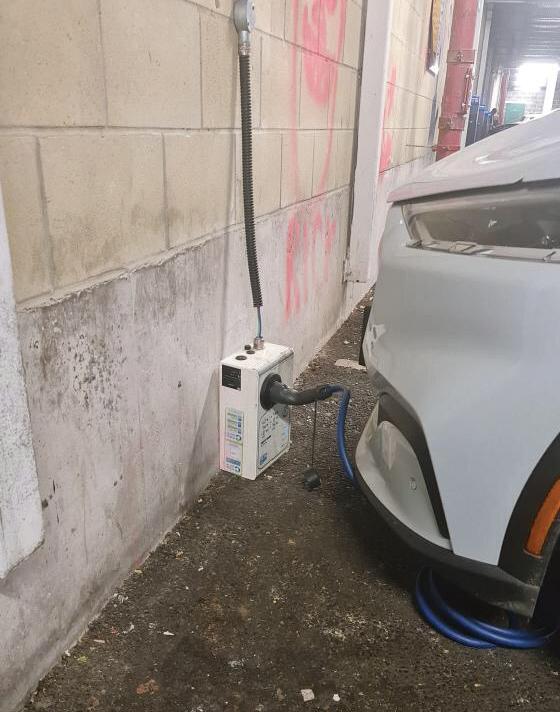
CKTINKA ROBERTS: This was found while carrying out an EICR. Who can spot the live 13 A socket hiding in the post box outside the house?

STEVE LUCKHURST: I was called to this site to investigate a tripping issue. I’ve not laughed at a customer in my 27 years as a professional, however you can imagine my face when the customer took me to the main board and said: “We have no idea what it could be!”

PROFESSIONAL ELECTRICIAN July/August 2023 81
ADVERTISER INDEX ALL LED Ltd .......................................inside front cover www.rdr.link/EAT100 BG SyncEV ...............................................................page 26 www.rdr.link/EAT101 BMS Electrical Training ..................................page 75 www.rdr.link/EAT102 Bright Business Advice ....................................page 73 www.rdr.link/EAT103 Carlisle Brass Ltd ................................................page 69 www.rdr.link/EAT104 Carl Kammerling International Ltd .........page 43 www.rdr.link/EAT105 CED ..............................................................................page 60 www.rdr.link/EAT106 CHAUVIN ARNOUX UK Ltd .............................page 55 www.rdr.link/EAT107 Craig & Derricott Ltd ........................................page 63 www.rdr.link/EAT108 C-TEC Ltd ..............................................................pages 6,7 www.rdr.link/EAT109 C-TEC Ltd .................................................................page 41 www.rdr.link/EAT110 D-Line (Europe) Ltd ..........................................page 70 www.rdr.link/EAT111 Draper Tools Ltd .................................................page 59 www.rdr.link/EAT112 Electrorad UK Ltd ...............................................page 11 www.rdr.link/EAT113 ELEX ........................................................inside back cover www.rdr.link/EAT114 Elite Security Products Ltd ...........................page 69 www.rdr.link/EAT115 FireAngel Safety Technology Ltd ...............page 17 www.rdr.link/EAT116 Hager Ltd .................................................................page 33 www.rdr.link/EAT117 HIKMICRO ...............................................................page 48 www.rdr.link/EAT118 Hoyles Electronic Developments Ltd ......page 37 www.rdr.link/EAT119 JCW Engineering Solutions Ltd ...................page 75 www.rdr.link/EAT120 KNIPEX Tools UK Ltd ........................................page 66 www.rdr.link/EAT121 Live Electrical Distribution UK Ltd .............page 4 www.rdr.link/EAT122 Luceco Group ........................................................page 29 www.rdr.link/EAT123 Makita (UK) Ltd ...................................................page 63 www.rdr.link/EAT124 Megger Ltd ..............................................................page 51 www.rdr.link/EAT125 Metrel UK Ltd ........................................................page 56 www.rdr.link/EAT126 Niglon Ltd .......................................................pages 12,13 www.rdr.link/EAT127 Ovia Lighting .........................................................page 66 www.rdr.link/EAT128 Power Quality Expert .......................................page 53 www.rdr.link/EAT129 Prefect Controls Ltd ..........................................page 70 www.rdr.link/EAT130 Robert Bosch Ltd.................................................page 45 www.rdr.link/EAT131 ROBUS........................................................................page 14 www.rdr.link/EAT132 Rointe..................................................outside back cover www.rdr.link/EAT133 Rolec Services Ltd ..............................................page 36 www.rdr.link/EAT134 Schneider Electric .................................................page 8 www.rdr.link/EAT135 Scolmore International Ltd ..........................page 60 www.rdr.link/EAT136 Selectric ....................................................................page 19 www.rdr.link/EAT137 Sevadis ......................................................................page 39 www.rdr.link/EAT138 Surge Protection Devices Ltd ......................page 47 www.rdr.link/EAT139 Switchtec Ltd .........................................................page 70 www.rdr.link/EAT140 UNICRIMP Ltd .......................................................page 59 www.rdr.link/EAT141 WAGO Ltd ................................................................page 65 www.rdr.link/EAT142 Wise Controls ........................................................page 77 www.rdr.link/EAT143 Zonergy Corporation ........................................page 40 www.rdr.link/EAT144
Here is a useful summary of all the adverts that appear in this issue of Professional Electrician. Each is listed with its page number and a direct URL that will get you straight to the relevant online information.
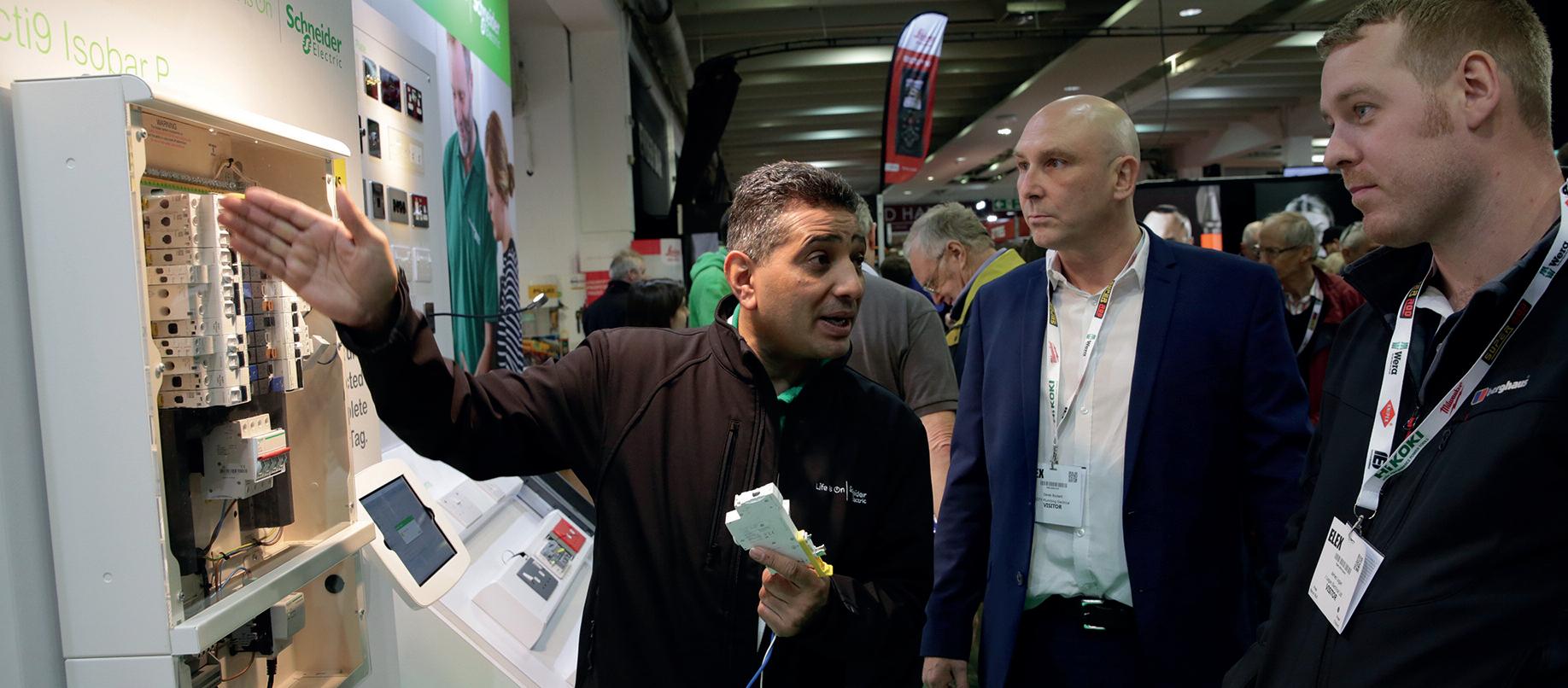






R E G I S T E R F O R F R E E AT W W W. E L E X S H O W. I N F O THE HANDS-ON TRADESHOW FOR PROFESSIONAL ELECTRICIANS 1000’S OF SHOW DEALS ● TOP ELECTRICAL BRANDS ● FREE CPD SEMINARS ON WIRING REGS AMENDMENT 2, CIRCUIT PROTECTION, EICRs, EV CHARGING AND MORE ● FREE ENTRY ● FREE PARKING ● FREE PROFESSIONAL ELECTRICIAN T-SHIRT ● FREE BACON ROLL F O RT H C O M I N G S H O W S : ELEX SHOW PROFESSIONAL ELECTRICIAN The Electricians’ Exhibition Sponsored by CBS ARENA COVENTRY CBS ARENA COVENT RY 14TH & 15TH SEPTEMBER 2023 WESTPOINT EXETER WESTPOINT EXETER 27TH & 28TH SEPTEMBER 2023 SANDOWN PARK SURREY SANDOWN PARK SURREY 2ND & 3RD NOVEMBER 2023






































































































































































 BROWSE THE SONEL PVM-1020 PRODUCT DATA SHEET AT: WWW.RDR.LINK/EAT024
BROWSE THE SONEL PVM-1020 PRODUCT DATA SHEET AT: WWW.RDR.LINK/EAT024
































































































